#(even the ones she described in great detail for the purpose of distinguishing)
Explore tagged Tumblr posts
Text

Books of 2025: DARLING by K. Ancrum.
I didn't mean to binge this in a sitting and a half on a Sunday afternoon, but that's heat advisories for you, I guess. Hello, Contemporary Peter Pan Retelling, and WHAT a gorgeous cover you have.
I read somewhere that this is a super faithful adaptation (like. Beat by Beat fidelity with the source material), which seemed like a neat trick given how utterly Contemporary this was versus the magic of the original. Admittedly, I haven't revisited that source material in many years, but I was pleasantly surprised by how many specifics came back to me as I read through Ancrum's adaptation--Peter's shadow became a jacket, the Mermaid's Lagoon became a drag bar (staffed, yeah, by mermaid-themed queens), flying was scaling Chicago trellises, pirates were cops, etc. Tink (beloved) was there, Nana was there, the Crocodile was there, Detective Hook (begrudgingly beloved) was there, and also there was an ace Russian boy and I love ace Russian boys (iykyk).
I thought Ancrum did a good job keeping the classic children's story tone intact despite the (brutal, brilliant, Holy Shit!!) twist. Although it didn't initially send me, the straightforward, clean prose anchored me to the source story, and by the end I was firmly sold on "good stylistic choice." Overall I had fun!! Planning to revisit it with the source text in the other hand sometime, just to see.
#books#book reviews#books of 2025#darling#k. ancrum#book photos#anyway! i definitely was hyped for this since literally the pub weekly announcement#i remember reading about it in my cube at my LAST job before ronatimes#i definitely preordered it as soon as physically possible.#and then it. languished. on my shelf. for *checks watch* four years 🫥🫥#Doing Our Best Over Here lmfao#also also. i was interested because i have a fairy tale retelling project too and i wanted to see what ancrum did#i do think I'll revisit this but ill revisit it and the source text In Tandem because im curious and i want to take it apart 👀👀#good time. glad its on my shelf!#i will say though. some of the descriptions werent working for me?? and i could not for the life of me distinguish the lost boys#(even the ones she described in great detail for the purpose of distinguishing)#i think its the abundance of was/were type descriptions#and the fact that those descriptions were usually bricked and not woven into the narration. and happened all at once really early on/quick#i mean the prose was Fine but it wasnt shiny. and it was a lot of standalone descriptions divorced from context/movement/meaning#i do want to see the OG text again to see if thats intentional (i suspect it might be?). and it didnt turn me off her writing forever but#it makes me cautious about icarus#(i do still think ill give icarus a shot)
13 notes
·
View notes
Text
Japanese notes - lesson 1 (30/5/2022)
The purpose of this writeup is primarily to help cement it in my brain, but I will put it up here in case it’s of interest to other people!
I am studying Japanese with a friend, she’s not a native speaker but has had formal teaching and is a lot further along than I am. For her this is an opportunity to cement the basics and enthuse about languages with someone, and I’m going to repay her in kind through animation work somewhere down the line.
Today the main thing we did (beyond simply chatting about Japanese, what I already know, what the long term goal is) was read the Genki - An Integrated Course in Elementary Japanese textbook. We started right from the beginning and alternated reading out passages, which helped rein in our ADHD habits lol, and my friend gave me detailed feedback on pronunciation and speaking in general, which was incredibly valuable, the thing I’ve been wanting for years.
I went in knowing hiragana pretty well (at least to read, not so much to write) and reading about 60-70% of katakana when I tried a quiz. I need to learn the rest of the katakana asap. (Actually, reading manga and paying attention to the onomatopoeia has been pretty good practice for reading katakana! But it has gaps.) I’m going to practice writing the kana as well. We want to do away with romaji as soon as possible lol.
Here are some things I made a note of during the lesson:
pronouncing らりるれろ - this has been a persistent headache with me but in fact a brief bit of feedback on my friend got me on the right track and i was doing pretty well by the end.
the trick is that your tongue should tap the ‘alveolar ridge’, a hard bit of the roof of the mouth behind the teeth. it feels to me very slightly forward of where it taps in an ‘r’ or ‘l’ sound and importantly, you don’t move your lips nearly as much as you do in English.
pronouncing ふ - this one was interesting because i hadn’t realised it’s actually a bit different from the english ‘f’ sound so it took a lot of tries. the major thing is that the lips don’t meet; i also have a note saying “less plosive”. my friend described it as being something like halfway between the English ‘h’ sound and the English ‘f’ sound.
Edit: just advised this is called the voiceless bilabial fricative!
pronouncing わ and を - Also not exactly like the English ‘w’. Lips don’t move too much. “Don’t move your lips too much” is something of a running theme.
dropping the -u sound - I was aware that in some circumstances, such as です and -ます, you drop the ‘u’ sound, but my friend gave me the actual rule.
The ‘u’ sounds in す and つ and ‘i’ sounds in し and ち can be dropped at the end of words, or in between ‘hard’ consonants which include ‘s’ and ‘k’ sounds such as in 好き suki or 明日 ashita. In these cases you drop the u sound (it becomes unvoiced). apparently this can vary with dialect and doesn’t happen as much in kansai-ben.
pitch accent and cadence - we haven’t started on pitch accent patterns or anything like that yet, but my friend was getting me to try and get the cadence and pitch right when i echoed stuff back to her and i could tell it made a huge difference.
Here’s what I was already aware of: Japanese is not a stress-accent language like English, and you pronounce each mora with generally very regular cadence and stress (though my friend added here that this can actually vary a bit with dialect). However, it does have pitch-accent, so you have pitch that rises or falls at certain points, and this is more important than English stress-accent because words can be homophonic up to pitch accent so getting it wrong will sound weird and confusing. (It’s not a tonal language like Chinese, context is still the main clue to distinguish homophones, but it’s not unimportant either.)
One thing to know it, another to put it into practice. This was quite hard for me to get at first since even when I could hear the pattern, I haven’t learned to sing and I don’t have great pitch control, but I definitely think I was getting the hang of it by the end of the lesson - it was really really helpful being able to just try a word over and over with my friend on the call until I started to get the hang of it. Next time we’re going to watch anime very slowly and echo line by line and I’m looking forward to that a lot.
We talked about saying 私 watashi, something demonstrated in this video by Dogen. Actually my notes seem to be a bit inconsistent with what Dogen says here, so I think I got confused about something, because my notes say it has a falling pitch at the end and that doesn’t seem to be true. Anyway I added a browser extension that adds pitch accent info to jisho.org, so I’ll be able to practice saying things right when I look them up now.
One thing that is interesting is that thinking about pitch accent and cadence, although at first taking a lot of concentration, actually helped me think about speaking in a different way. I was doing decently when I was in that zone, but when I read a Japanese word in the middle of a passage of English text it was like my brain didn’t switch tracks quick enough and I read it in an English style. so that’s kind of cool to see even at this early stage. I can see just why Dogen can go from sounding like a Japanese person to having a very American accent so suddenly.
stroke order - my friend explained there is a general pattern (with exceptions inevitably) to stroke order, so it’s not as brutal as it looks at first.
as i understand it the ‘algorithm’ is something like, you group the strokes into radicals, and then for ordering the radicals overall, and ordering the strokes within a radical, you start from the top left and go left to right, then top to bottom. that still leaves some ambiguity but you’ll learn the specific patterns, e.g. if you’re drawing a box-shaped radical you tend to draw the left vertical, then the top and right sides as one stroke, then the bottom stroke, so if you see a radical like that in a kanji you can usually expect it to go like that.
we watched some amusing videos by NativLang talking about the ridiculous complexity of the Japanese writing system. but like, kids can learn this stuff, adults can learn this stuff, if I put the time in I’ll get there.
aizuchi - as we were approaching the conversation and grammar section, my friend mentioned 相槌 aizuchi, words like なるほど and 本当に (ほんとうに) which you use to show you’re listening in a conversation. I imagine we’ll cover those in detail at some point.
aisatsu - this was the very first part of the vocab section. the book actually had some cute little illustrations for each one:

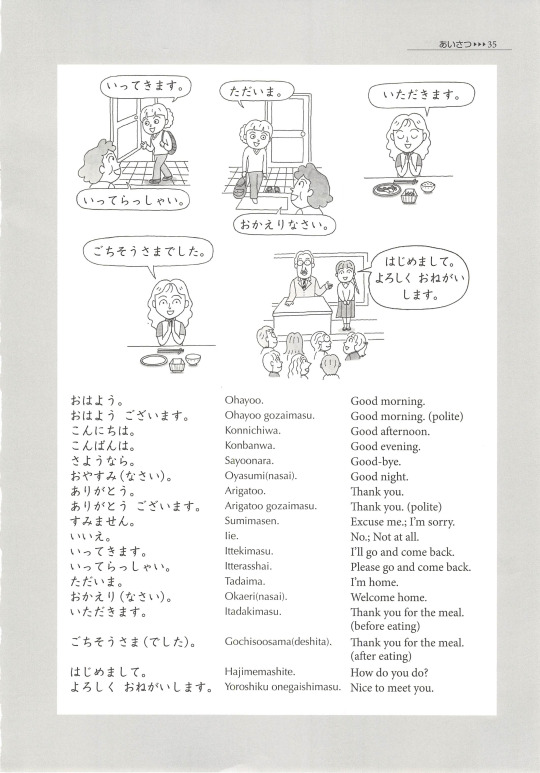
the illustrations are a great way to give meaning to the words without parsing them through English.
a lot of these I was aware of thanks to anime, but a couple likeいってきます/ごちそうさまwere new to me, and of course it was very useful to get help pronouncing them.
a couple that came up which weren’t in the book: if someone thanks you (ありがとう), some of the responses you might give depending on context are:
こちらこそ - essentially, “no, thank you”
なんでもない - “it’s nothing”
I didn’t write this down but I think she said you might even apologise. Perfect language for me I guess ;p
watching anime: We watched a couple of episodes of かげきしょうじょ!! Kageki Shōjo!!, an anime about a fictionalised Takarazuka school. Unlike Revue Starlight it’s a lot more grounded and more overtly alluding to the real Takarazuka Revue (with reference to specific performances like Rose of Versailles, the troupe system, students expected to clean the halls...); the wish to be Top Star is one source of conflict but characters are aspiring to e.g. be otakuyaku and musumeyaku and not merely the Top Star, but also the gender aspect is played up as well with the MC wanting to be in an all-women environment after ordeals with fans during her idol career.
This was just a wind down this week, but I did my best to try to listen to the dialogue and not just read subs. Right now I guess I’m at a stage where I will keep catching random words like “I know that one” but don’t have the grammar knowledge to really fit them together yet. Next week we’re going to watch it back much slower and listen closely to the dialogue.
using Anki: @baeddel showed me how to set up Anki while I was at hers, so the next step for me is to put some version of all this new information in there and see if the magic of Spaced Repetition can pack it into the folds of my brain.
19 notes
·
View notes
Note
I like Venti so much. Best boy.
How would Venti feel about an S/O with synesthasia. The ability to hear color. One day she goes to him performing on the street with a sketchpap and shows him what he sounds like.
My, my, look who it is. The person who started it all, and ending it. It's amusing how this came full circle and of course you bring me such an interesting yet difficult prompt *balls fist, shakes at sky*
I had a lot of time to think about this and I feel it was still so hard to make. And there's so many variants and uniqueness to each case so this will be a wild ride. But this marks the end of this special event and on to a new one, and I thank you especially for being with me through it!
This fic made me realize I need a better Venti banner lololol
Ethereal Hues
Venti with a Reader with Synesthesia (Specifically, the ability to see sounds)

The wind-borne bard fancies audiences that sings along, that joins him in his merry tunes. He knows faces, distinguishes them, reads their responses. If it was unorthodox tales he sang, he would laugh at the predicted angry churns. If it were awesome tales of adventures, Venti would bask in the glory of awe and cheers.
And so he finds you to be the most peculiar individual he has ever audienced. You stand in the back far away from the crowd as you carry with you a notebook. Based on the way you steal glances to him whenever he performs out in public and the way your hands moved, you were definitely sketching him, yet you paid no such expression for his songs the same way the others did. And he was sure you were no deaf individual.
He had been intrigued since day one, and he had been so even at the third. When he wishes to come to you, he would always find you packing up immediately after his performances, and he would be swept aside by the task at hand: getting his share of Mora for a fantastic performance.
You were only there for his music, and your interest seem to disappear the moment the music is lost.
So slowly he would adjust his schedule, making it so his songs linger longer, his notes stretching out more just to keep you there in his vision for longer. And yet whenever he privies himself to have caught your attention, it seems as tho you were not really interested at him: even if the distance between you were great, he knows you were looking through him.
This game of cat and mouse had stretched out to seven days.
You managed to attend every tale the bard tells within the walls of Mondstadt but never have you stepped foot inside the tavern of Angel’s Share when he would perform late at night. With this discovery, he doesn’t bother to try lure you out from there, opting to skip performing in the tavern.
Much to Diluc’s surprise. It had gone so that the bartender himself asked if things were not looking great for the bard, but he was met by a smug and conniving smile, that he was quick to smack the shit out of and never bother about again.
Every time the bard wishes to approach you after the last string of his lyre is plucked, he was blocked by the crowd or pulled by a child, enough to render him unmoving, enough of a timeframe for you to disappear. You would think it was you purposely evading the bard’s advances but the way you move and act doesn’t seem like you were running away or in a hurry, more so, you look more disappointed that the festivities had to end every time.
A week of disappointments had led Venti to play his sorrows to his lyre under the tree at Windrise. It was a tune that no one in the public eye has seen him play and he was content in indulging on his own misery.
“Eyes from the fountain bench, of a longing stare had whence.
Slip between thy grasp, even as I call out through a rasp.”
“Ah, a different one this time,” he’d almost fallen out of the branch he was hanging by when a voice suddenly spoke out from beneath the tree’s shade. And there you are in all your glory, an amused expression in your face as you watch the Anemo wielder catch himself before gracefully flying down in front of you in disbelief. “Hello.”
“Hi!” He squeaked out before clearing his throat, adjusting his posture to reflect his usual composed facade with that wide grin.
“The colors brought me here, but I didn’t expect you to be the one producing them.” He watched you fumble with the familiar sketchbook in your hand, his muse in his curiousities right in front of him nonchalantly, as if fate had not been trying its best to separate them for the past week. "With the collection complete, I can finally show you the whole thing!" You practically shoved the pad to his face, forcing him to step back.
And there he saw the most ethereal painting he had seen of himself. His lone form in front of the statue where he usually plays, there in his company were streaks of light blue, reminiscent of Barbara's elemental skill. He clutches the pad for a better look as he notices more blots of complementary colors littered in ecstatic manners. Below, the words 'glee' was written in dark cursive.
Next page had warmer colors, that wrapped around him like silk and satin which would then plunge to the floor like cold white mist. This one was labelled 'Comfort.'
There were four more illustrations that depict numerous vibes of his tunes whenever he had performed, and paired with it comes different colors and patterns. Each one was more detailed than the last and with new vigor he was more than eager to see the next ones—
And then the last one was the latest, where he was once singing his odes and woes from the tree's branches. Yet this one holds a different gesture to it and he sucks in the details with a faraway gaze. Black, gray and navy blue hang like curtain as it seemingly seeps from his flesh, tangling into a weightless form before diverging into a single string of black that casts itself past the borders of the paper. It was like shadows that desperately cling to its owner, ones sadness and desperation taking form into a monster that seeks a vessel.
He looks up to you with eyes once again shining at the brilliance of the illustrations- before he clutched the pad to his chest, a toothy grin and a dangerous glint in his teal eyes, "I'm keeping this~"
To hell with that.
First he takes your sketchpad and rifts through it like there's no tomorrow, and then he lays claim on it?! The audacity of this bard!
With the only arsenal that you had, you started throwing brushes and acrylics at the floating bard until he had to crash land from getting caught by his extravagant cape. What an oversight.
That day, you'd finally sit down with the famous bard and properly got to introduce each other. While you're ecstatic to chat with the person you'd long admired from afar, Venti was more ecstatic at the idea of you and your marvelous power. It's similar to elemental sight, he imagines, and he pried with more inquiries than you had anticipated.
You thought he'd be weirded out by both your colorful sense or the fact that you had stalked him for a week to immortalize his ethereal glow in the shadows.
Yet he was so open-minded about it, wanting to accompany you more on your endeavors and jokingly using you as his marketing manager for more Mora opportunities. You find the idea not so bad.
At one point in time without your knowledge nor acknowledgement, Venti (ever so curious boy) changed his form from his bard friend to copy yours, trying to see if he were able to replicate your vision. Alas it was not as easy as that. Whatever Venti did after that, not even Celestia knows.
Your ability to see the streams of music instead of just projecting associated shapes and colors had made it easy to find Venti, and vice versa.
When he wants to find you specifically, Venti sings your name in a lilting melody as he walks through the stone streets of Mondstadt, the blazing color pouring through your window as you crane your head out and look him down from the second floor.
Venti's invisible aura brightens at the sight of you and he presents the fresh Cecilias in his hand, singing for you to accompany him to another day and you're forced to do so with his cheesiness.
He continues to sing even as you resign to your home to prepare. Unbeknownst to you the people of Mond watched with wonder and awe at the sweetness of the serenading bard that comes by every 9 AM daily to your doorstep.
Nature rarer uses yellow
Than another hue;
Saves she all of that for sunsets, —
Prodigal of blue,
Spending scarlet like a woman,
Yellow she affords
Only scantly and selectly,
Like a lover's words.
You tilt your head at Venti at his lyrics, its lines influencing the color that coats him before his lyre finally calms its strings. He does not expand on his words as the silent conversation ended with a smile. Venti had been making songs with colors incorporated in them and despite the Muse of hues, you have yet to understand what they truly mean. If they mean anything at all.
You wish you could bring about the same flowery words to describe how beautiful Venti is, your current muse, adorned with the colors of a world only you can see. But for now, as you watch him smile past the crowd and lock eyes with yours, the most you can do is immortalize his ethereal hues. Until you finally work up the courage to admit it was not the colors that had drawn you to him.

This is a blessed day as it marks the end of the 50 followers event, and start the 100 followers one! Thank you for joining us in this journey, we still have a long way to go!
#genshin impact#genshin impact oneshots#genshin impact imagines#exile.flower#genshin impact venti#venti#venti x reader#followers special#i feel emotional ending this event#stay strong author stay strong#genshin impact x reader#gender neutral
285 notes
·
View notes
Text
My giant goes with me wherever I go: a study of the geographic metanarrative of folklore
This topic has been rattling around in my brain ever since I first heard folklore and I think it’s endlessly fascinating. Cue this lengthy but (hopefully) intriguing piece.
I’m afraid the title may not be an accurate reflection of this essay’s content, so here’s a preview of talking points: geography, existence, metanarrative, making sense of the theme of death, the “peace”/“hoax”/“the lakes” trio, history/philosophy, and exactly one paragraph of rep/Lover analysis (as a treat).
I make the standard disclaimer that analysis is by definition subjective. Additionally, many thanks and credit to anyone else who has written analysis of folklore. I am sure my opinions have been influenced by yours, even subconsciously.
Questions, comments, and suggestions are always welcome, and thank you for taking the time to read :)
——
“Traveling is a fool’s paradise. We owe to our first journeys the discovery that place is nothing. At home I dream that at Naples, at Rome, I can be intoxicated with beauty and lose my sadness. I pack my trunk, embrace my friends, embark on the sea, and at last wake up in Naples, and there beside me in the stern Fact, the sad self, unrelenting, identical, that I fled from. I seek the Vatican, and the palaces. I affect to be intoxicated with sights and suggestions, but I am not intoxicated. My giant goes with me wherever I go.”
Ralph Waldo Emerson
——
If Taylor Swift’s music is anything, it is highly geographic. Taylor has been a country, pop, and now alternative artist, yet a storyteller through and through—one with a special knack for developing the aesthetic of songs and even entire records through location. The people and places she writes about seem to mutually breathe life into each other.
It is plausible that Taylor, as a young storyteller, developed this talent by using places as veritable muses just like she did anything else. Furthermore, her confessional storytelling became much more geographic as she shifted to pop because of factors including (though certainly not limited to) purchasing real estate, traveling more, writing in a genre that canonically centers coastal cities, and dating individuals with their own established homes. The geographic motif in her work is so identifiable that all of the corresponding details are—for better or worse—commensurate to autobiography.
However, folklore is not autobiographical in the way that most understand her other albums to be. The relationship between people and places in folklore is likewise much less symbiotic.
The first two songs on the record illustrate this. We are at bare minimum forced to associate the characters of Betty and James with New York: the lyrics about the High Line imply a fraction of their relationship took place in this city. Even so, this does not imply Betty or James ever permanently resided in New York, or that Betty is in New York at the moment she is narrating the story of “cardigan.” Taylor places far more emphasis on James and the nostalgia of youth, with “I knew you” repeated as a hook, to develop the emotional tone of the song. Rhode Island also comes to life in “the last great american dynasty” because of Rebekah Harkness’ larger-than-life character. But Taylor, following Rebekah’s antagonism, states multiple times throughout the song that the person should be divorced from the place. folklore locations are never so revered that they gain the vibrancy of literal human life. Taylor refrains from saying a person is a place in the same way that she has said that she is New York or her lover is the West Village.
For an album undeniably with the most concrete references to location, it is highly irregular—even confusing, given that personification is such a powerful storytelling device—that Taylor does not equate location with personal ethos.
Regurgitating the truism that geography equals autobiography proves quite limiting for interpreting Taylor’s work. How, then, should geography influence our understanding of folklore?
I submit that the stories in folklore are not ‘about’ places but ‘of’ places which are not real. Taylor’s autobiographical fiction makes the settings of the songs similarly fictionalized, metaphorical, and otherwise symbolic of something much more than geography. It is this phenomenon which emotionally and philosophically distinguishes folklore from the rest of her oeuvre.
——
As a consequence of Taylor’s unusual treatment of location, real places in folklore become signposts for cultural-geographic abstractions. Reality is simply a set of worldbuilding training wheels.
Prominent geographic features define places, which define settings. The world of folklore is built from what I’ve dubbed as four archetypal settings: the Coastal Town, the Suburb, the City, and the Outside World.
Each has a couple defining geographic features:
Coastal Town: water, cliffs/a lookout
Suburb: homes, town
City: public areas, social/nightlife/entertainment venues
The Outside World serves as the logical complement of the other three settings.
Understanding that real location in folklore is neither interchangeable nor synonymous with setting is crucial. Rhode Island is like the Coastal Town, but the two settings are not one and the same. The Suburb is an idyllic mid-America setting like Nashville, St. Louis, or Pennsylvania; it is all of those places and none of them at the same time. The City may be New York City, but it is certainly not New York City in the way that Taylor has ever sung about New York City before. The Outside World is just away.
Put simply, folklore is antithetical to Taylor’s previous geographic doctrine. While we are not precluded from, for instance, imagining the City as New York City, we also cannot and should not be pigeonholed into doing so.
Note:
This album purports to embody the stereotypically American folkloric tradition. “Outside” means “anywhere that isn’t America” because the imagery and associations of the first three cultural-geographic settings indeed are very distinctly American.
While Nashville and St. Louis are relatively big cities, they are still orders of magnitude smaller than New York and LA, the urban centers that Taylor normally regards as big cities. In context of this essay, the former locations are Suburban.
In this essay, the purpose of the term ‘of’ is simply to replace the more strict term ‘about.’ ‘Of’ denotes significant emotion tied to a place, usually because of significant time spent there either in the past or present (tense matters). Not all songs are ‘of’ places—it may be ambiguous where action takes place—and some songs can be ‘of’ multiple places due to location changing throughout the story. (This does not automatically mean that songs with more than one location are ‘of’ two places. A passing mention of St. Louis does not qualify “the last great american dynasty” as ‘of’ the Suburb, for example.)
Each of the four archetypal settings must instead be understood as an amalgam of the aesthetics of every real location it could be. Setting then exists in conversation with metaphor because we have a shared understanding of what constitutes a generic Suburb, City, or Coastal Town.
Finally, by transitivity, the settings’ metaphorical significance entirely hinges upon the geographic features’ metaphorical significance. This is what Taylor authors.
The next part of the essay is concerned with deciphering geography in folklore per these guiding questions: how is an archetypal feature used as a metaphor? By proxy, what does that say about the setting defined by it? What theme, if any, unites the settings?
The Coastal Town: Water and Cliffs
The Coastal Town is defined by elemental features.
The first (brief) mentions of water occur on the first two tracks:
Roarin’ twenties, tossing pennies in the pool
Leavin’ like a father, running like water
“the last great american dynasty” introduces the setting to which the pool (water) feature belongs, our Rhode Island-like Coastal Town. It also incorporates a larger water feature, the ocean, and suggests the existence of a lookout or cliffs:
Rebekah gave up on the Rhode Island set forever
Flew in all her Bitch Pack friends from the city
Filled the pool with champagne and swam with the big names
//
They say she was seen on occasion
Pacing the rocks, staring out at the midnight sea
“seven” and “peace” also have brief mentions of water; however, note that these songs remain situated as ‘of’ the Suburb. (More on this later.)
I hit my peak at seven
Feet in the swing over the creek
I was too scared to jump in
But I’m a fire and I'll keep your brittle heart warm
If your cascade, ocean wave blues come
“my tears ricochet” and “mad woman” with their nautical references pertain to the water metaphor:
I didn’t have it in myself to go with grace
And so the battleships will sink beneath the waves
Now I breathe flames each time I talk
My cannons all firin’ at your yacht
“epiphany” also counts, though with the understanding of “beaches” as Guadalcanal this song is ‘of’ the Outside World:
Crawling up the beaches now
“Sir, I think he’s bleeding out”
“this is me trying” and “hoax” reiterate the cliff/lookout geography:
Pulled the car off the road to the lookout
Could’ve followed my fears all the way down
Stood on the cliffside screaming, “Give me a reason”
Finally, “the lakes” features both water and cliffs:
Take me to the lakes, where all the poets went to die
//
Those Windermere peaks look like a perfect place to cry
//
While I bathe in cliffside pools
With my calamitous love and insurmountable grief
In folklore, water dovetails with permanent loss.
“epiphany” is the most egregious example. Crawling up the beaches of a war zone proves fatal. “the lakes” describes grieving in water, perhaps for the loss of one’s life because there exist cliffs from which to jump. “this is me trying” and “hoax” mirror that idea. On the other hand, in “peace,” death does not seem to have any connection to falling from a height.
Loss can also mean loss of sanity, such as with the eccentric character of Rebekah Harkness or Taylor as a “mad woman” firing cannons at (presumably) Scooter Braun’s yacht.
Subtler are the losses alluded to in “my tears ricochet” and “seven,” of identity or image and childhood audacity, respectively. And in the opening tracks water is at its most benign, aligned with loss of a relationship that has run its course in one’s young adulthood.
The most fascinating aspect of water in folklore is that it is an aberration from water as the symbol for life/birth/renewal, derived from maternity and the womb. folklore water taketh away, not giveth.
As of now, the greater significance of the Coastal Town—the meaning to which this contradiction alludes—remains to be seen.
The City: Nightlife, Entertainment, and Public Areas
Preeminent in Taylor’s pop work is the City; New York City, Los Angeles, and London are the locations most frequently extolled as Swiftian meccas. This archetypal setting is given a more understated role in folklore.
“cardigan,” ‘of’ the City, illustrates this setting using public environments and nightlife:
Vintage tee, brand new phone
High heels on cobblestones
//
But I knew you
Dancin’ in your Levi’s
Drunk under a streetlight
//
I knew you
Your heartbeat on the High Line
Once in twenty lifetimes
//
To kiss in cars and downtown bars
Was all we needed
“mirrorball” paints the clearest picture of the City’s nightlife/social venues by sheer quantity of lyrics:
I’m a mirrorball
I’ll show you every version of yourself tonight
I’ll get you out on the floor
Shimmering beautiful
//
You are not like the regulars
The masquerade revelers
Drunk as they watch my shattered edges glisten
//
And they called off the circus, burned the disco down
“invisible string” briefly mentions a bar:
A string that pulled me
Out of all the wrong arms, right into that dive bar
In addition, “this is me trying” implies that the speaker may currently be at a bar, making the song partially ‘of’ the City:
They told me all of my cages were mental
So I got wasted like all my potential
//
I was so ahead of the curve, the curve became a sphere
Fell behind all my classmates and I ended up here
Pouring out my heart to a stranger
But I didn’t pour the whiskey
It goes almost without saying that the City at large is alcohol-soaked. Indeed, alcohol will help us understand this location.
Each of the aforementioned songs has a distinct narrator, like Betty in the case of “cardigan” or Taylor herself, at the very least in the case of “mirrorball” or at most all songs besides “cardigan.” And because the narrative character is so strong, I posit that the meaning of this geography is tied to what alcohol reveals about the speakers of the songs themselves.
“invisible string” and “mirrorball” are alike in the fact that the stories extend well beyond or even completely after nightlife. Meeting in a dive bar in “invisible string” is just the catalyst for a relationship that feels fated. Taylor, in her “mirrorball” musing, expresses concern about how she is perceived by someone close to her. Does existing after the fact (of public perception, at an entertainment venue) constitute an authentic existence? Alcohol, apparently a necessary part of City life, predates events which later haunt the speakers. Emotional torment is then what prompts the speakers to recount their stories.
On the other hand, alcohol directly reveals the emotional states of the speakers in “cardigan” and “this is me trying.” “cardigan” is Betty’s sepia-toned memory of her time with James, in which James’ careless, youthful spirit (“dancin’ in your Levi’s, drunk under a streetlight” and “heartbeat on the High Line”) inspires sadness and nostalgia for their ultimately temporary relationship (“once in twenty lifetimes”). “this is me trying” is tinged with the speaker’s bitterness; hopelessness and regret lead them to the bar and the destructive practice of drinking just to be numb.
These observations suggest that the City is also a site of grief or loss, though not for the same reason that the Coastal Town is. Whereas the Coastal Town is associated with a permanent ending such as death, the City reveals an ending that is more transitional and wistful, tantamount to a coming of age. There is a clear ‘before’ and ‘after’ to loss related to the City: life, though changed, goes on.
The Suburb: Homes and Towns
Noteworthy though the City and Coastal Town may be, the former in particular concerning the pop mythology of Taylor Swift, it is the Suburb which Taylor most frequently references in folklore and establishes as the geographical heart of the album.
The Suburb is defined by a home and town. A “home” encompasses entrances (front/side doors), back and front yards (gardens/lawns/trees/weeds/creeks), and interiors (rooms/halls/closets). The “town” is pretty self-explanatory, with a store, mall, movie theater, school, and yogurt shop.
Observe that the folklore Suburb is the aesthetic equivalent of the “small town” that provided the debut and Fearless albums’ milieu and inspired the country mythology of Taylor Swift. While Taylor primarily wrote about home and school on those albums (because, well, that was closer to her experience as a teenager), the “small town” and the folklore Suburb are functionally the same with regard to pace, quality, and monotonicity of life. Exhibit A: driving around and lingering on front doorsteps are the main attractions for young adults. (From my personal experience growing up in a Suburb, this is completely accurate. And yes, the only other attractions are the mall and the movie theater.)
The Suburb becomes a conduit for conflict.
Conflict that Taylor explores in this setting, including inner turmoil, dissension between characters, and friction between oneself and external (societal) expectations, naturally can be distinguished by distance [1] between the two forces in conflict. As an example, ‘person vs. self’ implies no distance between the sides because they are both oneself. ‘Person vs. society’ is conflict in which the sides are the farthest they could conceivably be from each other. Conflict with greater distance between the sides is usually harder to resolve. One must move bigger mountains, so to speak, to fix these problems.
The folklore Suburb is additionally constructed upon the notion of privacy or seclusion. We can imagine a gradient [2] of privacy illustrated by Suburban geography: the town is a less intimate setting than the outside of the home, which is less intimate than the inside of the home.
I combine these two ideas in the following claim: the Suburb relates distance between two forces in conflict inversely on the geographical privacy gradient. Put simply, the more intimate or ‘internal’ the setting, the farther the two sides in conflict are from each other.
(I offer this claim in the hopes that it will clarify the nebulous meaning of the Suburb in the next section.)
Salient references to the Suburban town can be divided into one of two categories:
Allowing oneself to hope
Allowing oneself to recall
“august” clearly belongs in the first category. Hope is central to August’s character and how she approaches her relationship with James:
Wanting was enough
For me, it was enough
To live for the hope of it all
Canceled plans just in case you’d call
And say, “Meet me behind the mall”
If we interpret the bus as a school bus then “the 1” also belongs in this first town category:
I thought I saw you at the bus stop, I didn’t though
//
I hit the ground running each night
I hit the Sunday matinee
“invisible string” indicates that the yogurt shop is equally innocent as Centennial Park. The store represents the hope of Taylor’s soul mate, parallel to her hope:
Green was the color of the grass
Where I used to read at Centennial Park
I used to think I would meet somebody there
Teal was the color of your shirt
When you were sixteen at the yogurt shop
You used to work at to make a little money
“cardigan” and “this is me trying” alternatively highlight the persistence of memory, with a relationship leaving an “indelible mark” on the narrators. These songs belong in the second category:
I knew I’d curse you for the longest time
Chasin’ shadows in the grocery line
You’re a flashback in a film reel on the one screen in my town
James’ recollection qualifies “betty” for the second category as well. This song shows that emotional weight falls behind the act of remembering:
Betty, I won’t make assumptions
About why you switched your homeroom, but
I think it’s ‘cause of me
Betty, one time I was riding on my skateboard
When I passed your house
It’s like I couldn’t breathe
//
Betty, I know where it all went wrong
Your favorite song was playing
From the far side of the gym
I was nowhere to be found
I hate the crowds, you know that
Plus, I saw you dance with him
The surprising common denominator of these two categories is that conflict is purely internal in public spaces. Regardless of whether the speakers feel positively or negatively (i.e. per category number), their feelings are entirely a product of their own decisions, such as revisiting a memory or avoiding confrontation. This gives credence to the theory that the Suburb inversely relates conflict distance with privacy.
On the other extreme, the home is a site of conflict larger than oneself, and often more conflict in general. Conflict which occurs in the most private setting, inside the house, is conflict where the two sides are most distanced from each other. Conflict near the house, though not strictly inside, is closer, interpersonal.
“my tears ricochet” is just an ‘indoors’ song. The opening line depicts a private, funeral-like atmosphere:
We gather here, we line up, weepin’ in a sunlit room
There are multiple interpretations of this song floating around. The two prevailing ones are about the death of Taylor Swift the persona and the sale of her masters. In either interpretation, society and culture are the foundation for the implied conflict. First, the caricature of Taylor Swift exists as a reflection of pop culture; second, the sale of global superstar Taylor Swift’s masters is a dispute of such magnitude that it is not simply an interpersonal squabble.
For the alternative interpretation that “my tears ricochet” is about a dissolved relationship, “and when you can’t sleep at night // you hear my stolen lullabies” implicates Taylor Swift’s public catalogue (and thus Taylor Swift the persona) as the entity haunting someone else, as opposed to Taylor Swift the former member of the relationship.
“mad woman” is just an ‘outdoors’ song because of the line about the neighbor’s lawn:
What do you sing on your drive home?
Do you see my face in the neighbor’s lawn?
Does she smile?
Or does she mouth, “Fuck you forever”
It’s clear Taylor has a lot of vitriol for Scooter Braun. Though it’s probably a bit of both at the end of the day, I am comfortable calling their feud more of the ‘person vs. person’ variety than the ‘person vs. society’ variety.
Consequently, the privacy gradient claim holds for both songs.
“illicit affairs” is one of two songs with a very clear ‘transformation’ of geography:
What started in beautiful rooms
Ends with meetings in parking lots
In context, this represents the devolution of the relationship. External conflict, the illegitimacy of the relationship, defined the affair when it was in “beautiful rooms.” Relocating to the parking lot (i.e. now referencing the Suburban town) coincides with discord turning inward. Any external shame or scorn for both lovers as a consequence of the affair is replaced by the end of the song with anger the lovers feel towards each other and, more importantly, themselves.
“seven” is the best example of how many types of conflict are present in and around the home:
I hit my peak at seven
Feet in the swing over the creek
I was too scared to jump in
//
And I’ve been meaning to tell you
I think your house is haunted
Your dad is always mad and that must be why
And I think you should come live with me
And we can be pirates
Then you won’t have to cry
Or hide in the closet
//
Please picture me in the weeds
Before I learned civility
I used to scream ferociously
Any time I wanted
The first few lines exemplify ‘person vs. self’ conflict, a fear of heights. The third segment introduces a ‘person vs. society’ dilemma, shrinking pains as a result of socialization into gender norms. (I am assuming that the child is a girl.) The second verse indicates strife between a child and a father. It leaves room for three interpretations:
The conflict is interpersonal, so the father’s anger is wholly or partially directed at the child because the father is an angry person
The conflict is sociological, so the father’s anger is a whole or partial consequence of the gendered roles which the father and child perform
Both
Is curious that we need not regard sadness and the closet in “seven” as mutually inclusive. The narrator says the child’s options are crying (logical) or hiding in the closet. Both the father’s temper and the closet are facts of the child’s life, either innocuous or traumatic or somewhere in between.
But we might—and perhaps should—go further and argue that conflict in “seven” is necessarily sociological, and specifically about being civilized to perform heterosexual femininity. For, taken to its logical extreme, if only gender identity and not sexual identity incites anger, then men must be socialized to become abusive to women, who must be socialized to become submissive to that abuse. Screaming “ferociously” at any time would also denote freedom to be oneself despite men, not freedom to be oneself for one’s own gratification. Yet the child surely enjoys the second freedom at the beginning of the song. While the patriarchy is indeed an oppressive societal force, the interpretation of the social conflict in “seven” as only gendered yields contradiction. This interpretation is much more tenuous than acknowledging that the closet is, in fact, The Closet.
(Mere mention of a closet, the universal symbol for hiding one’s sexuality, immediately justifies a queer interpretation of “seven” notwithstanding other sociological and/or semantic technicalities. A sizable chunk of Taylor’s extensive discography also lends itself to queer interpretation by extension of connection with this song—for instance, by a shared theme of socialization as a primary evil. To me it seems silly at best and homophobic at worst to eschew the reading of “seven” presented here.)
It is undeniable that “seven” represents many types of conflict and places them inversely on the privacy gradient. The father embodies societal conflict larger than the young child and introduces that conflict inside the house. The child faces internal conflict (i.e. a fear of heights) and no conflict at all (i.e. freedom to act fearlessly) outside.
Reconciling “august,” “exile,” and “betty” with the privacy gradient actually requires a queer interpretation of the songs. To avoid the complete logical fallacy of a circular proof, I reiterate that the privacy gradient is simply a means of illustrating how the Suburb functions as an archetypal location. Queer interpretation is a sufficient but not necessary condition for an interesting argument about Suburban spatial symbolism. Reaching a slightly weaker conclusion about the Suburb without the privacy gradient would not impact the conclusions about the other three archetypal locations. Finally, queer (sub)text is a noteworthy topic on its own.
“betty” situates the front porch as the venue where Betty must make a decision about her relationship with James:
But if I just showed up at your party
Would you have me? Would you want me?
Would you tell me to go fuck myself
Or lead me to the garden?
In the garden, would you trust me
If I told you it was just a summer thing?
//
Yeah, I showed up at your party
Will you have me? Will you love me?
Will you kiss me on the porch
In front of all your stupid friends?
If you kiss me, will it be just like I dreamed it?
Will it patch your broken wings?
Influencing Betty’s decision is her relationship with her “stupid” (read: homophobic) friends who don’t accept James (and/or the idea of James/Betty as a pair), her own internalized homophobia, and the trepidation with which she may regard James after the August escapade. The conflict at the front door is external/societal, interpersonal, and internal.
The garden differs from the front door as an area where James and Betty can privately discuss the August escapade. By moving to the garden, the supposed root of their conflict shifts from the oppressive force of homophobia to James’ behavior regarding the love triangle (“would you trust me if I told you it was just a summer thing?”). Much like in “illicit affairs,” motion along the privacy gradient underscores that micro-geography is inversely related to conflict distance.
Next, the implied settings of “august” are a bedroom and a private outdoor location such as a backyard:
Salt air, and the rust on your door
I never needed anything more
Whispers of "Are you sure?”
“Never have I ever before”
//
Your back beneath the sun
Wishin’ I could write my name on it
Will you call when you’re back at school?
I remember thinkin’ I had you
The backyard holds a mixture of ‘person vs. self’ and ‘person vs. person’ conflict. August’s doubts about James manifest as personal insecurities. However, James, by avoiding commitment, is equally responsible for planting that seed of doubt.
The song’s opening scene depicts a young adult losing their virginity. The bedroom can thus be conceptualized as a site of societal conflict because the queer love story expands this location to the geographical manifestation of escapism and denial. James runs off with August as a means to ignore externalized homophobia from a relationship with Betty, who has homophobic friends. Yet they eventually ditch August for Betty, either because of intense feelings for Betty or internalized homophobia—the relationship with August was too perfect, too easy.
“betty” and “august” are consistent with the gradient theory provided we interpret the love triangle narrative as queer. Identity engenders conflict in these songs. The characters then confront the conflict vis-à-vis location. ‘Indoors’ becomes the arena for confronting issues farther from the self, namely concerning homophobia. ‘Outdoors’ scopes cause and therefore possible resolution to individuals’ choices.
Last but not least, consider “exile,” the song with strange staging:
And it took you five whole minutes
To pack us up and leave me with it
Holdin’ all this love out here in the hall
//
You were my crown, now I’m in exile, seein’ you out
I think I’ve seen this film before
So I’m leaving out the side door
“I’m in exile, seein’ you out” and “I’m leaving out the side door” contradict each other. The speaker, “I,” seeing their lover out means that the speaker remains inside the house while their lover leaves. But the “I” also leaves through the side door. Does the speaker follow their lover out? If so, then whose house are they leaving? It is most likely a shared residence. They plan on coming back.
Taylor said in an interview [3] that the verses, sung by different people, represent the perspectives of the two lovers. The “me” in the first segment is the “you” in the second. So our “I” is left in the hall too. Both individuals in the relationship are implied to leave and stay at different times.
An explanation for this inconsistency lies in the distinction between doors. A front door in folklore is symbolic of trust, that which makes or breaks a relationship (see: Betty’s front door and the door in “hoax”). It also forces sociological conflict to be resolved at the interpersonal level, lest serious problems hang out in the open. Fixing the world at large is usually impossible, and so front doors only create more issues. (The mountains, as they say, are too big to move.) The main entrance is thus a site for volatility and high stakes.
“exile” suggests that a shared side door is for persistent, dull, aching pain. This door symbolizes shame which is inherent to a relationship. It forces the partners to come and go quietly, to hide the existence of their love. Inferred from a queer reading of “exile” is that it is homophobia that erases the relationship. Conflict with society as evinced in individuals is once again consistent with the staging at the home.
Note that few (though multiple) explanations could resolve the paradox between intense shame in a relationship and the setting of a permanent shared home. Racism, for example, may be a reason individuals hide the existence of a loving relationship. Nevertheless, the overall effect of Taylor’s writing is that it is believable autobiography. It is unlikely that she’s speaking about racism here, least of all because there are two other male characters in the song. So a slightly more uncouth name for “exile” would be “the last great american mutual bearding anthem.”
To summarize, the Suburb is an archetypal setting constructed upon the notion of privacy. Taylor makes the folklore Suburb the primary home (no pun intended) of conflict of all kinds. Through an intimate, inverse relationship between drama and constitutive geography, Taylor argues that unrest and incongruity are central to what the Suburb represents.
The Outside World
The final archetypal setting is the complement to the first three—a physical and symbolic alternative.
The Guadalcanal beaches in “epiphany” (which are also alluded to in “peace”) contrast the homeland in “exile” through a metaphor about war. The Lake District in England is opposite America, the setting of most of folklore. The Moon, Saturn, and India are far away from Pennsylvania, the setting of “seven.” India quantifies the lengths to which the speaker of the song would go to protect the child character, while astronomy abstracts the magnitude of the speaker’s love.
This archetypal setting is symbolic of disengagement and breaking free from limitations. Moving to India in “seven” is how the speaker and child could escape problems at the child’s home. Analogizing war with the pandemic in “epiphany” removes geographical and chronological constraints from trauma.
The Lake District is where Taylor, a poet, goes to die. The line “I don’t belong and, my beloved, neither do you” could also suggest that this location is where Taylor and her muse break free from being outcasts (i.e. they find belonging). Regardless, the Lake District is where she disengages from the ultimate limitation of life itself.
——
How is an archetypal feature used as a metaphor? By proxy, what does that say about the setting defined by said feature?
Analysis of each archetypal feature yielded the following:
The Coastal Town is representative of permanent loss/endings
The City is representative of transitional loss/endings
The Suburb is the site of character-defining conflict
The Outside World is freedom from the constraints of the other settings
What theme unites these settings?
Though the majority of songs in folklore are anachronistic, the album has a temporal spirit. Geography seems to humanize and animate folklore: the meanings of the settings mirror the stages of life.
(The theoretical foundation for this claim is a topology of being; that the nature of being [4] is an event of place.)
The City, characterized by transition, is the coming-of-age and the Coastal Town, characterized by permanent endings, is death.
The Outside World, an alternative to life itself, is hence a rebirth. (After all, Romantic poets experienced a spiritual and occupational rebirth upon retiring to the Lakes to die. We remember them by their retreat.)
Outwardly, the Suburb is ambiguous. It could be representative of adolescence or adulthood—before or after the City. Analysis shows that this setting is nothing if not complex. Adult Taylor writes about the Suburb as someone whose opinion of this setting has unquestionably soured since adolescence. Yet she also approaches the Suburb with the singular goal of creating nuance, specifically by exposing unrest and incongruity which the setting usually obfuscates. This setting, ironically one that is (culturally) ruled by haughty adolescents, is where she explores the myriad subtleties and uncertainties coloring adulthood. The Suburb thus cannot be for adolescence because James is 17 and doesn’t know anything. Taylor intentionally situates the Suburb between the City and Coastal Town as the geographic stand-in for a complicated adulthood.
Despite genre shifts, Taylor has always excelled at establishing a clear setting for her songs. She is arguably even required to establish setting more clearly for folkloric storytelling than for her brand of confessional pop. If we can’t fully distinguish between reality and fiction, we must be able to supplement our understanding of a story with strong characterization, which is ultimately a byproduct of setting. Geography is a prima facie necessity for creating folklore.
This further suggests that the ‘life story’ told through geography is the thing closest to a metanarrative of folklore.
I use this term to refer to an album’s overarching narrative structure which Taylor creates (maybe subconsciously) in service of artistic self-expression. Interrogating ‘metanarrative’ should not be confused with the protean, impossible, and distracting task of deciphering Taylor Swift’s life. True metanarrative is always worth exploring. Also, though some conclusions about metanarrative may seem more plausible than others, at the end of the day all relevant arguments are untenable. Only Taylor knows exactly which metanarrative(s) her albums follow, if any. It is simply worth appreciating that folklore allows an interesting discussion about metanarrative in the first place; that it is both possible to find patterns sewn into the fabric of the work and to resonate with that which one believes those patterns illustrate. I digress.
folklore is highly geographic but orthogonal to all of our geographic expectations of mood or tone. Through metaphor, Taylor upends our assumptions about the archetypal settings.
The Outside World is usually a setting which represents a brief and peaceful respite for travelers. Here, it is the setting for complete and permanent disengagement. Hiding and running away was a panacea in reputation/Lover, but in folklore, finding peace in running and hiding becomes impossible.
The City is usually regarded as a modern Fountain of Youth and, in Taylor’s work, a home. However, the folklore City’s shelter is temporary and its energy brittle, like the relationship between the characters that inhabit it. The City has lost its glow.
One would expect the Coastal Town to be peaceful and serene given its small size and proximity to water. Taylor makes it the primary site of death, insanity, permanent loss. The place where one cannot go with grace is hardly peaceful.
The Suburb is not the romanticized-by-necessity dead end that it is in a Bildungsroman like Fearless. Rather, it is the site of great conflict as a consequence of individual identity. The American suburb is monolithic by design; Taylor points the finger of blame back at this design for erasing hurt and trauma. By writing against the gradient of privacy, she obviates all simplicity and serenity for which this location is known. Bedrooms no longer illustrate the dancing-in-pjs-before-school and floodplain-of-tears binary. Front porches become more sinister than the place to meet a future partner and rock a baby. Characters’ choices—often between two undesirable options in situations complicated by misalignment of the self and the world at large—become their biggest mistakes. It is with near masochistic fascination that Taylor dissects how the picturesque Suburban façade disguises misery.
If we have come to expect anything from Taylor, it is that she will make lustrous even the most mundane feelings and places. (And she is very good at her job.) folklore is a departure from this practice. She replaces erstwhile veneration of geography itself with nostalgia, bitterness, sadness, or disdain for any given setting. folklore is orthogonal to our primary expectation of Taylor Swift.
Yet another fascinating aspect of folklore is the air of death. It’s understandable. Taylor has ‘killed’ relationships, her own image, and surely parts of her inner self an unknowable number of times. Others have tarnished her reputation, stolen her songs, and deserted her in personal and professional life. She perishes frequently, both by her own hand and by the hands of others. The losses compound.
I’ve lost track of the number of posts I’ve seen saying that folklore is Taylor mourning friendships, love, a past self, youth…x, y, z. It has literally never been easier to project onto a Taylor Swift album, folks! At the same time, it is very difficult to to pinpoint what, exactly, Taylor is mourning. To me, listing things is a far too limited understanding of folklore. The lists simply do not do the album justice.
Death’s omnipresence has intrigued many, and I assert for good geographic reason. Reinforcing the album’s macabre undertone is nonlinear spatial symbolism: each setting bares a grief-soaked stage of a single life. From the City to the Suburb, Coastal Town, and Outside World, we perceive one’s sadness and depression, anger and helplessness, frustration and scorn, and acceptance, respectively. folklore holds a raw, primal grief at its core.
The geographic metanarrative justifies Taylor’s unabridged grieving process as that over the death of her own Romanticism. For the album’s torment is not as simple as in aging or metamorphosis of identity, not as glorified or irreverent as in a typical Swiftian murder-suicide, not as overt as in a loss with something or someone to blame. folklore is Taylor’s reckoning with what can only be described as artistic mortality.
——
To summarize up until this point: geography in folklore is not literal but metaphorical. The artistic treatment of folklore settings evinces a ‘geographic metanarrative,’ a close connection between settings and the stages of a life spent grieving. I propose that this life tracks Taylor’s relationship to her Romanticism. folklore follows the stages of Taylor’s artistic grief, so we will see that the conclusion of the album brings the death of Taylor’s Romanticism.
It is important to distinguish between the death of Romanticism in general and the death of Taylor’s Romanticism. folklore presents an argument for the latter.
A central conceit of Romanticism is its philosophy of style:
The most characteristic romantic commitment is to the idea that the character of art and beauty and of our engagement with them should shape all aspects of human life.…if the romantic ideal is to materialize, aesthetics should permeate and shape human life. [5]
Romanticism is realized through imagination:
The imagination was elevated to a position as the supreme faculty of the mind.…The Romantics tended to define and to present the imagination as our ultimate “shaping” or creative power, the approximate human equivalent of the creative powers of nature or even deity. It is dynamic, an active, rather than passive power, with many functions. Imagination is the primary faculty for creating all art. On a broader scale, it is also the faculty that helps humans to constitute reality…we not only perceive the world around us, but also in part create it. Uniting both reason and feeling…imagination is extolled as the ultimate synthesizing faculty, enabling humans to reconcile differences and opposites in the world of appearance. [6]
Imagination then engenders an artist-hero lifestyle [7]. This is similar—if not identical—to what we perceive of Taylor Swift’s life:
By locating the ultimate source of poetry in the individual artist, the tradition, stretching back to the ancients, of valuing art primarily for its ability to imitate human life (that is, for its mimetic qualities) was reversed. In Romantic theory, art was valuable not so much as a mirror of the external world, but as a source of illumination of the world within.…The “poetic speaker” became less a persona and more the direct person of the poet.…The interior journey and the development of the self recurred everywhere as subject material for the Romantic artist. The artist-as-hero is a specifically Romantic type.
Taylor’s Romanticism is thus her imagination deified as her artist-hero.
Moreover, the discrepancy between perceptions of grief in folklore is a consequence of the death of her Romanticism.
We (i.e. outsiders) naturally perceive the death of the Romantic as the death of Romantic aesthetics. Hence the lists upon lists of things that Taylor mourns instead of celebrates.
Taylor seems to grieve her Romantic artist-hero. Imaginative capacity predicates an artist-hero self-image, so conversely the death of the Romantic strips imagination of its power. The projected “fantasy, history, and memory” [8] of folklore indeed unnerves rather than comforts. The best example of this is from a corollary of the geographic metanarrative. Grief traces geography which traces life, and life leaks from densely populated areas to sparsely populated areas (it begins in the City and ends in the Outside World). Metaphorical setting, a product of imagination, aids the Romantic’s unbecoming. So, imagination is not a “synthesizing faculty” for reconciling difference; it is instead a faculty that divides.
Discriminating between the death of Romanticism in general and the death of Taylor’s Romanticism contextualizes folklore’s highly individualized grief. It is hard to argue that Taylor Swift will ever be unimaginative. But if we assume that she subscribes to a Romantic philosophy, then it follows that confronting the limits of the imagination is, to her, akin to a reckoning with mortality, a limit of the self.
——
folklore follows the stages of Taylor’s artistic grief. The album ends with Taylor accepting of the death of her Romanticism and being reborn into a new life. The final trio of songs, set ‘of’ the Suburb, Coastal Town, and Outside World in turn, frame the album’s solitary denouement.
In truth, “peace” is hardly grounded in Suburban geography. The nuance in it certainly makes it a thematic contemporary of other songs belonging to the Suburb, however. And consider: the events of “peace” are after the coming-of-age, the City; defining geographic features of the Coastal Town and Outside World are referenced in the future tense; an interior wall, the closest thing to Suburban home geography, is referenced in the present tense:
Our coming-of-age has come and gone
//
But I’m a fire and I’ll keep your brittle heart warm
If your cascade ocean wave blues come
//
You paint dreamscapes on the wall
//
And you know that I’d swing with you for the fences
Sit with you in the trenches
Per tense and the geographic metanarrative, “peace” is Suburban and is the first story of this trio. “hoax” and “the lakes” trivially follow (in that order) by their own geography.
The trio is clearly a story about Taylor and her muse. Understanding perspective in these songs will help us reconcile the lovers’ story and the geographic metanarrative.
We must compare lines in “peace” and “hoax” to determine who is speaking in those songs and when. Oft-repeated imagery makes it challenging to find a distinguishing detail local only to the trio. I draw attention to the affectionate nickname “darling”:
And it’s just around the corner, darlin’
'Cause it lives in me
Darling, this was just as hard
As when they pulled me apart
These two mentions are the only such ones in folklore. Whoever sings the first verse of “peace” must sing the bridge of “hoax” too.
“hoax” adds that the chorus singer’s melancholy is because of their faithless lover:
Don't want no other shade of blue but you
No other sadness in the world would do
Augmenting Lover is an undercurrent of sadness to which Taylor alludes with the color blue. By a basic understanding of that album, Taylor sings the “hoax” chorus.
The fire and color metaphors in tandem make the “hoax” verse(s) and bridge from the perspective of the lover who is burned and dimmed by the energy of their partner, the “peace” chorus singer:
I am ash from your fire
//
But what you did was just as dark
But I’m a fire and I’ll keep your brittle heart warm
Finally, a motif of an unraveling aligns the “hoax” verse(s) and bridge singer:
You knew it still hurts underneath my scars
From when they pulled me apart
//
My kingdom come undone
The “hoax” verse(s), chorus, and bridge are all sung by the same person.
In sum: Taylor sings the first verse of “peace” and her lover sings the chorus of “peace.” (See this post for more on “peace.”) Taylor alone sings “hoax.” “the lakes” is undoubtedly from Taylor’s perspective too.
Now let’s examine “peace” more closely:
Our coming-of-age has come and gone
Suddenly this summer, it’s clear
I never had the courage of my convictions
As long as danger is near
And it’s just around the corner, darlin’
‘Cause it lives in me
No, I could never give you peace
But I’m a fire and I'll keep your brittle heart warm
If your cascade, ocean wave blues come
All these people think love’s for show
But I would die for you in secret
The devil’s in the details, but you got a friend in me
Would it be enough if I could never give you peace?
Taylor’s lover has the temerity to die for her in secret. We can infer from the first verse that Taylor’s coming-of-age brings not the courage her lover possesses but clarity about an unsustainable habit. She realizes that she cherishes youthful fantasies of life (such as “this summer,” à la “august”) for mettle. This apparently knocks her out of her reverie.
The recognition that being an artist-hero hurts her muse frames the death of Taylor’s Romanticism. It is impossible for Taylor to both manage an unpleasant reality and construct a more peaceful one using her Romantic imagination. The rift between her true lived experience (“interior journey”) and the experience of her art (“development of the self”) is what fuels alienation from Romance. The artist is unstitched from the hero.
“hoax” continues along this line of reasoning. In this song, she admits that she has been hurt by herself:
My twisted knife
My sleepless night
My winless fight
This has frozen my ground
As well as by her lover:
My best laid plan
Your sleight of hand
My barren land
I am ash from your fire
And by others:
You knew it still hurts underneath my scars
From when they pulled me apart
The bridge marks is the turning point where she lets go of of her youth and adulthood, both of which are tied to her Romanticism through geography:
You know I left a part of me back in New York
You knew the hero died so what’s the movie for?
You knew it still hurts underneath my scars
From when they pulled me apart
You knew the password so I let you in the door
You knew you won so what’s the point of keeping score?
You knew it still hurts underneath my scars
From when they pulled me apart
Of utmost importance is the very first line. The muse to whom Taylor addresses “hoax” is said to have been present at Taylor’s side through all of her struggles (“you knew”). The first line reveals that the lover did not know that Taylor left a part of herself back in New York (“you know [now]”). Taylor is only sharing her newfound realization as she stands on the precipice of the Coastal Town.
Nearly imperceptible though this syntactic difference is, it is an unmistakable reprise of the effect of the verses and chorus of “cardigan.” (Coincidentally, references to New York connect the songs.) “Knew” and “know” in both songs underscore a difference between what a character remembers (or had previously experienced) and what they understand in the current moment (or have just come to realize). Betty realizes at the very moment that she narrates “cardigan” that it was a mistake to excuse James’ behavior as total ignorance and youthful selfishness. Taylor realizes in “hoax” that she can no longer cling to youth, the romanticization of her youth, or romanticization of the romanticization of her youth. The youth in her is gone forever because she is no longer attached to the City. The adult in her has also matured for she is past the Suburb as well. The Coastal Town thus very appropriately stages the death of her Romantic.
Anyone who listens to Taylor’s music has been trained to connect geography to the vitality of Romantic artist-hero Taylor. In short, aestheticized geography renders Taylor’s Romantic autobiography. By letting go of the parts of her connected to geography, Taylor abandons the Romantic aesthetics both she and listeners associate with location. Divorcing from aesthetics also pre-empts romanticization of location in the future. The bridge of “hoax” is thus most easily summarized as the moment when any fondness for and predisposition towards Romance crumbles completely.
Lastly, we must pay special attention to micro-geography in the “hoax” chorus. We recall from “the last great american dynasty” and “this is me trying” the insanity that consumes the characters who contemplate the cliffs. The Coastal Town is not a beautiful place to die; one is graceless when moribund:
They say she was seen on occasion
Pacing the rocks, staring out at the midnight sea
I’ve been having a hard time adjusting
//
Pulled the car off the road to the lookout
Could’ve followed my fears all the way down
From “peace” we know that Taylor’s lover is willing to die for her, in particular if Taylor’s sadness becomes too great (i.e. if she goes to the sea).
But I’m a fire and I'll keep your brittle heart warm
If your cascade, ocean wave blues come
All these people think love’s for show
But I would die for you in secret
The “hoax” chorus is when Taylor’s sadness balloons. Taylor the Romantic is ready to die:
Stood on the cliffside screaming, "Give me a reason"
Your faithless love’s the only hoax I believe in
Don't want no other shade of blue but you
No other sadness in the world would do
Remember Rebekah, pacing the rocks, staring out at the midnight sea. Taylor is in this same position, on the cliffs, facing the water. Why is she screaming? Taylor is yelling down at her lover, who has already died (in secret, of course) and is in the water below waiting to catch her. (“I’m always waiting for you to be waiting below,” anyone?) Taylor’s singular faith is in her lover, and Taylor wants them to promise to catch her when she falls. In the end, though, the inherent danger nullifies what the lover could do to convince Taylor that the two would reunite safely below.
Taylor examines the water and realizes that her lover’s hue is combined with the blue of the sea. The sea cannot promise to catch her. Already mentally reeling, the admixture of sadnesses—in the setting which represents the culmination of life—makes Taylor recalcitrant. The Coastal Town has too much metaphorical baggage. It is not the place Taylor leaps from the cliffs. The first line of the “hoax” chorus uses “stood,” which implies that Taylor is reflecting on this dilemma after the fact.
The outro reinforces that the Coastal Town is where Taylor the Romantic comes to term with death but does not actually die:
My only one
My kingdom come undone
My broken drum
You have beaten my heart
Don’t want no other shade of blue but you
No other sadness in the world would do
Romantic imagination cannot protect Taylor from all the hurt she has suffered in reality. A calm settles over her as the chords modulate to the relative major key. She reflects on her journey: “my only one” corresponds to the first verse which introduces her solemn situation; “my kingdom come undone” ties to the self-inflicted hurt that froze her ground; “my broken drum // you have beaten my heart” supplements the second verse about suffering from her lover’s duplicity. The last lines are again her rationale for not jumping from the rocks. Finally, after the album-long grieving period, Taylor the Romantic has made peace with her inevitable death.
Romanticism is Taylor’s giant which goes with her wherever she goes. Running, hiding, traveling, and uprooting are indeed the fool’s paradise in her previous albums. Impermanence of setting—roaming the world for self-culture, amusement, intoxication of beauty, and loss of sadness [9]—engenders an impermanence of self, which fuels the instinct to cling tightly to what does remain constant. Naturally, then, Romanticism is Taylor’s only enduring companion. It becomes the lens through which she understands the world, yet the rose-colored one which by virtue inspires problems on top of problems. Forevermore does her Romantic inspire a cycle of catharsis that plays out in real life. Thy beautiful kingdom come, then tragically come undone.
Taylor chooses to go to the Lakes to escape from the constraints of this cycle:
Take me to the Lakes where all the poets went to die
I don’t belong and, my beloved, neither do you
Those Windermere peaks look like a perfect place to cry
I’m setting off, but not without my muse
Of the death story in the “peace”/“hoax”/“the lakes” trio, it is impossible to ignore the mutualism of Taylor and her muse. Neither of them belong of this life—and ‘of’ American geography—anymore. Taylor’s last wish is to go to the Outside World and jump (“[set] off”) from the Windermere peaks with her muse, who is ever willing to both lead Taylor to the dark and follow her into it.
Taylor bids a final goodbye—appropriately, in the tongue of Romance—to the philosophy which has anchored her all this time:
I want auroras and sad prose
I want to watch wisteria grow right over my bare feet
'Cause I haven’t moved in years
And I want you right here
Romanticism, her art and life in tandem, brought Taylor what she values: union with her muse in the privacy of nature and her imagination. The final ode holds respect.
Finally, her death. The journey of grief concludes with Taylor both accepting death and, fascinatingly, being reborn into a new life:
A red rose grew up out of ice frozen ground
With no one around to tweet it
While I bathe in cliffside pools
With my calamitous love and insurmountable grief
In keeping with metaphorical geography, old life dwindling in water is exactly concurrent with new life flourishing on land.
Observe that the rebirth concerns ice frozen ground, an element of “hoax,” which is set in the Coastal Town. The rebirth must happen back in America even though the death happens at the Lakes.
Despite the imagery, this is not a Romantic rebirth. Begetting a new life is the juxtaposition of two things Taylor once romanticized toward opposite extremes—a red rose for beauty and an ice frozen ground for tragedy—with her simple refusal that either be distorted as externalities of her experience.
This final stanza is wide open for interpretation with regards to the story of the two lovers. It allows a priori all permutations of Taylor and/or her muse experiencing rebirth as the red rose and/or the frozen ground:
Taylor and her lover experience a rebirth together
Taylor is the red rose and her lover is the ice frozen ground
Taylor is the ice frozen ground and her lover is the red rose
Taylor and her lover are indivisible: they are both the rose and the frozen ground
Taylor alone experiences a rebirth
Taylor is the rose
Taylor is the ice frozen ground
Taylor is the rose + ice frozen ground
The lover alone experiences a rebirth
The lover is the rose
The lover is the ice frozen ground
The lover is the rose + frozen ground
(2) and (3) make death at the end of “the lakes” purely sacrificial. This is inconsistent with the disproportionate emphasis placed on the lovers’ mutualism. I am thus inclined to dismiss (2) and (3) as consequences of combinatorics.
There are also two interpretations of the final lines of the bridge:
Taylor the Romantic is the implied ‘I’ overcome with grief; her muse is her calamitous love with whom she bathes
Taylor the Romantic possesses both calamitous love and insurmountable grief; her lover, as per usual, dies with her in secret
It is unclear which is the truth. Still, (1) is relatively straightforward: there are two entities said to bathe in the Lakes and two entities said to be involved in reincarnation.
There need not be ‘parity’ between old life and new (reincarnated) life with respect to the lovers’ relationship status. If Taylor’s muse dies, does her relationship dissolve? Or must her muse, who dies at Taylor’s side, be reborn at her side too? If Taylor declares her devotion to her lover before her death, does that ensure that they are together in perpetuity? Or is that sentiment purely a relic of her past life, in which case her love disappears anew? Perhaps the invisible string tying the lovers together bonds them in eternal life. Perhaps the string snaps. Which is the blessing and which is the curse?
Whatever you make of ‘parity’ in reincarnation, it is important to remember that Taylor insists the relationship between her and her muse is at least a spiritual or divine one—if not also a worldly one—for it exists in conjunction with her own metaphysic.
How does reincarnation betray Romanticism?
A. Taylor is the red rose and the lover is the ice frozen ground.
Taylor as the rose does not trivially align with a bygone Romanticism, for the rose epitomizes Romance. Key, therefore, is the line about tweeting. Taylor abhors the practice of cataloguing and oversharing in service of knowing something completely—effectively ‘modern’ Romanticism.
Digital overexposure is an occupational hazard [10], but Taylor refuses to let ‘modern’ Romanticism to become invasive this time around. New life shall not be defiled by social media. It shall remain pure by individual will. Though Taylor’s rebirth into a new life happens on land in America, that it does not become a hyperbole of local Twitter is the proverbial nail in the coffin of Romanticism, distortion in service of aesthetic.
Rose imagery also draws a direct parallel to “The Lucky One,” Taylor’s self-proclaimed meditation [11] on her worst fears of stardom. The “Rose Garden” in this song contextualizes the “lucky” one’s disappearance from the spotlight:
It was a few years later
I showed up here
And they still tell the legend of how you disappeared
How you took the money and your dignity, and got the hell out
They say you bought a bunch of land somewhere
Chose the Rose Garden over Madison Square
And it took some time, but I understand it now
Emphasis on individual choice in the aforementioned star’s return to normalcy bears a striking resemblance to the individualistic philosophy of “the lakes,” as exemplified by Taylor and her muse choosing to jump from the Windermere peaks and Taylor keeping her rose off social media. Mention of a “legend” that describes disappearance and simultaneous return elsewhere is another connection to the “the lakes.”
Taylor as the rose could alternatively represent a chromatic devolution of true love (“I once believed love was burnin’ red // but it’s golden”). That is, becoming a rose suggests she may have changed her mind back to believing that love is burning red. This more generally represents returning to the beginning of a journey that began in the Red era. Perhaps Taylor sees Red as the beginning of her calamitous Romanticism. She realizes by folklore the fears which she surveyed in “The Lucky One,” so choosing a new life presents an opportunity to protect post-Speak Now Taylor from self-inflicted wounds which fester and prove fatal to her Romantic. (In essence…time travel.)
Taylor’s lover, ice frozen ground, is reborn frigid not blazing, the opposite of their raging fire. Taming the lover’s wild essence renders it impossible for them to be a Romantic muse in a new life. If the two lovers do indeed share an eternal love, then death reveals a conscious choice not to glorify it.
Additionally, Taylor’s artist-hero imagination has no power in her new life. Taylor and her lover have effectively switched spots. All we previously knew of the lover’s secrets and secret death was from what Taylor wrote, so Taylor (for lack of a better phrase) concealed her lover. The lover, ice frozen ground, is now the one concealing Taylor, the rose. As a smothering but not razing force, Taylor’s lover thus is reincarnated into the role of a public protector. Reincarnation reveals that the death of Romanticism is abetted through the death of secrecy, which always allows distortion of truth.
Another possibility: the secrecy surrounding the lover is that they were the ice frozen ground. If Taylor confirms that the lover was something ‘tragic’ before, then after the death of Romanticism they counterintuitively may become beautiful. Or, the lover continues to be tragic, and paramount again is Taylor’s choice not to sensationalize her muse.
B. Taylor is the ice frozen ground and the lover is the red rose.
Many of the themes above apply to this interpretation too.
Taylor reborn as ice frozen ground does not change her essence from “hoax.” By not ‘shaking off’ a sadness with her rebirth, she subverts the usual expectation—a product of the many years devoted to fixing any and all criticism [12]—of artist-hero Taylor Swift.
The lover reborn as the red rose means their being surfaces where they once were hidden and/or that they are not the golden love they had been in reputation, Lover, and “invisible string.” New life brings the bright, burning “red” emotions. Either what was once very bad is now very good and vice versa, or these emotions are simply not very anything because Taylor doesn’t want to sensationalize them as a pastiche of Red. If Taylor’s love is eternal, then she will be more subdued when sharing it; if it is not eternal, then she will simply move on.
This interpretation implies that Taylor’s Rose Garden is eternal love without the necessity of elevating her partner to Romantic muse status. No one being around to tweet the rose bursting through the ice means that Taylor alone gets to appreciate her lover for their pure essence before modern society does—lest the lover be perceived at all.
C. Taylor and her lover are indivisible: they are both the rose and the frozen ground
Taylor’s “twisted knife”/“sleepless night”/“winless fight” froze her ground but her lover’s “sleight of hand” made the land barren, unable to sustain life. The two lovers are emotionally at odds, but Romanticism acts as the “synthesizing faculty” which unites them in their old life.
The metaphor of the rose and frozen ground does not work without each part. It is possible that the lovers remain equally united in their new life; the lovers’ spiritual connection yields unity after reincarnation. Abiogenesis is therefore the phenomenon which betrays Romanticism. The lovers exist alongside each other naturally, not because they are opposites which Romanticism has forced together.
This is probably the most lighthearted interpretation of the last stanza in “the lakes.” Extreme hardship helps the lovers grow, and they remain intertwined through eternity.
——
The geographic elegy of folklore is that for Taylor’s giant, her Romantic, something both treasured and despised right until its end. (How appropriately meta.)
This raises the question: what replaces it?
Nothing.
folklore can—and perhaps should—be understood as a Transcendental work rather than a Romantic one. From this angle, Romanticism is that which prevented Taylor from connecting with something deeper within herself, something more eternal.
“Transcendental” does not mean “transcendent” or beyond human experience altogether, but something through which experience is made possible. [13]
Transcendentalism and Romanticism were two literary and philosophical movements that occurred during roughly the same time period [14]. Romanticism dominated England, Germany, and France in the late 18th and early 19th centuries slightly before Transcendentalism swept through America in the mid-1800s.
The two movements heavily influenced [15] each other. Transcendentalists and Romantics shared an appreciation for nature, doubt of (Calvinist) religious dogma, and an ambivalence or dislike of society and its institutions as corrupting forces. We see Taylor align herself with these ideas by the end of the album. “the lakes” holds a reverence of the natural world, disregard of predestination, and contempt for Twitter.
But Transcendentalism sharply diverged from Romanticism along the axis of faith. Transcendentalism thrived as a religious movement that emphasized individualism as a means for self-growth and, in particular, achieving a personal, highly spiritualized [16] understanding of God:
For many of the transcendentalists the term “transcendentalism” represented nothing so technical as an inquiry into the presuppositions of human experience, but a new confidence in and appreciation of the mind’s powers, and a modern, non-doctrinal spirituality. The transcendentalist, Emerson states, believes in miracles, conceived as “the perpetual openness of the human mind to new influx of light and power…”
Romantics, for instance, viewed nature as a source of imagination, inspiration, and enlightenment, whereas Transcendentalists saw nature as a vessel for exploring spirituality. Transcendentalists believed in an innate goodness of people for possession of a divine inner light [17]. Occupied with the perverse and disparate, Romantics believed people were capable both of great good and terrible evil.
It’s tempting to scope Taylor’s shift from Romanticism to Transcendentalism to this album alone. It’s true that folklore is filled with individualism, a hallmark of Transcendentalist philosophy. However, I argue that spirituality reveals a journey towards Transcendentalism that began well before folklore.
Consider the evolution of faith from reputation to Lover. Taylor places more emphasis on personal spirituality as she becomes increasingly disillusioned with organized religion/religious dogma. In “Don’t Blame Me,” Taylor defies religious convictions in favor of chasing the high of her forbidden love. Then her quiet and private life with her lover in “Cornelia Street” advances whatever traditional religious beliefs she possessed towards a self-defined spirituality (“sacred new beginnings that became my religion”). Individual spiritual enlightenment and religious conviction become mutually exclusive by the end of Lover, for the lovers would still worship their love even if it is a “false god.”
The final scene proves most important for establishing the album’s philosophy. In the end of “the lakes.” Taylor chooses death and is reincarnated into new life, kept pure also by individual will. (It should be noted that Transcendentalism was heavily influenced [18] by Indian religions, of which reincarnation is a central tenet.) Choosing reincarnation—to the extent that one even can—reflects a greater understanding of oneself. Choice, the ultimate power granted in the self, engenders spirituality. It is the means by which one follows a divine, guiding spark (i.e. “inner light”) in search of connection with others and the natural world. The album’s ending marries individualism with spirituality, which makes Taylor a true champion of Transcendentalism.
——
Transcendentalism is considered one of the most dominant American intellectual movements. Exploring the significance of Transcendentalist Taylor Swift is a rather unimaginative end to this essay. If we try hard enough, we will always be able to connect its philosophy to any art that exists in conversation with American culture.
Perhaps a more gripping conclusion comes from the assertion that philosophy doesn’t matter…
…at least, not in the way this essay regards philosophy as the ultimate Point.
So identifiable is the geographic motif in Taylor’s work that it is nearly impossible to ignore. This is especially true for folklore, an album that would literally not be folkloric if not for the blending of reality and fiction, real location and setting elevated as metaphor. So moving, moreover, is the grief at folklore’s core that it is natural to wonder what else it could represent. Hence, this essay’s charade of poking around both to see if they convey a deeper meaning.
A strong philosophical foundation establishes the ethos of art, that with which we resonate. However, we will never know to what philosophy Taylor subscribes. The interaction between her beliefs, creative spirit, and innate sense of self will always be a mystery. Any and all conclusions about the philosophical foundations of her art thus (1) are highly subjective and (2) reveal more about the ones making them than about Taylor herself.
Ironically, it is paramount to appreciate Taylor’s (Romantic) style above all else. The ways she uses basic building blocks of literature—theme, imagery, mood, setting, to name a few—piques curiosity. After all, without those building blocks, one would not be able to cultivate (should they so desire) an interest in the metaphorical, philosophical, or otherwise profound.
——
Disclaimer: this essay references (explicitly and implicitly, by way of citing expanded theoretical work) the ideas of Emerson and Heidegger, two preeminent thinkers whose ideas have had especially deep and lasting impacts on society. They are also two individuals noted to have had poor and even abhorrent political/personal views. I do not condone their views by referencing any ideas connected to these individuals (done mostly in service of rigor). I furthermore leave the task of generating nuance to those who dedicate their lives to critical examination of these individuals’ personal philosophies and the impact of their work on society.
100 notes
·
View notes
Text
Derek Taylor 2020: We’re Still Here

That’s about the best that can be said for a year that pulled out nearly every stop in a surging sea change to calamity, adversity and tragedy. The number of people lost to a pandemic that now stands steadfast as a monument to the true meaning of American Exceptionalism as the epitome of empathy-eradicating self-interest is enough to negate even the noblest efforts at laughing to keep from crying. Musicians and music persisted though, even in a severely altered performance landscape of shuttered venues and virtual concerts. And recorded offerings new and archival remained plentiful.
When so much about the present feels like a sprint backwards, societally, environmentally and across multiple other measures, music reliably endures as a means for finding both meaning and footing in the world. What follows are 20 capsule vignettes describing selections from the sea of albums circulated this year that kept me afloat, followed by 25 more in list form that did the same. Thank you for reading and thanks for sticking with us.
Paul Desmond — The Complete 1975 Toronto Recordings (Mosaic)

Given the magnitude of hardship this year’s wrought on living musicians, it may appear a bit perverse to lead this list with a dead one. Even so, this immersive set’s become an old reliable when it comes to achieving aurally-sourced solace. Desmond, the arch and affluent altoist, leaning into a Canadian club residency with ace sidemen while making good on his gentleman’s agreement with absent Dave Brubeck to abstain from piano accompaniment. The leader’s lady-killer instincts are assiduously evident in the amorously-oriented song choices as his dulcet, tranquilizing tone seduces and delights, night after night.
Chris Dingman — Peace (Inner Arts)

An intensely personal project where abundancy of content arose not out of ambition but rather necessity and is made all the more affecting for it. Dingman designed and played the nearly six hours of solo vibraphone music on this set for his hospice-sequestered father with sole purpose of providing comfort and calm. Reflection after his parent’s passing moved him to release it into the world with the hope that it could do the same for others. Intention accomplished.
Joe McPhee — Black Is the Color (Corbett vs. Dempsey)

It’s been a distressing year for nearly everyone, but particularly for McPhee, who lost his brother Charlie to illness. Even amidst ongoing emotional tumult, his fecundity felt undiminished. AC/DC on the British OtoROKU label offers another entry with the English organ trio Decoy. Of Things Beyond Thule, Vol. 2 is a smashing CD sequel to its vinyl predecessor with Dave Rempis, Tomeka Reid, Brandon Lopez and Paal Nilssen-Love comprising the super group. A reissue of the seminal She Knows… with Scandinavian power trio The Thing on the Ezz-thetics label and Black is the Color compiling early concert material in surprisingly sharp fidelity from the Corbett vs. Dempsey imprint cover the archival end of things.
Sonny Rollins — Rollins in Holland (Resonance)

The Saxophone Colossus holding court with Dutch compatriots in 1967. Most conspicuous is daredevil drummer Han Bennink, who even at this early stage straddles swing to European Free Jazz from behind his kit. Rollins shifts between comparatively pithy studio salvos and effusive concert excursions that once again cement his supremacy in the strenuous realm of long form improvisation. Seven decades as a musician makes for a bank vault-sized cache of bootlegs, but this one, refurbished and authorized remains something special.
Stephen Riley — Friday the 13th (Steeplechase)
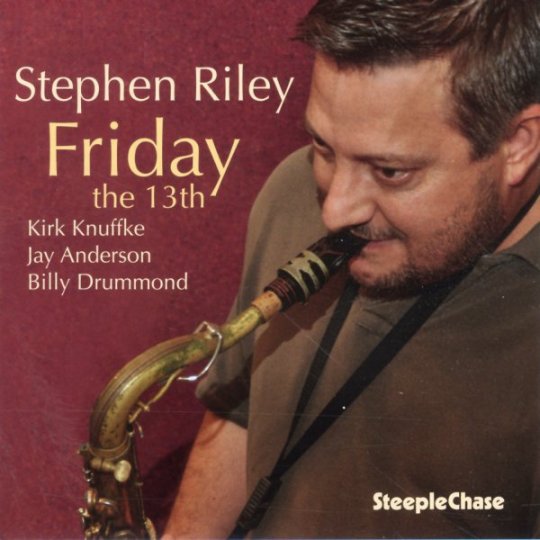
Like McPhee, Riley’s a perennial resident of my pantheon. This date realized a long-standing wish to hear him in the company of cornetist Kirk Knuffke backed by the freeing simplicity of bass and drums. Both men have aerated, instantly recognizable tones and pliancy in phrasing that provides practically endless possibilities in tandem. Riley’s also instrumental as featured guest on Pierre Dørge’s Bluu Afroo, a slightly preemptive Ruby Anniversary celebration of guitarist’s multinational New Jungle Orchestra.
Sam Rivers — Ricochet & Braids (No Business)

The auspicious launch of a Sam Rivers archival series last year was among the Lithuanian No Business label’s greatest achievements. Two more seminal entries came down the pike in 2020: Ricochet featuring Dave Holland and Barry Altschul of particularly fine vintage, and Braids spotlighting another pivotal Rivers ensemble in Hamburg with low brass wizard Joe Daley. There are four more to go, which should target the end of 2022 for the series’ completion.
James Brandon Lewis — Live at Willisau & Molecular (Intakt)

Lewis is the type of compelling artist tapped for accolades like Down Beat’s Rising Star award, despite having been active as an accomplished improviser for over a decade. Delayed exposure is common collateral to a career path in improvised music though, and the saxophonist hasn’t let slow-to-cotton critics slow him down a bit. A deal inked with the Swiss Intakt imprint has so far yielded Live at Willsau, which finds him in fiery duo with Chad Taylor, and Molecular, a studio venture with an all-star quartet that will hopefully become a working band again in 2021.
Susan Alcorn — Pedernal (Relative Pitch)
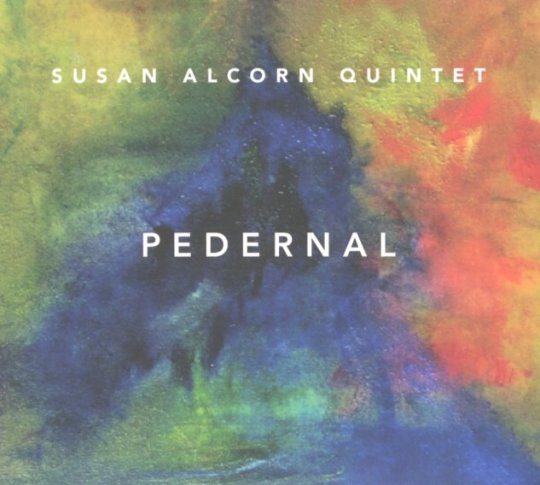
Pedal steel may feel like a nascent voice in improvised music, but in actuality Susan Alcorn and her peers have been plying it as a viable vehicle for some time. While Pedernal is somewhat perplexingly her first album as clear-cut leader, impediments to an earlier debut seem inconsequential given the ample amount of thought and design evident in the end product. Strings wielded by Michael Formanek, Mary Halvorson and Mark Feldman weave with the wide gamut of Alcorn’s aqueous sonorities across intricate pieces further stamped by Ryan Sawyer’s peripatetic drums. The results are at once daring and distinguished.
John Scofield — Swallow Tales (ECM)
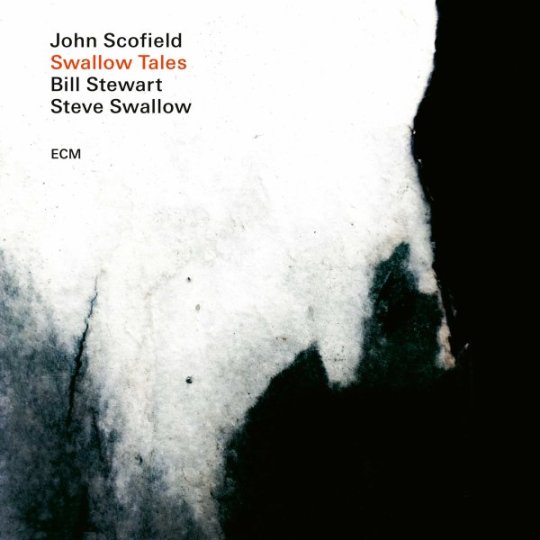
ECM has an enviably accomplished record when it comes to matching the austerity and formality of its sound design to artists’ objectives. Case in point this stark, but not standoffish trio set that’s as much (electric) bassist Steve Swallow’s offspring as it is Scofield’s. Drummer Stewart is the third point in the triangle, but he sagely defers to his elders, leaving them to a dance of differently gauged strings that expertly balances motion and space.
Corbett vs. Dempsey
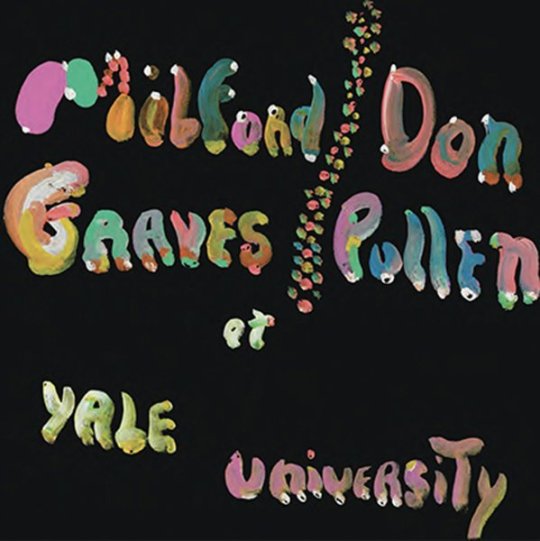
John Corbett is emblematic of that rare breed of music monomaniac who balances obsessiveness with altruistic generosity. He’s personally responsible for bringing dozens of rare and classic recordings back into circulation, first through the fondly remembered Unheard Music Series and more recently via the CvD concern. This year, another stack was added to that sum with Milford Graves & Don Pullen’s The Complete Yale Concert 1966 (including the rarified Nommo), Alexander von Schlippenbach’s Three Nails Left, Tetterettet by the ICP Tentet, Peter Kowald’s self-titled FMP debut as a leader and the madcap New Acoustic Swing Duo from Willem Breuker and Han Bennink as standouts.
Whit Boyd Combo — Party Girls & Dracula (the Dirty Old Man) (Modern Harmonic)

Vintage skin flick soundtracks have rarely if ever received an even-handed shake in terms of relative artistic merits. Tarred with the same smut brush as the visuals they were constructed to accompany, they’re routinely viewed as just as disposable. The Whit Boyd Combo doesn’t exactly dispel this dictum, but it does lay down some funky and at times refreshingly fractious freewheeling horns over organ, bass, and drums driven beats on this late-60s session tape excavated by the folks at Modern Harmonic. The companion Dracula (the Dirty Old Man) isn’t quite on par, but it’s still a solid vessel for competently crafted fossilized grooves.
Robbie Basho — Songs of the Avatars (Tompkins Square)
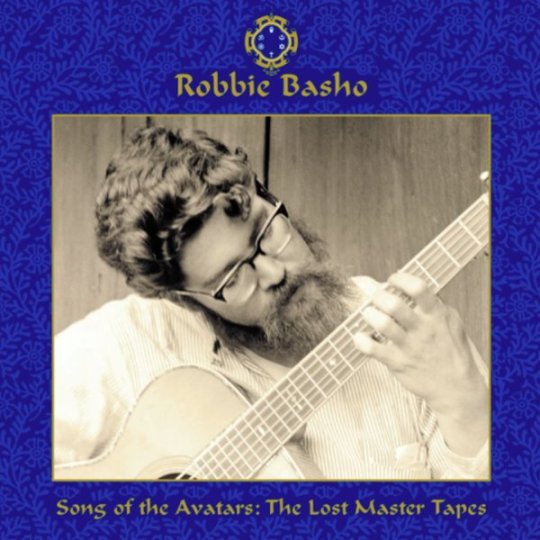
Real Gone Music whet the appetite earlier this year with the release of Songs of the Great Mystery, a “lost session” from Basho’s tenure at the Vanguard label. Songs of the Avatars ups the ante substantially by granting outsider access to a six-hour survey of the dearly departed fingerstyle guitarist’s personal tape trove. The aural riches are ample and include Basho exploring familiar proclivities (Indian, Native American and Japanese interpolations) alongside unexpected new ones (ballet and cantata) with passion and conviction to burn along the way.
Jimi Hendrix — Live in Maui (Experience Hendrix)
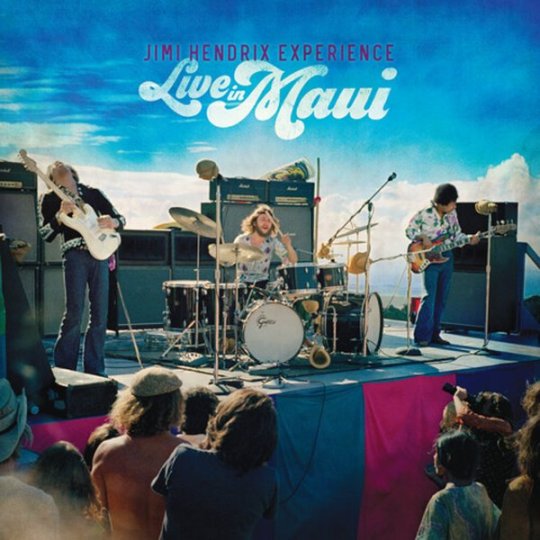
Posthumous Hendrix is a seemingly inexhaustible resource as each year repackaged and repurposed treasures are released into the marketplace. Fortunately, familial heirs are the ones doing the sowing and this lavish set documenting musical and extra-musical particulars of the icon’s reluctant conscription into cosmic hippie scam does right by him. Given the windswept conditions near the Haleakala Crater it’s a minor miracle that he, Billy Cox and Mitch Mitchell mesh as well as they do, and while the footage included can be frustrating in its fragmentary presentation, it’s still a thrill to see and hear them jamming in amiable and ebullient form.
Joe Maneri, Udi Hrant & Friends — The Cleopatra Record (Canary)
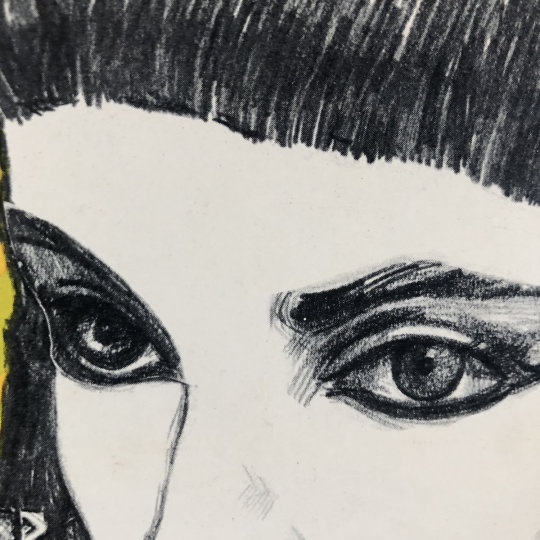
Details on this one could easily serve as grist for a credible short film screenplay with perhaps Jim Jarmusch directing. Brooklyn, 1963: A group of marginalized ethnic musicians relegated to playing wedding gigs gets conscripted for an afternoon recording session. The cheaply packaged and provincially distributed results are destined for the anonymity of dime store cut out bins. Except that the band includes two geniuses: Joe Maneri, who would go on to become a master microtonal improviser/composer and Udi Hrant Kenkulian, one of most revered modern doyens of the Turkish oud. Available over at Bandcamp for a pittance.
Ayalew Mesfin — Good Aderegechegn, Che Belew and Tewedije Limut (Now Again)
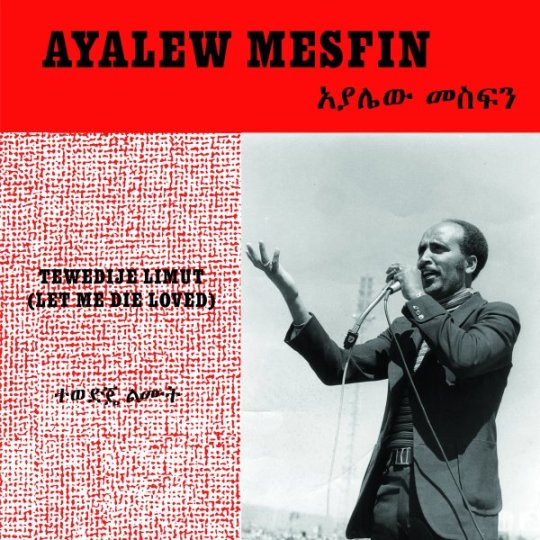
Adding up Buda Musique’s 30-volume Ethiopiques series and a host of other more modest enterprises, it’s obvious that there’s never been more access to vintage Ethiopian music than now. This trilogy of discs from the Now Again label covering vocalist/keyboardist/bandleader Ayalew Mesfin’s catalog restores one of the last untapped reservoirs to circulation. Tight horns, choppy, fuzz and wah-wah drenched guitars and chugging bass fuel dance floor burners while Mesfin’s pipes work memorable magic on a string of melancholic, melismatic ballads.
Kent & Modern Records Blues into the 60s, Vol. 1 & 2 (Ace)

Ace’s appellation as a music label of enviable reach and import has never been an erroneous assignation. This pair of compilations investigates the urban, but far from urbane, blues scene surrounding Los Angeles as documented by the Kent label in the 1960s. Comparatively longer-in-tooth legends like T-Bone Walker and Big Jay McNeely jockey with younger, fame hungry artists like Larry Davis and Little Joe Blue in negotiating a West Coast argot that’s heavy on electricity channeled through guitars and organs. McNeely’s ripping “Blues in G Minor” is one of several snarling sonic wolves in non-descript sheep’s titling.
V/A — A Stranger I May Be: Savoy Gospel 1954-1986 (Honest Jons)
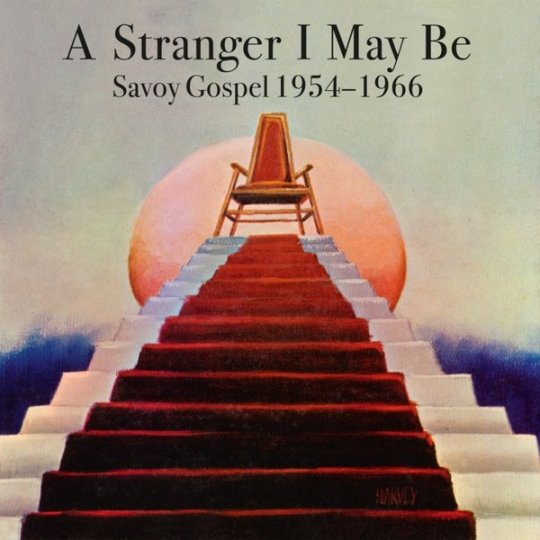
This astutely-sequenced set stands out in the particularly plentiful playing field of this year’s gospel reissues. The mighty Savoy label started out as a jazz venture before branching out into other African American musical idioms. The compilers at Honest Jons parse the program chronologically across three-discs and leave the heavy-lifting of context and artists biography to a lengthy essay. Choirs, ensembles, bands, and moonlighting R&B singers all make appearances directing their talents to devotional and invocational celebrations of the Father, Son and Holy Ghost.
Sun Ra

One of the highlight roundtables at Dusted this year was a Listening Post ruminating on the Sun Ra Arkesta with and sans Ra on the occasion of the band’s new release Swirling. I got to play the (hopefully uncharacteristic) part of curmudgeon in those exchanges principally because while I respect the ensemble’s longevity absent their lodestar leader, there’s still an explicit void extant that tends to eclipse my actual interest. The Ra reissue docket for 2020, which included excellent editions of Celestial Love and A Fireside Chat with Lucifer from Modern Harmonic, When Angels Speak of Love on Cosmic Myth, Heliocentric Worlds, Vols. 1 and 2 from Ezz-thetics, and Strut’s Egypt 1971, which collects Dark Myth Equation Visitation, Nidhamu and Horizon alongside a bevy of contemporaneous unreleased recordings, only bolstered the bias.
Fresh Sound Records

Still the standard for thoughtfully and lavishly curated jazz reissues, Barcelona-based Fresh Sound kept commensurately prolific pace throughout the year. Gary Peacock - The Beginnings surveys the recently deceased bassist’s early work as a versatile California-stationed sideman. Remembering does similar service to rare concert recordings by Belgian guitarist Rene Thomas while The Complete 1961 Milano Sessions offers truth in advertising by compiling woodwind savant Buddy Collette’s sojourn on Italian shores with (mostly) indigenous sidemen.
V/A — Sumer is Icumenin (Grapefruit)
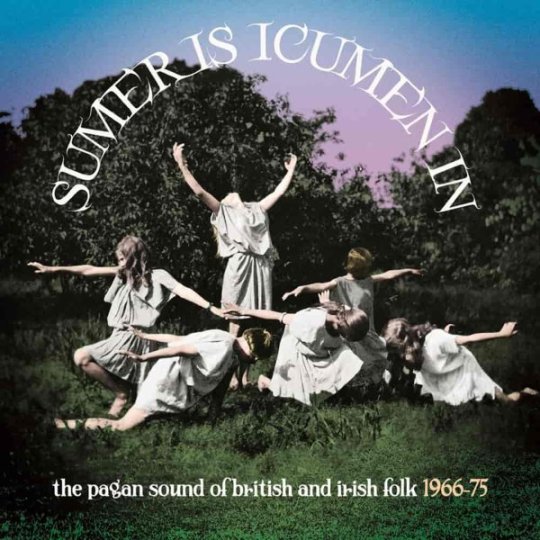
An overdue sequel to Dust on the Nettles (2015), which apparently commands on princely sums on Discogs these days, this set encompasses 4+ hours of cherry-picked vintage British freak folk. Second helpings from stalwarts of the style such as Comus, Steeleye Span and Fairport Convention join Albion offerings from obscurants like Vulcan’s Hammer, Mr. Fox and Oberon in celebrating the weird crossroads of ancient Britannic and 1960s counterculture influences. The cant is more to The Wicker Man side of the spectrum with Magnet’s bucolic canticle “Corn Rigs” the ringer in that regard.
Twenty-five more in mostly stochastic order:
Aruán Ortiz - Inside Rhythmic Falls (Intakt)
Brandon Seabrook/Cooper-Moore/Gerald Cleaver — Exultations (Astral Spirits)
Cecil Taylor & Tony Oxley — Birdland, Neuberg 2011 (Fundacja Sluchaj)
Horace Tapscott w/ the Pan Afrikan Peoples Arkestra — Ancestral Echoes: The Covina Sessions, 1976 (Dark Tree)
Damon Smith — Whatever is Not Stone is Light (Balance Point Acoustics)
Frank Lowe & Rashied Ali — Duo Exchange: Complete Sessions (Survival)
Dudu Pukwana — and the “Spears” (Matsuli Music)
Mary Halvorson’s Code Girl — Artlessly Falling (Firehouse 12)
Burton Greene — Peace Beyond Conflict (Birdwatcher)
Albert Ayler — Trio 1964: Prophecy Revisited (Ezz-thetics)
JD Allen — Toys/Die Dreaming (Savant)
Charles Mingus — At Bremen 1964 and 1975 (Sunnyside)
The Warriors of the Wonderful Sound — Soundpath (Clean Feed)
Kidd Jordan/Joel Futterman/Alvin Fielder — Spirits (Silkheart)
Roland Haynes — 2nd Wave (Black Jazz)
Quin Kirchner — The Shadows and the Light (Astral Spirits)
Thelonious Monk — Palo Alto (Universal/Impulse)
Black Unity Trio — Al-Fatihah (Salaam Records/Gotta Groove)
Gary Smulyan — Our Contrafacts (Steeplechase)
Joni Mitchell — Archives Vol. 1: The Early Years (1963-1967 (Rhino)
Elder Charles Beck — Your Man of Faith (Gospel Friend)
Sarhabil Ahmed — King of Sudanese Jazz (Habibi Funk)
V/A – The Right to Rock: The Mexicano and Chicano Rock ‘n’ Roll Rebellion 1955-1963, Episodio Uno (Bear Family)
V/A – Hillbillies in Hell: Country Music’s Tormented Testament (1952-1974) ~ Revelations (The Omni Recording Corporation)
V/A — The Harry Smith B-Sides (Dust to Digital)
#yearend 2020#Dusted magazine#derek taylor#paul desmond#chris dingman#joe mcphee#sonny rollins#stephen riley#sam rivers#james brandon lewis#susan alcorn#john scofield#corbett vs. dempsey#whit boyd combo#robbie basho#jimi hendrix#joe maneri#udi hrant#ayalew mesfin#kent & modern records#a stranger i may be#sun ra#fresh sounds records#sumer is icumenin
15 notes
·
View notes
Text
Beyond a Chance
Chapter 2: A new test
After having spent the morning rehearsing, Yasmim decided to lget out of home for a while. In addition to thinking that it would do her good to get some fresh air, she needed to do some shopping, her refrigerator and stocks were a little understaffed.
Even going to the supermarket reminded her of her childhood, of the mess she made with her siblings, running down the halls, insisting that her parents bring her sweets. Her thinking really convinced her to take home donuts among essential groceries.
After paying for everything and returning home, she was surprised by three missed calls and a voicemail message. Seeing who it was, she despaired a little. Astonished, she hurried to call him back.
'"Hi Howard, it's me" she said quickly before he could say anything "I'm sorry for not answering sooner, I had to go to the market and I forgot my cell phone charging."
"Oh yes, I was worried because you don't get off your cell phone" he commented "well, now that I can talk to you, listen to me carefully."
"Yes, sir" Yasmim even sat down for that purpose.
Howard Lawrence had been her agent since moving to Los Angeles, who had also battled for her and her career, but no luck getting big auditions for Yasmim, well at least so far.
"A casting agency issued a call for super secret auditions" Howard explained "and best of all, they want all-Latin actresses."
"That's great, but why so much secrecy?" Yasmim looked suspicious "what about my age? Are you sure this isn't one of those cases where I'm expected to look younger than I am for a role of 25? This doesn't work..."
"I know your frustration with this, but listen to me" he was patient "the age they are looking for is 30 to 40, so you fit perfectly."
"Perfectly?" she asked "I hope so, and then, do you intend to schedule a test for me?"
"Of course, you just have to say yes" Howard was excited "I know I've failed you a lot, but I feel that this is the chance that can reward both of us."
"Yes, so yes, I want this test" she allowed herself to be happy "just send me the character description and I'll start studying right away."
"That's more like it!" Howard got really excited, which made Yasmim smile "well, they described the character as a noble and reserved girl who is the moral compass of her friends."
"Okay, got it, I know where to start" she understood "so let me know when the day of the test will be."
"Of course I'll let you know" Howard replied with all the support "and from now on, I wish you good luck."
"Thank you then" she smiled "and bye."
"Bye, have a good day, I'll talk to you later" Howard said goodbye, ending the call.
Yasmim let out a hopeful smile, even though she was alone in the house. She would seize this opportunity with all her strength and would not let it go by any means.
She began to write a dialogue over what Howard had said, studying and speaking what she had written. A while later, when Howard had already scheduled her test and had access to the text, he sent it to Yasmim, who, upon reading, saw that she was on the right path.
"I don't recognize you anymore, I know about your dark side, I know you never felt like you belonged anywhere, but what we had together, what we built together, doesn't it mean anything? Yes, you can accuse me, you tell me I didn't always love you, but you know that's a lie. Me not realizing that I loved you but I always did doesn't invalidate my feelings."
It was a very strong monologue, which immediately stirred Yasmim's imagination. She could understand well what this mysterious character was like from there, but who she should be talking to, that was curious. A friend of hers? A love from the past? A corrupted relative? It was a detail full of possibilities.
She then devoted herself to the monologue, wondering who she would say it to, spending the days leading up to the test that way. And so, the day of her big break arrived.
After a cab ride, there was Yasmim Gomes in a small office in Los Angeles, waiting to be called.
"Yasmim is next!" she heard the secretary call.
She stood up, leaving the anxiety and apprehension out of the testing room. When she saw who was waiting for her, she had a slight insight. It really wasn't just any test.
Next to the casting man was a man in his forties, clean-shaven, talking to the woman beside him, and on his head was a distinguished red cap.
Yasmim remembered when Bruno showed her a video of that same man, her brother described him as "Kevin Feige, the big boss of Marvel, the one responsible for all these blockbuster superhero movies." That is to say, Yasmim was competing for a spot in a movie or other major Marvel production, with all the visibility that work could offer. She couldn't miss this chance.
"Hi Yasmim, I'm Sarah, this is Kevin, welcome" tthe casting director said, snapping Yasmim out of her pensive state.
"Hi, thanks" the actress replied.
"So, before we start, tell a little more about your work experiences" Kevin asked and gulping hard, Yasmim prepared to answer.
"I've mainly worked with theater plays here in Los Angeles for the last 6 years" she handed over the information.
"I see, well, you received the monologue, you can start whenever you want" Sarah gave her the instruction.
Yasmim took a deep breath and began to recite the sentences, with all her talent and dedication. Her acting was very truthful, which left Kevin and Sarah impressed, noting excellent comments about her audition.
"Very well, Yasmim, that's it, we thank you for your participation, we wish you good luck and we will get in touch if you have passed" Kevin warned.
"Thank you very much, I'm going then, bye" Yasmim said goodbye and left.
In her heart, she knew it had gone really well, but now, waiting for a positive result made her even more anxious. She hoped everything had worked in her favor this time.
Notes:
Hey guys? How are you? Well, you know Loki was released recently and well, I got the idea for this story because of the show. I've always loved the character and I think Tom is a hell of an actor, so I decided to write this story. Yes, it's true that this narrative formula is already pretty well wasted by myself, but let's see what I can do differently now.
Trivia: Santa Fé do Sul really exists, it's the neighboring town where I used to live, and Snow White's play was the first play I did in school, but I played the princess's mother, in a super short silent role. Well that's it, follow the new chapters every Friday and comment there, thanks!
#fanfic#my writing#beyond a chance#yasmim gomes#tom hiddleston#tom hiddleston x oc#tom hiddleston x brazilian!oc#tomim#tom x yasmim
1 note
·
View note
Photo


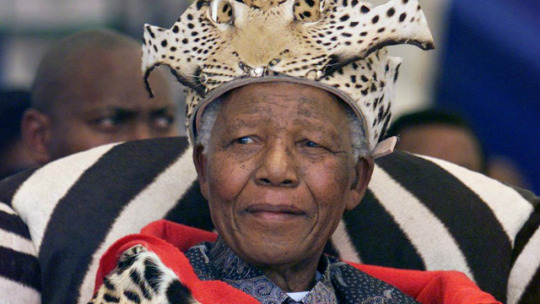
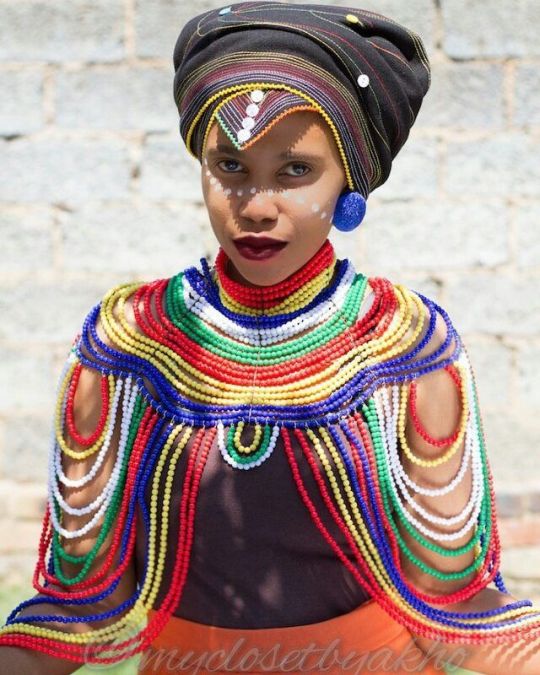





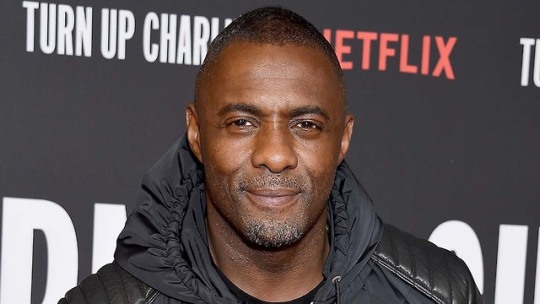
African not Black
Blackness Started in Slavery
We have to start this discussion in its most basic terms. Where do Black people originate from? Then if the answer is Africa, then what is the purpose of identifying with a color over our beautiful Motherland? We could end all discussions with just that simple sentence.
Black is a construction, which articulates a recent social-political reality of people of color (pigmented people). Black is not a racial family, an ethnic group or a super-ethnic group. Political blackness is thus not an identity but moreover a social-political consequence of a world which after colonialism and slavery existed in those color terms.
“white” depends for its stability on its negation, “black.” Neither exists without the other, and both come into being at the moment of imperial conquest– Fanon
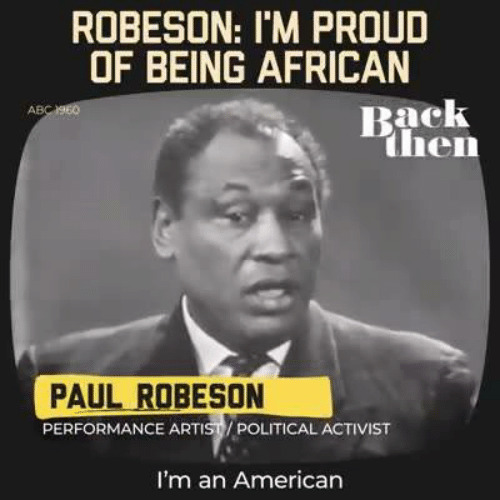
The Invention of the White Race is a groundbreaking analysis of the birth of racism in America. When the first Africans arrived in Virginia in 1619, there were no “white” people, nor, according to colonial records, would there be for another sixty years. In his seminal two-volume work, Theodore W. Allen details the creation of the “white race” by the ruling class as a method of social control in response to labor unrest precipitated by Bacon’s Rebellion. By distinguishing European Americans from African Americans within the laboring class, white privileges enforced the myth of the white race through the years and has been central to maintaining ruling-class domination over the entire working class.

In our modern era old identities split apart and reform along more self-determined line to recover what was lost after the impact of conquest and domination. We see The Gypsies are now to be called “Roma,” and the reindeer-herding Lapps of Northern Scandinavia are the “Saami.” Similarly, some now claim the Iroquois Indians should be called the “Haudenosaunee” and the Cherokee the “Tsalagi”
Africans have gone from Negro (Spanish for Black) to Black (English for Negro) what has changed? Only the language. An identity is generally geographical and ties the people to their native environment or their core doctrine (Jews of Judaism, Muslims of Islam, Chinese of China).

Very few Africans are actually Black in color, so where is the foundation of a Black people or black people coming from? It is how Africans were seen relative to the European people. So relative to the pales skin of Europeans and White Arabs the most dominant thing about African was relative skin color. Hence the exonym Black in the eyes of the “other.” It was not the land, not the African hair, but the relative color of a diverse skin pigment – that is rarely black in color. For Indians it is their land, for Chinese it is their land, for Jews it is their faith and a notion of Israel. Yet Condolezza Rice feels the best thing that describes her in American is blackness. And to some extent she is right, because there is nothing in her cultural, ethical, aesthetic, outlook that resembles the continent her ancestors came from. She has replaced Africa with America, and finally Africaness with dreams of the White ideal.

African and black are not interchangeable just as Dark continent and Africa are not. Self-determination allows a people to re-examine definitions and sculpt them to their reality. Black, like Negro is facing linguistic extinction, especially in academic circles, due to its poor foundation in speaking about the oldest and most diverse people on the planet. Notice today only two races go by color labels; The race with the most oppression and the ones inflicting that oppression. “I am black and proud” is a song, nothing else. It is the rhetoric necessary at the time to lift an oppressed people who only knew of themselves through the eyes of their oppressor. It has run its course and has expired.
Some have argued that African people chose “black” as an acceptable identity. The evidence is in all the books African-Americans write where the word “black” (lowercase) is used without care. But self-determination has a condition – full knowledge of self. And this is why we see the new Nig*er identity which by the same mass consensus process seems to be a valid new identity. And just like “black” it is again almost exclusively the world view of a minority African population living in America.
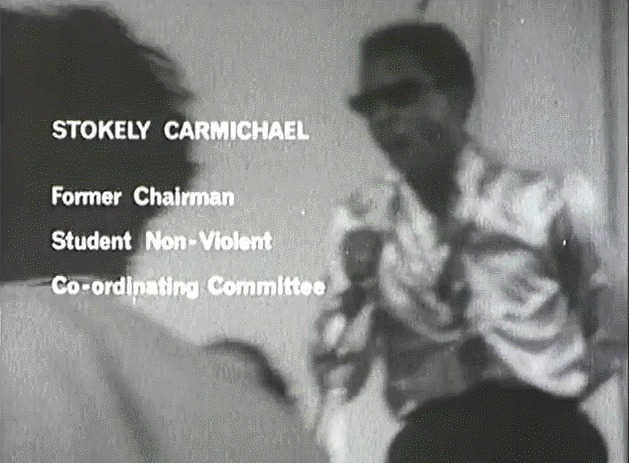
In Mauritania, the Haratin account for as much as 40% of the Mauritanian population. They are sometimes referred to as “Black Moors“, in contrast to Beidane. The Haratin are Arabic-speakers, and generally claim a Berber or Arab origin, which is contrasted against other African peoples in southern Mauritania (such as the Wolof and Fula people who have populations in Mauritania). The Haratine, consider themselves part of the Moorish community. But where it becomes problematic is because they are “darker” in color, they are assumed to be slaves brought from “black Africa.” So powerful is the theory of “two” Africa’s that reality is twisted to accommodate its validity. Every study is looking at Africa through the lens of “Black and White”, “slave and master.” It is therefore never considered that these “black” populations, like the Kanuri, who migrated South from North Africa, are native to the region. In a struggle to sustain colonial linguistics all forms of pseudo -anthropology is imposed on the African reality posing itself as mainstream studies.
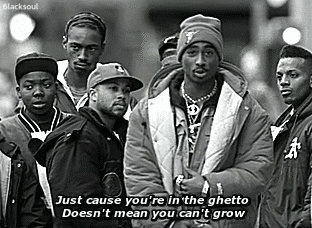
Ethiopia never had a history of “Black” identity
Brief History : During the displacement of the African Holocaust people were disconnected from culture, language and identity, they went from Fulani, Hausa, Igbo to a relative color, aptly describing their status in European society– Black. Now stuck with this name, and with no agency, no conscious of self outside of the chains of the Holocaust, being black became a source of reactionary pride. (especially in the 60’s). This happened also because the involuntary Diaspora had a deep self-hatred for their African connection, and would prefer to be a empty color than connected to their Motherland–that was the dept of the self hatred. And this produced reactionary love because they had to be something, and they could not be European, so in the psyche reaffirming a negative name was in some sense a statement of ownership–a statement of being. In reality it was a statement of displacement and self-hatred.
The word “Black” has no historical or cultural association, it was a name born when Africans were broken down in to transferable labor units and transported as chattel to the Americas. The re-labeling of the Mandika, Fulani, Igbo, Asante, into one bland color label- black, was part of the greater process of absolute removal of African identity; a color epithet that Europe believed to be the lowest color on Earth, thus reflecting the social designation of African people in European psyche. When Africans, out of their own agency refer to themselves they do so with internal paradigms and self-affirmation. No where in Africa did Africans see the obvious, the natural skin color they had, as the most distinctive characteristic in defining them:
Zulu – People of the sky Khoi Khoi – King of men Numunuu (Native Americans) – The people Mediterranean — ” Our Sea” Senegal – “Our land” Navajo -“Diné” meaning “The People” Han-in (Korean: 한인; Hanja: 韓人; literally “great people”) Bantu – “human” {note}
In this history of Swahili the people called themselves “people” no color attached. Attaching color is only done to refer to “the other.” In Zulu Kingdom again we see no record of a self-reference to a “Black people” they called themselves “People of the Sky” until White people showed up and called them blacks. It is true the term Ethiopia in ancient times meant “burnt face” but the modern name Ethiopia is a name not a Greek word. And the critical thing is name verses descriptive terms. The same is true for Sudan.

ODD ETHNIC GROUP Sesame Street use to play a game called Which one is the odd one out. Can you spot which of all of these so-called Ethnic names is the odd one out:
East Asian (a place) Southeast Asian (a place) South Asian (a place) Black (a color) Hispanic/Latino (a language group tied to a place) Caucasian (a place) Middle Eastern (a place) Native American/First Nations (a place) Pacific Islander (a place) Arab (a place)
Linguistic evolution? COLORED – NEGRO – BLACK – AFRICAN-AMERICAN – NIG*ER

BLACK HISTORY
Black history is the history of enslavement; African history is the history of humanity. If there are no White people, could there be Black people? For over 100,000 years there were only native people of Africa on the planet, and since there were no “White” people there could not have been Black people, since everyone would have been “Black.” This is even more profound when you realize African people are the only truly native people of the place they inhabit—everyone else is at some point a settler.
Every ethnic group in this country has a reference to some land base, some historical cultural base. African-Americans have hit that level of cultural maturity… To be called African-American has cultural integrity– Jesse Jackson
And if all the “White people” vanished from the Earth, would the remaining “Black” people still be Black? So the older group must define itself relative to the European newcomers? Would it not make far more logical, historically, linguistically, and social to describe people by their land of origin. Negro = Negroid = Colored = Nigger = Black (all associated with color none are connected to a continent). Now compare this to Asiatic, Caucasoid, and Mongoloid (all are tied to land, all can be located on a map— but not so Negroid/Black). Black and White are therefore debunked as regressive incomplete terms for describing people.

For all of recorded history we see in every conflict a central theme — that of “land.” So critical as humans need land to grow crops on, to source water from (see Golan Heights), they need a place to build cities and a place to harvest mineral wealth from. So attaching your identity to land makes sense: Attaching your identity to an abstract color, does not. Black and African are not interchangeable in any logical sense. African people claim an African origin and Africa as their Motherland. There is nothing in “blackness” that logically implies any claim to anything of value, except into bondage. All it tells the world is relative to the dominant race class these group of people are “black.” And in Africa it is even worse, because language wise no majority defines themselves against a minority. i.e. Sudan (Northern Sudan) is still Sudan, but Southern Sudan has to insert “South” for clarity. Holocaust, on its own, is assigned to the Jews, who do not insert “Jews” before Holocaust, since they are the first to use the term in its modern context. How can the majority in South Africa need to identify themselves as “black” relative to a “white” when they are a overwhelming majority and hence “the norm”?
And what is even more revealing is that Dutch settlers in South Africa branded themselves as Afrikaners laying claim to the land they conquered. Signifying in that naming process they were the native European tribe of of Africa (per Zuma). And yet Natives in South Africa still refer to themselves, with glee, as blacks.
It is amazing in our modern era that an entire nation of people, who are free to think and free to reflect– the oldest nation on the planet, the parents to every other people are confined by a name that reflects only their supposed skin color — and nothing else. Being “black people” is still today indelible fixed in Western lexicon (both African American and White), despite all the evidence contradictory such color-based terminologies and the profound work of Malcolm X and especially Richard B. Moore to favor African over Black, which would give a humanist representation of marginalized people. And the perplexing thing is general contentment and seeming inability to see the obvious menace in the term. Only two groups remain on Earth adhering to color labels; the most exploited people in the history of humanity (Black people), and their apex oppressors (White people).
True freedom is not only the right to vote, but the right to self-define and the right to interrogate definitions imposed and formulate new ones, which favor the African in any given political climate

If linguistically we reject the term.Sub-Saharan Africa then therefore there is no Sub-Saharan history or people; as distinct from North Africa. We then only have Africanpeople and a history of Africa
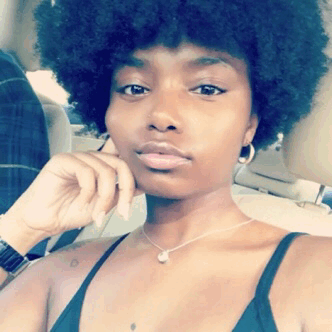
We must realize these are still colonial classifications like Middle East which have nothing to do with historical Africa. We cannot discuss a history of Africa in these colonial boxes which only served to humiliate and take away from the continent. The terms create paradigms which limit, rather than expand, reality. If there are a black or Black people then where do “black” people come form? Since Asians come from Asia, Indians from India (all makes perfect logically sense).
So where do Black people come from? Blackia, Negroland or Blackistan, following the obvious naming convention. What is the capital city of the Black home world? Black City or Blackatropolis? So if Africans do not come from these fictitious places and we find that so-called Black people come from Africa (at some time in our recent history) then why not just call them Africans? At best the term is redundant. So what is the purpose of Blackness? Especially in a world where identity and land are exclusively interlinked for every other people: Jews of Israeli, Palestinians of Palestine, Indians of India, Zulu of Zululand, Masai of the Masai Mara
Twenty-two million African-Americans – that’s what we are – Africans who are in America– Malcolm X
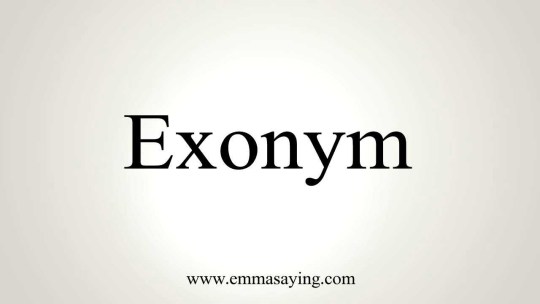
Blackness, is largely a Western or American exonym, in which all so-called Black cultures around the world are forced to fit into. As Americanism expanded so to did this notion of blackness, which is attached to the civil rights struggle and today to the urban cultures of the inner cities. However, It cannot be transplanted into ancient history to describe a people such as Ancient Ethiopia who had no cultural similarities to the modern African-Americans communities. Neither can “Blackness” be put in history to say the Ancient Egyptians were not Black because they did not share characteristics with a group of Africans Europeans chose to label as the archetypal Black population (black skin, thick lips and kinky hair). To do so creates connections and disconnections where there are none. So “Black culture” or “Blackness” cannot be imposed anywhere beyond the modern era. But we can say Cultures of Africa, in which Egypt and Ethiopia were part of that African world. Being African doesn’t mean we all dance to the same music and worship the same tree. So outside of the suggestiveness of “black” and “negro” words are necessary in creating new paradigms or we will always get stuck hearing “Well the Egyptians were not Black” because of a language issue or some other technicality. Far less objections could be raised if we just stuck to “The Egyptians were Africans“. Especially if we claim African as oppose to let it float.
The political question of contributions of modern day African people must be addressed and in this respect Ancient Egypt, Ancient Ethiopia were African civilizations, the same way Greece was an Ancient European civilization (it was located in modern Europe). But this argument is a political because we live in a racialized world which discredits a people’s worth by notions of racial origin and assumes black skin is too inferior to construct civilization.
There is an academic debate that the Ancient Egyptians called themselves Black based upon KMT (Kemet) which in some circles is translated as “Black people.” Now at the end of the word KMT is an ideogram which can only mean physical place
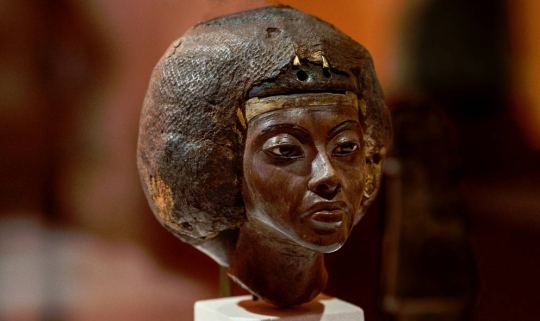
The ideogram indicates the context in which the word applies. An ideogram for humans would always be used to represent a word that applied to people. However Kemet can only mean Black Land since the ideogram indicates it is describing a built or non-human environment. They called themselves “remetch en Kemet”, which means the “People of the Black Land.” Where rmt means simple without any adjectives “the people,” the same way the Numunuu means “the people.”(the authentic people) And likewise Zulu means people of heaven.
Ancient Egypt is commonly referred to as ‘km.t’ , with the theorized reference to the black Nile Delta earth. The determinative O49 is used to designate the term for ‘country, inhabited/cultivated land’, called the niw.t (a political designate). It is a circle with a cross which represents a street, ‘town intersection”(Gardiner 2005 (1957): 498)
But none of this discredits the founders of Kemet as being African people, just like the Fulani or the Amhara. “Black” in the North American context. The “social “construction of race in America does not rely on skin color. “African Americans,” as even Asante notes, ” constitute the most heterogeneous group in the United States biologically, but perhaps one of the most homogeneous socially.”

BLACK AND THE 60’s
Indians are from India , Chinese from China . There is no country called Blackia or Blackistan and a people must respectful be tied to geography as skin color is not the primary definitive identifier.. Hence, the ancestry-nationality model is more respectful and accurate: African-American, African-British, African-Arabian, African-Brazilian, and African-Caribbean. And if Black people has some validity as a political term it can not be limited in its application to people of African decent. Nostalgia is not an accurate place for African linguistic self-determination, and blackness is blatantly a cultural inheritance of oppressed people. The pattern of acceptance of a black identity globally walks hand in hand with European cultural oppression.
Black pride is reactionary pride, necessary then, Irrelevant now. As we blossom into a greater historical and cultural awareness of a Motherland a detachment with fictional attachments to slave names must be challenged, and we must end the romance with things that are a disservice to our identity today.
It is worth noting parts of African that are culturally intact such as in Ethiopia, Mali, Somalia, Nigeria and Niger have absolutely no fondness or linguistic presence of a “black identity.”
New York Times | The term African-American has crept steadily into the nation’s vocabulary since 1988, when the Rev. Jesse Jackson held a news conference to urge Americans to use it to refer to blacks. ”It puts us in our proper historical context,” Mr. Jackson said then, adding in a recent interview that he still favored the term. ”Every ethnic group in this country has a reference to some land base, some historical cultural base. African-Americans have hit that level of cultural maturity.” Since 1989, the number of blacks using the term has steadily increased, polls show. In a survey that year conducted by ABC and The Washington Post, 66 percent said they preferred the term black, 22 preferred African-American, 10 percent liked both terms and 2 percent had no opinion. In 2000, the Census Bureau for the first time allowed respondents to check a box that carried the heading African-American next to the term black. In 2003, a poll by the same news organizations found that 48 percent of blacks preferred the term African-American, 35 percent favored black and 17 percent liked both terms.
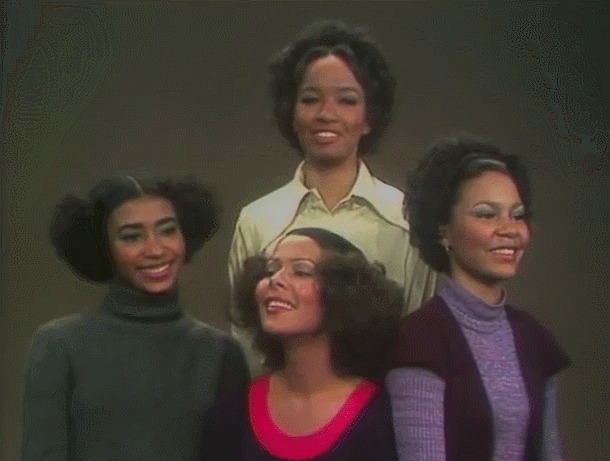
BLACK-AFRICA IS A RACIST TERM
Nobody on this planet puts a adjective on their identity, especially when they are a majority, except African people. Black Africa, Dark Continent, Heart of Darkness all articulate the colonial contempt for a continent and its people. But how does one arrive at the term “black Africans,” are there green Africans? Would you speak of “yellow Chinese,” or “brown Indians”? Even terms like “White Russian” are unused, despite Russia being a multi-ethnic nation. Because 80% white means the majority have no need for adding White to their Russian to qualify against a minority of “other” Russians. [3] Globally the term ” Red Indian” is rejected as deeply pejorative yet “black African” is still used even in South Africa which is used to define the majority of the population against the minority so-called white-Africans. Black African is as ridiculous as “rock stone”, rocks are stones so why double up two realities which are often the same?
There is an infinite an inexhaustible list of examples which show that no one with power wears and adjective on their identity, especially when equal or a majority. The peninsula of Korea is called Chosŏn Pando (조선반도; 朝鮮半島) in North Korea and Han Bando (한반도; 韓半島) in South Korea based on the respective names of the two countries. (wikipedia)They both use “Korea” as part of their official English names. In other words North Korea does not say they are North Korean, as far as they are concerned they are the KOREA. The South does not waste time defining itself as South Korea, again, as far as their national pride is concerned they are just Korea. Both countries have equal political and cultural agency. So how is it possible for a continent whose overwhelming demographic, political, cultural majority is African, need to refer to themselves as black + African? And with the split of N. Sudan and S. Sudan it would be shocking to see if N. Sudan adds the term “North” to its national rhetoric, to clarify itself from its new southern neighbor.
There is only one reason the term Black African exists and that is to deny nobility from African people. To explain away how Egypt could be nested in Africa but at the same time divorced from the majority of the African people. Therefore the argument “yes it is in Africa, but it is not Black African.” It is almost like saying Greece was a European civilization, but not a White European civilization.
If 95% of Africans are “Black” (capital B, if it must be used) then the minority should bear the adjective–not the majority. It is disrespectful to describe Africans with a label based solely on a color, especially when it does not accurately reflect the physical appearance of most Africans. This is made even more offensive when the etymological root of that label (black) is derived from the word Negro, and is used in place of the word African as a racial or cultural identity. In reality we must ask ourselves what is the difference between “Negro” and “Black” save historical association, the words mean the same thing, so we have moved from being Black in Spanish (negro) to Black in English (black). It is strange that despite all the genetic research and advance human anthropology we are still clinging to primitive 18th century post-Darwin model of race, which sole aim was/is to segregate and de-culturalize and enslave.
The concept of a “black Africa ” is a Eurocentric term based upon their ignorant primitive regressive deductions. It is true Arabs and Greeks referred to Africans as “black” but this was not a racial label, and moreover Africans themselves did not self-apply these external labels. Like the Phoenician who were called the “red people,” but no Phoenician would have referred to themselves in this way.
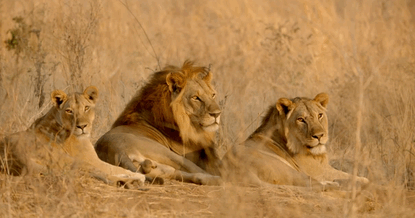
CHILDREN DIS-IDENTIFY WITH BLACK
In a recent survey conducted by the African Holocaust society it was noted that young African children (approx 4-5 years old, the age of race consciousness) when told they were members of the “black race” reacted with great confusion because they were also being taught the names of colors. Most of them objected to being called black and said they were not black but rather brown. A repeated survey found that when they were told they were African they did not object to the logic (they were African because their ancestors were from the continent called Africa). Blackness is illogical and only exist by force conditioning of children. This case study is profound because it shows how logic and identify form before social concepts are enforced.
WHITE AFRICANS
It would be very strange if a European, after 200 years in China or India, could be so powerful to alter the definition of Chinese just to be accommodated. Linguistic accommodation is only possible in Africa because of the prevailing injustice of a post-colonial dominance of European settlers. It is clear some European funded African politicians backed it, but where did it originate from? It is interesting to note Europeans (including white Arabs) constitute around 10 million people verses the 800 million plus Africans. Now this negligible minority by way of social influence has caused the majority to need to refer to themselves with the adjective of “black” to separate themselves from a serious minority group who want to be “white Africans.”Minorities of Europeans live in China, in India and in Arabia yet only in Africa has linguistic accommodation been given. Africans now must make room for those settlers who want to identify with the continent for capitalist reasons. Because once you identify with a continent then you have a legitimate claim to its resources. Thus the saying and the philosophy of Garvey “Africa for the Africans” becomes usurped. In South Africa the new trend of “Black Economic Empowerment” has seen the broadening, opening up of the borders of blackness so to speak. Indians are economically classified as ‘black’, and recently Chinese have been included in this definition. So again we see the relationship between linguistics and economic profit.In the scramble for linguistic real estate, why would these descendants of European colonialist who devastated and exploited the continent want to be called African? And in terms of self-determination who introduced these concepts?Despite claiming “African” in name they are very conscious of Whiteness when propagating the White dominant image on the broadcast mediums they control. Being White is clearly obvious when it comes to the dilemma of ownership which is still tipped in their favor. When all of these White South Africans rush home to Europe (when Africa gets a little sticky) do they encounter job discrimination experienced by fellow African South Africans or even 3rd and 4th generation African-British? They integrate seamlessly into the social environment created by White privilege. Seems like with the Indian “Africans”, African is a jacket worn to suit an economic or political opportunity.Race was not only defined in the 18th century, in Aksum and Kemet African peoples have always identified with degrees of racial inclusion and exclusion. The arrogance of Whiteness is to assume they are responsible for every single point of view that has ever existed on this planet. All the while South Africa remains White dominant and unchallenged by people who are the most vocal White Africans. Interestingly if you examine their lifestyle, you will find them to be the most racial conservative personalities. They date and marry women of their specific race, they socialize in White circles, they engage a distinctive non-African culture. And if they do have a few token “Black” friends they are often culturally compromised aberrations the continent can produce. The injustices of White dominance and the legacy of that dominance are smooth over by fictional fantasies of non-returning colonial tourist who still impose their reality as the norm for everyone else. Moreover, in dealing with these issues they always select broad base arguments and never deal with the core issue of African self-determination and agency.
Africa, unlike “black,” is a name, not a adjective. You can get on a plane and visit it, you can find it on a Sat Nav, it has boundaries, governments, you can grow crops on it, and build a house on it. But some say, Africa was a foreign name given to us, if this is true, it was given to us by our contemporaries not our conquerors. However, the word has Berber Tunisian origins meaning ” A sunny place” – Ifriqiya .Romans appropriated this word from which it is believed the modern word Africa came about the describe the entire continent. In addition, Africa is a unique name of a place and Africans are simply people who are native to that place. And over the course of history different names such as Habesha and Takruri were used to refer to African people of various regions, Ethiopia and West Africa respectively. Also the word Moor has been used across the centuries but as critics have established, the term “Moor” was used interchangeably with such other ambiguous terms such as “Ethiopian,” “Negro,” and even “Indian” to designate a figure from different parts or the whole of Africa (or beyond) who was either black or Muslim, neither, or both.
Massey, in 1881, stated that Africa is derived from the Egyptian af-rui-ka, meaning "to turn toward the opening of the Ka." The Ka is the energetic double of every person and the "opening of the Ka" refers to a womb or birthplace. Africa would be, for the Egyptians, "the birthplace.
Human skin color ranges in variety from the darkest brown to the lightest hues. An individual's skin pigmentation is the result of genetics, being the product of both of the individual's biological parents' genetic makeup, and exposure to sun. In evolution, skin pigmentation in human beings evolved by a process of natural selection primarily to regulate the amount of ultraviolet radiation penetrating the skin, controlling its biochemical effects https://en.wikipedia.org/wiki/Human_skin_color
“You can’t hate the roots of the tree without ending up hating the tree. You can’t hate your origin without ending up hating yourself. You can’t hate the land, your motherland, the place that you come from, and we can’t hate Africa without ending up hating ourselves - Malcolm X
While in Ghana, Dr. King Jr. told then U.S. Vice President, Richard Nixon, who was also in attendance at the event’s festivities: “I want you to come visit us down in Alabama where we are seeking the same kind of freedom the Gold Coast is celebrating”.Dr. King Jr. also returned from his trip deeply inspired about the Pan-African movement and penned a sermon called “Birth of a New Nation”. In it, he educated others, especially African Americans in the Civil Rights Movement, about Africa, then largely known as the “Dark Continent”. He highlighted various countries across the continent, including Egypt, Ethiopia, South Africa, Uganda, Nigeria, Liberia, Kenya, and Ghana and their plight. He used Ghana’s story to remind his brethren of the cost of freedom:“Ghana reminds us that freedom never comes on a silver platter. It’s never easy…Ghana reminds us of that. You better get ready to go to prison. When I looked out and saw the prime minister there with his prison cap on that night, that reminded me of that fact, that freedom never comes easy. It comes through hard labor and it comes through toil. It comes through hours of despair and disappointment.”2. In previously unreleased documents, it was discovered that Dr. King Jr. traveled to West Africa in 1960, this time, to attend the Inauguration of Nigeria’s Nnamdi Azikiwe in Lagos. He said the following about his trip to Nigeria:“I just returned from Africa a little more than a month ago and I had the opportunity to talk to most of the major leaders of the new independent countries of Africa and also leaders of countries that are moving toward independence. They are familiar with it and they are saying in no uncertain terms that racism and colonialism must go for they see the two are as based on the same principle, a sort of contempt for life, and a contempt for human personality.”
#african#alik shahadah#africanholocaust#black or african#black#black people#black pride#pride#egyptianart#egyptian mythology#kemet#africa#martin luther king#malcolm x#self pride#african pride#khepri#khepri neteru#musllim#habesha#ethiopian#trending topics#trending news
1K notes
·
View notes
Text
ISLAM 101: 5 PILLARS OF ISLAM: ALMS AND CHARITY: FIQH OF ZAKAT IN DETAIL:
POSSESSIONS ARE SUBJECT TO ZAKAT (Part 4)
HOW IS ZAKAT GIVEN ON MOTOR VEHICLES?
Included in a person’s basic necessities, in addition to a house, household items, clothes and food, are vehicles of transport. From this point of view, it initially becomes evident that no zakat is required on motor vehicles. As in the case of houses and household items, however, opting to fulfill this necessity luxuriously, which could have otherwise be fulfilled—owning cars which carry astronomical price tags—alters the prior viewpoint. In such cases, zakat comes into the picture, as these can no longer be considered to be simply items of necessity, owing to their pomposity. Notwithstanding the argument of some that people necessarily should own vehicles appropriate with their social positions, offering zakat on these vehicles certainly stands as a more prudent approach. Such a course of action implies forestalling, from the outset, possible dissent against wealth, and in fact, only by virtue of this approach will the social benefits of zakat be procured.
Thus, on one hand, no barriers are placed in front of those desiring expensive cars; while on the other, the possible ill feelings of the poor towards the rich are purged right from the beginning. And, as always, the morality of zakat comes into focus as man, essentially, makes his calculation of what is payable in the all-encompassing gaze of God.
In a case where vehicles are owned for trade or profit, the situation is entirely different and a simple calculation of one-fortieth, 2.5%, zakat is required on their total revenue. Taxis, buses, commercial trucks, interstate coaches, and so on, can be classified under this group. Even the value of number plates on taxis and minibuses, in some cities, can reach 10 or 20 times the value of the vehicle itself, which, in turn, reflects on the earned revenue. The revenue on trucks and semi-trailers used for transporting goods is also subject to zakat, and in similar vain, that of sea or air transportation vehicles. Vehicles used within a company, factory, or building site, such as forklifts and cranes, are classified as commercial machinery and also subject to zakat using the standard calculation.
In a nutshell, the zakat on vehicles owned for personal use is calculated according to its overall value, whereas the zakat on commercial vehicles is calculated according to its revenue.
HOW IS ZAKAT GIVEN ON LIVESTOCK?
As the nisab and ratio of zakat differ according to the item, as discussed above, so it also varies depending on the type and age of an animal held as livestock. In fact, camels, sheep and cattle all have independent systems for the calculation of zakat, all of which the Prophet himself (upon whom be peace) unambiguously designated.
The zakat on camels
Camels, as known, belong to desert climates and therefore may not be found in most of the geographical areas of the world. In many Muslim countries, however, they still undoubtedly hold significance as livestock with numerous benefits. The era of the Noble Prophet was a time when camels enjoyed immense popularity as virtually inseparable instruments of social life, ultimately holding a very profound meaning for the people of the region, utilized for riding, as beasts of burden, and as sources of meat and milk.
Moreover, camels at that time were a testament to the financial strength of a person. As understood by the grievous testimony of Kab ibn Malik, divulging his regret from lagging behind during the preliminary preparations for the Tabuk campaign, owning two camels was then considered to be a sign of wealth.6
Camels, in places maintaining their widespread use, still connote economic power, thus the validity of their subjection to zakat remains. The Islamic verdict pertaining to the zakat on camels has been ascertained, predicated upon the narrations of Anas ibn Malik, who describes his official correspondence with Caliph Abu Bakr in relation to the zakat on camels, to the effect that the former was given the following written instructions by the Caliph, embossed with the seal of the Prophet:
When one has 5 grazing camels for one year, their due is 1 sheep, which is also the due for 5 to 9 camels. The due for 10 to 14 camels is 2 sheep; for 15 to 19 camels it is 3 sheep; and for 20 to 24 camels it is 4 sheep. The due for 25 to 35 camels is a 2-year-old she-camel; for 36 to 45 it is a 3-year-old she-camel; for 46 to 60 it is a 4-year-old she-camel; for 61 to 75 it is a 5-year-old she-camel; for 76 to 90 it is two 3-year-old she-camels; and for 91 to 120 it is two 5-year-old she-camels.7
The zakat on cattle
T h e zakat required on cattle, another key multipurpose animal, has again been explicitly identified by hadith. Oxen, too, are classified under the same category. The measure instructed by the Noble Messenger pertaining to the nisab and amount of compulsory zakat on cattle are as follows:
The nisab for cattle is 30. For 30 to 40 heads of cattle, a 2.5 year-old male or female weaned calf; for 40 to 60, a 3 year- old weaned calf; for 60, two 1 year-old calves. For more than 60 heads of cattle, the rate is one calf per 30 heads and 1 weaned calf per 40 heads.8
These measures are for those who own cattle for other than commercial reasons. Those who buy and sell cattle, however, are obliged with a 2.5% zakat, as is the case with other commercial goods. Precisely, whenever a commodity sways towards a commercial domain, insofar as zakat is concerned, it is considered as commercial merchandise and thus subject to the standard of 2.5% zakat.
The zakat on sheep
The Prophet (upon whom be peace) has explained the necessary amount of zakat and nisab required on sheep. The instructions found in a treatise dictated by the Messenger to the zakat collectors regarding the zakat of sheep, can briefly be encapsulated as follows:
When one has 40 sheep or goats, their due is 1 sheep, which is the same for 40 to 120 sheep or goats. For 120 to 200 sheep, it is 2 sheep; for 200 to 399 it is 3 sheep; and for 400 to 500 it is 4 sheep.9
The zakat on horses and similar animals
Man’s purpose in keeping horses varies greatly, and whether they are subject to zakat or not differs according to these variances. During earlier times when horses were used in warfare, they could not be subject to zakat, simply because they were classified as war equipment, in line with the Prophet’s declaration, “zakat is not required of a Muslim’s horse or slave.”10
Today, horses are certainly kept for reasons other than war fare—namely, for riding or transporting heavy loads—sometimes even strictly for racing, not for gambling but for pleasure. On the word of Abu Hanifa horses are subject to zakat, a verdict predicated upon the hadith
transmitted by Zayd ibn Thabit: “One dinar or ten dirhams for every horse in possession that roams freely.”11 Accordingly, the owner has the free choice of either paying in cash for each horse, whether it is male or female, or treating it as a commercial possession, and thus extracting a one-fortieth amount of zakat. But keeping the horses for commercial intentions, would classify them as commercial merchandise, effectively nullifies the previous free choice.
Donkeys and mules that are exempt from zakat become subject to it when they are possessed for purposes of trade.
Perhaps the most important factor that distinguishes horses from other livestock is that they do not provide benefits from their meat, milk or wool. Hence, what remains important in horses is reproduction, whereas nama (augmentation), an imperative prerequisite of zakat, is the most central characteristic of other livestock. For that reason, horses are rarely kept by a single owner for purposes other than breeding, essentially a pretext for trade, and in line with this intention, they thus become subject to zakat.
The zakat on other animals
In addition to the animals for which zakat has evidently been elucidated by revelation, there are also those that have not been given a mention. Rapid industrial development has begotten countless ne w sectors, many of which are founded on animal breeding. Today in various regions of the world, animals or livestock are fed with the intention of benefiting from their products, like bees for honey, cows and sheep for milk, chickens for eggs, silkworms for silk etc…In fact, a great amount of production takes place in established modern dairies, poultry farms, trout-farms, and places built for beekeeping and sericulture. A question that may naturally come to mind regarding the zakat on these animals would be answered by stating that a 2.5% zakat is necessitated, in that they constitute commercial merchandise. In other words, if they are kept for commercial intentions, a 2.5% zakat is required; but if, on the contrary, they are fed for personal needs, then their zakat and nisab are evident. In essence, then, these animals become subject to zakat once they enter the commercial domain. This is the general principle which is applicable to any animal or insect.
#allah#god#islam#muslim#quran#revert#convert#convert islam#revert islam#reverthelp#revert help#revert help team#help#islam help#converthelp#prayer#salah#muslimah#reminder#pray#dua#hijab#religion#mohammad#new muslim#new revert#new convert#how to convert to islam#convert to islam#welcome to islam
2 notes
·
View notes
Text
The Joker x Reader - “Ghost” Part 2
Bane’s wife is a mystery to everyone, including her husband. Ghost also happens to be The Joker’s little obsession, not that she ever pays attention to him. Maybe that’s why The King of Gotham should stop messing around: when you push too much, you might get more than you bargained for.

The Joker and his girlfriend left about 15 minutes ago; Kara was in a bad shape and you offered to drive her car back tomorrow. You have no idea how she made it to your house after the events at the club. You could tell J was fuming and for once he seemed to care about what happened to his woman: maybe it was a little wakeup call The King of Gotham needed. Hard to tell when it comes to these matters due to his spectacular personality.
One thing’s for sure though: after his arrival Kara couldn’t stop crying and Ghost knew why. The Joker’s girlfriend merely escaped assault and him giving a damn about the ordeal made her overemotional: it was the first time he showed some real interest outside the bedroom; he held her hand all the way to the car and didn’t even mind a kiss before she got in.
“You’re awfully quiet,” your husband points out. “You’ve been staring out the windows at the empty parking lot since they left. Everything alright?”
“Yeah, yeah…I’m fine,” you turn only to see him signal for you.
Bane is not stupid; he can tell you’re distracted and he can guess the reason. As soon as you straddle his lap he rests his forehead on yours, choosing to dig a bit dipper without sugar coating his objective.
“Are you thinking about that day?”
You take such a strenuous breath there’s no need for a verbal confirmation.
“Wanna talk about it?”
You are aware of the meaning: your spouse is not asking for details, he’s just bringing it up in case you want to share your feelings regarding Kara’s unfortunate experience.
You caress his bald head and sigh, prepared to describe the facts.
Bane never mentioned anything about the first time you’ve met simply because he always assumed he understood what he saw five years ago. The truth is he didn’t.
“When…when you found me…” you gulp and he distinguishes the struggle.
“Hey,” your husband whispers. “That’s not why I brought it up. You don’t have to re-live the past; I was trying to hint that if you want to discuss…”
He twists a strand of your white hair around his finger while you interrupt:
“When you found me behind the truck, that guy wasn’t trying to rape me; he was trying to kill me.”
Bane’s not wearing his mask and you can read the conflicting emotions written all over his face.
“Vee was my ex,” you continue and pause in order to gather your thoughts. “When I learned he was involved in human trafficking, I urged him to quit. The money was great and he refused so I planned to disappear and help some girls flee in the process. I was very careful yet he still perceived my intentions and when you bumped into us… he was trying to finish me so I won’t be any trouble for his boss and their line of business.”
“Shit…” HB mumbles, hating that his Ghost looks upset.
“I wasn’t defending myself from a rapist, I was fighting for my life. What do you think about that, hm?” you throw the question at him and his reply doesn’t fail:
“That whatever- his-name-was-your-ex had it coming. You can’t kill a Goddess! A man is lucky enough to encounter one and if he fucks up, then he signs up for the bitter consequences.”
A few moments of complete silence, then Bane hears his favorite words:
“I love you,” Y/N pecks the thin scars across his nose and decides to turn the gloomy night into a more accommodating situation. “We were having lots of fun when the unexpected guest barged in; we should stick to the original schedule and reprise our activity.”
“Agree,” Bane squeezes you in his strong arms tighter. “A tiny Ghost might be already in here,” he softly rubs your tummy.
“Or a handsome little brute,” you giggle and he has to underline:
“However, it doesn’t hurt to keep practicing.”
“U-hum,” you wink and he likes the smile forming on your lips, infinitely better than having his wife distressed about an incident that almost ended her existence.
*************
5 Years Ago
Bane was done loading the supplies he wanted in his truck, lingering at the spot chosen for that evening’s transaction. It was consistently a random place where everyone that wanted to buy or sell could get together and exchange merchandise; under the radar of course, since the negotiations were less than legal and the individuals present could have easily be enlisted on FBI’s most wanted list.
A lot of turmoil and movement at the campsite, but he still detected a woman’s scream; he carefully listened when it happened again. Bane circled his truck and walked between the vehicles stationed there until his heavy steps abruptly halted: there was a lady trying to get from under a limp body collapsed on top of hers, still holding the rock she used in order to defend herself.
You crawled from under Vee and froze when you noticed Bane glaring at you. Y/N recognized the masked man: he was starting to gain a certain reputation, not that it was his purpose; he only stuck to his agenda and didn’t give a damn about anything else.
Your future spouse believed that one of the imbeciles tried to sample the merchandise and got more than he could chew; he also knew they didn’t like the girls to rebel and the price paid if they did.
That feral look in your eyes reminded him of the same fire that fueled his veins every time he attempted to get out of the accursed Pit; made him take a decision he never regretted: instead of alerting the others and score a nice bonus for cooperation, Bane gave you a choice.
“If you want to survive, come with me.”
You hesitated: was he toying with you before sounding the alarm?! The pile of muscles indifferently distanced from the scene and you got on your feet, stumbling from the aftermath of almost being assassinated by your former boyfriend. Vee was out cold and you dropped the rock by his feet, not bothering to check if he was dead.
You followed Bane to his truck and he gestured for you to hop in the back; it was difficult to fit in between the boxes yet you managed anyway. He covered everything with the tarp and advised while sealing the way out:
“Stay put!”
It was a nerve wracking couple of hours: Bane drove away immediately and you had no clue about what will occur next. Where was he taking you anyway?
**********
He pried the door and Y/N strolled inside when she realized he was keeping it opened for her. “This is a gated, private property; we’re right outside Gotham, north of Willow Creek. You should lay low: by know they must have identified the guy and they might be searching for the responsible party.”
He was thinking you were “one of the girls” and you didn’t correct him.
“I had no clue I’ll find myself in this mess,” you skeptically brought it up. “I should go to my apartment and pack suitcases.”
“Bad idea,” the distorted voice huffed. “You should disappear, it’s safer. Those are not the type of people you want to cross!”
You nervously played with the hem of your torn dress and Bane added:
“There are clean clothes in the bedroom; you can use one of my t-shirts. I’ll bring some items your size tomorrow.”
“You’re not staying?!” you inquired, perplexed.
“Nope, I’m busy. Give yourself a tour; I’m positive you can cope with my absence.”
He saw the doubt and muttered:
“You’re not a prisoner; you can leave. Close the gates if you do. If I were you, I would linger on the premises.”
That’s all he said and left a very confused Y/N in the middle of the living room. You wished to ask why he was aiding a total stranger, but you figured it was dumb to do so: Bane seemed like the type of man that didn’t do things unless he felt like it. Period.
You curiously inspected the house, marveled that it was neat and organized: four bedrooms and two bathrooms upstairs, the spacious living room, another bathroom and the kitchen downstairs. The dust settled on the counters indicated the hideout wasn’t used very often; the decorations were minimal, mostly functional, basic furniture.
You were grateful when you opened the fridge and found some food that was still eatable: the precooked kind but you weren’t picky at that point. After warming up a container in the microwave, Y/N took a sit at the table; with the crazy events that spiraled out of control she didn’t have time to reflect about her current predicament.
It hit as you were munching on your ravioli: how the hell did you end up there?! A sudden, unbearable sense of isolation washed all over you, the numbness that protected you from the initial shock gradually dissipating in thin air.
You had no plan. None whatsoever.
Was it better to go with the flow until you could outline a strategy aimed to get you out of the deep whole you accidentally sunk in? Maybe…
So you did.
**************
Next morning, Bane popped at the residence as promised; at 10:12 am he discovered a hyper Y/N tidying up the kitchen: after a sleepless night and six cups of coffee, she was pretty much invincible. You were wearing one of his military print t-shirts: it was big and he was somehow amused to see you swim in the garment.
“I brought you clothes, shoes and food,” Bane grumbled and arranged boxes on the chair closer to you. “I estimated on the size.”
“Thank you,” the sincerity in your voice proved you meant it. “Thank you for helping me.”
“U-hum,” he intensely gazed at you and maybe because you weren’t in your best shape you misinterpreted his demeanor: was your savior expecting some sort of reward? Since you didn’t have much to offer at that time, Bane probably wanted sex as compensation for his services. If he would have taken what he wanted by force, you reckoned it wouldn’t have been pleasant, not with a man his size; not putting up a fight could have made it at least bearable.
Your logic was way off though: as soon as you took your t-shirt off he came near, picked it from the floor and dressed you back himself.
“You don’t have to do that,” he emphasized and saw how embarrassed you were. “Do you know how to load guns?” Bane switched the dialogue without making it awkward.
“Not really…”
“I’ll show you; I have a project coming up and you can assist.”
“OK,” you were fast to accept as it was an easy way to repay him.
“Besides cracking someone’s skull with a rock, do you know how to defend yourself?” the interrogation continued.
”If I have to.”
“Comes in handy,” he muffled the words beyond the mask and promptly took it off so he can enjoy the coffee too.
It was the first time you saw Bane minus the breathing device; definitely not what you imagined: he was good-looking. HB had a few thin scars across his nose and a thicker one above the upper lip that added a certain flair to his wholesomeness.
He caught you staring and misjudged:
“What?” he growled, pouring hot liquid in a mug. “Is the view not up to your standards?”
Y/N has always been a direct person, that’s why she described exactly what was in her mind:
“I was actually thinking that you’re handsome.”
One of Bane’s eyebrows went high and he huffed at the candid remark:
“Hm… … I’ve been called worse.”
You bit on your cheek and waited for him to finish his coffee in silence, but he had more to say.
“You should change your appearance; it’s safer if they’re searching around for the runaway girl that dared retaliate.”
You nodded a yes, wondering how you could accomplish such task. He wasn’t wrong: it would have evidently aided if they were indeed hunting for you.
“I know somebody,” Bane insinuated the path of action. “I can bring Zorina here and she can work her magic; the woman’s a pro.”
“Sure,” you welcomed his proposal and instantly blurred out: “I have money stashed at my apartment; it’s a hefty sum, all cash. I’ll have to retrieve it then I will be able to reimburse you for everything you’re doing for me.”
He snorted, entertained at your passionate tirade:
“Reimbursed!” Bane repeated and slammed the cup on the counter, preparing to bail. “Don’t worry about that; they might have the condo under surveillance or maybe they already raided the rooms and took your money.”
“I hope not…” you frowned, swiftly tense at his warning.
“Wait for Zorina,” the suggestion alleviated your anxiety a bit. “I’ll text her and she can be here in one hour. I am going out of town in the morning; I will return on the 27th,” he grabbed his mask from the table. “If you have an emergency, call the number I uploaded as an emergency contact,” Bane handed you a brand new cell phone.
“Will you be the one answering?” Y/N asked.
“Yes,” he confirmed and noticed how relieved you seemed at his affirmation.
Bane came back after 10 days, on the 27th as scheduled. You were outside on the porch and he stopped in his tracks when you emerged from behind the wood pillars.
“How do I look like?” you presented the new Y/N to the stunned man instead of a conventional greeting: your hair was completely white, shaved on the left side and the fresh skull tattoo inked on the exposed skin completed the ensemble quite beautifully. The dark red eyeshadow and black leather suit scored extra points with your future husband.
Bane was a straightforward person and didn’t utter words unless he meant them, yet the unpredicted reply still made you smile:
“Like a Goddess.”
*************
For the next six months you helped with whatever was necessary: it kept you busy and while you understood everything was a test, you were able to form your own opinions too.
Bane wasn’t a mindless brute: he was intelligent, outspoken and articulate; the crew didn’t question his decisions not necessarily due to his physical appearance that indicated he could level anyone to the ground with one punch, but because they respected him.
You blindly plunged into an unfamiliar environment: in the great scheme of things, your ex Vee has invariably been a pawn struggling to find his way up to the top. Weren’t you the same now? Another small piece of the puzzle trying to figure out where it belongs?
You weren’t positive so you kept your distance from the team members and never really talk to them; Y/N only did what she was told and stayed away from social interactions. After your disappointing past experiences, one could have said you didn’t like people. Why bother?
Even Bane was probably going to send you on your way soon: he kept on coming to the house more often and your best speculation was that he was getting ready to tell you to vacate the property. Which was fair; you couldn’t rely on his hospitality forever. And for some reason it made you sad.
It was true that Bane dropped by more often: from barely visiting the hideout once a month before your arrival, he multiplied his visits to 3-4 times a week. Under the pretext of checking up on his protégé and give her assignments, of course. It had nothing to do with how much he liked seeing your face light up every time he was around.
One night you fell asleep in front of the fireplace: it was cozy to pile up blankets and watch the longs burn until they turned into ashes. You woke up around 2 in the morning and stretched, surprised to see Bane passed out on the couch a couple of feet away. You didn’t hear him sneak in and assumed he had a motive for being there: to finally tell you he wanted the residence evacuated.
You rolled over and got on your knees, carefully placing two more logs on top of the dying fire.
“Add more,” the deep tone made you jump. “It’s getting chilly.”
“Hi,” you tilted your head to look at him. “I didn’t mean to awake you,” you apologized and did as requested.
“You didn’t,” Bane rubbed his eyes, totally used with short power naps instead of dozing off for hours.
You delayed more conversation, but it had to be addressed although you dreaded the subject; maybe he was expecting you to get the hint so you gathered the courage to speak up:
“I was debating… I should…e-hem…” you fakely coughed, “… find a new establishment…”
“Don’t you wanna stay?” he cut you off.
“I do,” you admitted, “but it’s not fair to take advantage of…”
Bane’s laughter at the statement made you halt your small presentation; it was his strategy of disguising how discouraged he was at your arbitrary idea.
“I doubt I’m the type that can be taken advantage of,” he got on his elbow and you abandoned the warmth of the fireplace in order to sit down by him on the sofa. “You don’t have to go anywhere…unless you wish to,” he gave you choices once more.
You glared at each other for a few seconds and then you demanded:
“Can you please take your mask off?”
“Why?”
“I want to kiss you.”
Bane unsnapped the leather straps without a second invitation: God knows he seldom dreamed about it without paying attention to what it truly meant.
Your lips touched and the intimacy made him slowly pull you in his arms; it seemed natural that the woman he was in love with belonged there.
“My name is Y/N,” you suddenly moaned in between kisses and Bane paused, eager to mention:
“For your own safety I suggest to never disclose it to another living soul. It’s better if you don’t exist; a ghost doesn’t have a past or present thus can never be seized.”
“I like the notion of being a Ghost,” you intertwined your fingers with his. “And you have to call me something; the rest of the world also.”
“Sounds like you got yourself a deal,” Bane grinned and instantly cautioned: “I also have to bring up to your attention that I’ve never slept with a Goddess before.”
Your mouth got close to his ear and you whispered:
“I’ve never slept with a Handsome Brute but I believe we’ll manage.”
************
Today, 1:13 am
Your cell phone keeps on vibrating on the nightstand; attempting to ignore the insufferable noise might wake up Bane: you exhausted your husband last night and he has to recharge. You’ll probably need his services by morning time so… might as well make an effort for his sake.
Great, it’s The Joker.
“Hello?” you keep your voice down.
“I was thinking,” the insomniac King of Gotham gets straight to the core of the issue without apologizing for the late call. “Next time Bane’s out of town and you don’t accompany him, I should take you out to dinner; then we can get some stuff out of our system.”
Is he for reals?!
“I have a better proposal!” you hiss, irritated. “Next time Bane’s out of town without me, you’ll take your girlfriend out to dinner and then you can get whatever you want out of your system with her!! I’ll wait for my husband and then when he comes home he’ll know how to take care of my system!! GOT IT??!!” you hang up and J is displeased at your behavior:
“How fucking rude!” he puffs, cuddling next to Kara; she’s snoozing after her misfortune.
“Who’s that?” your spouse groans.
“Uggghh,” you snuggle to his chest, aggravated by J’s crap.
“Idiot…” HB wraps both naked bodies tighter in the fluffy cover since he guessed the name; your reaction is enough clue.
Ghost pecks his shoulder and gradually relaxes, 100% convinced of the only truth in her life: if she ends up with nothing again, as long as he’s there she will still have everything.
Part 1: diyunho(.)tumblr(.)com/post/187322128171/the-joker-x-reader-ghost-part-1
Also read: MASTERLIST
diyunho(.)tumblr(.)com/post/153664676321/joker-x-reader-masterlist
You can also follow me on AO3 and Wattpad under the same blog name: DiYunho.
#the joker x reader#the joker imagine#the joker fanfiction#the joker jared leto#the joker#bane#bane x reader#joker#joker fanfiction#joker imagines#the joker suicide squad#joker suicide squad#dc#mister j#Mistah J#Mr.J
63 notes
·
View notes
Text
Texture & Pattern
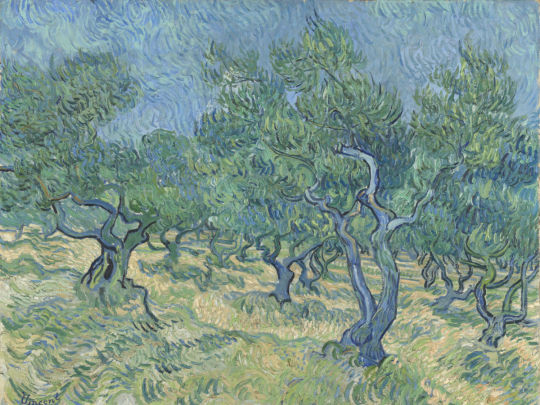
Vincent Van Gogh
Texture Texture refers to the surface quality of an object. Texture is an important component of a successful composition because it appeals to our sense of touch. This is true even when we do not actually touch an object our memories provide the sensory reaction or sensation of what that object might fell like if touched. Texture becomes one more element for us to think about when we look at any composition.
In effect, the various light and dark patterns of different textures are visual clues for us to enjoy the textures vicariously. Of course all objects have some surface quality even if it is only unrelieved smooth flatness. The element of texture is illustrated in art when an artist purposely exploits contrast and surfaces to provide visual interest.
There are two categories of artistic texture - tactile and visual (actual and illusion).
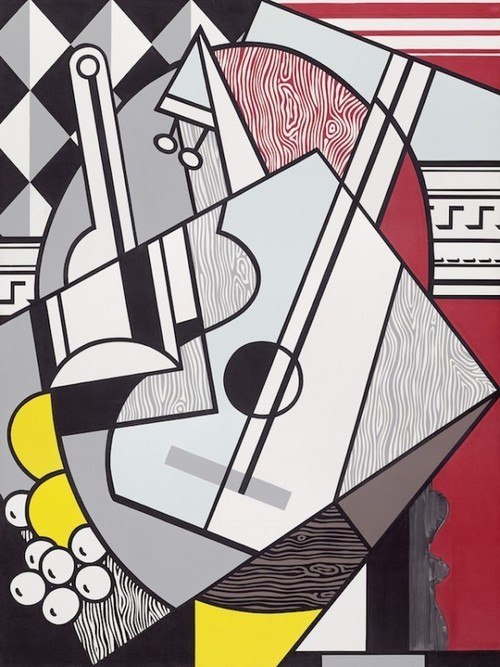
Roy Litchenstien, cubist still life, oil on canvas, 1974

AIGA poster
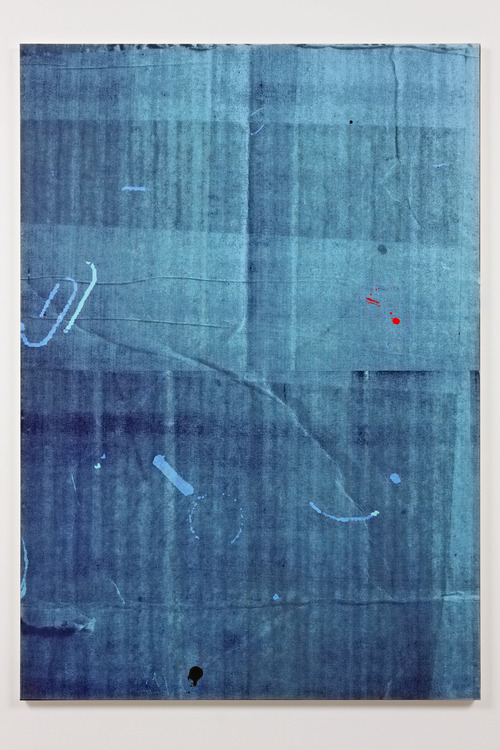
Alex Hubbard, SK 23, Silkscreen print, oil and enamel on canvas /wooden stretcher, 72.05 x 50 x 1.57", 2009
Tactile Texture Tactile texture is texture that can actually be touched. In painting texture describes the uneven paint surface. In graphic design texture can add a sense of reality “realness”. Things that seem more real to life often result in a more emotional response from the viewer, and can in turn be more memorable.
Architecture and sculpture employ actual material and have what is called tactile texture – texture that can actually be felt. In painting the same term describes an uneven paint surface, when an artist uses the paint (a technique called impasto) so that a rough, three dimensional paint surface results.
Consider Vincent van Gogh‘s painting from the top of this lesson. Texture is not just created through the pattern of short brushstrokes, but it is also created through the ridges and phrased edges of the paint strokes that are obvious to the viewers eye. The painting is revealing what it truly is– Paint on surface– Not just an illusion. Same goes for Thiebaud’s painting below:
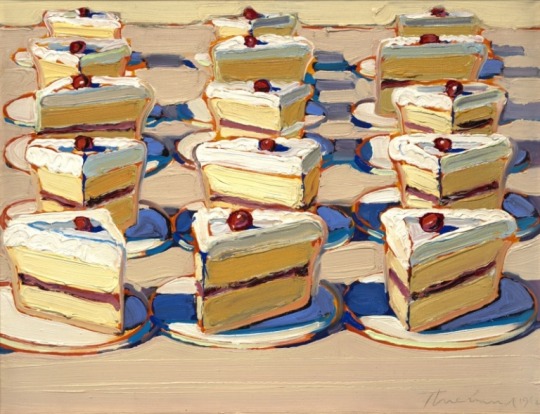
Wayne Thiebaud, “Boston Cremes”, 1962
As we’ve been exploring through this class a traditional idea of a collage is gluing down pieces of colored and textured papers cloth and other materials. Collage moved from a folk art to A fine art in the 20th century. Collage allows us to Play with compositional arrangements more easily by cutting reshaping and altering images and moving them around before pasting them down.
Anne Ryan worked mainly in collages of cloth. Her closet show various bits of cloth and contrasting leaves and textures interspersed with some scraps of printer paper. The light and dark pattern is interesting but her attention is mostly drawn to the contrast of tactile textures. See below:

Anne Ryan
VISUAL TEXTURE:

Anslem Reyle, Untitled, mixed media on canvas, metal frame, 256x205cm, 2007
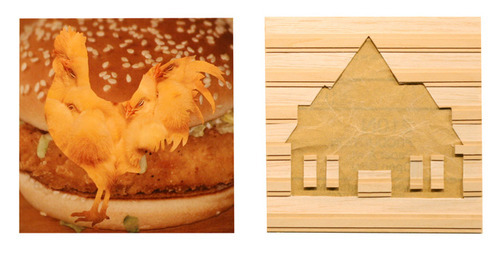
Texture can also be created through the illusion of texture. By reproducing the color and value of patterns of familiar textures, artists can encourage us to see textures where none actually exist. Visual texture carries the same visual punch as Tactile texture. Visual texture can also be created with photography, used on its own or as a filler for a shape, foreground or background.
In painting artist can create the impression of texture on a flat smooth paint surface. By reproducing the color and value patterns of familiar textures painters can encourage us to see textures where none actually exist. This is called visual texture. The impression of texture is purely visual – an illusion - it cannot be felt or enjoyed by touch. It is only suggested to her eyes. Artists use this as a way to stimulate the composition and move your eye around the surface. Various textures can convincingly be re-created. Visual texture can be an interesting design element even without subject matter or any pictorial reference.
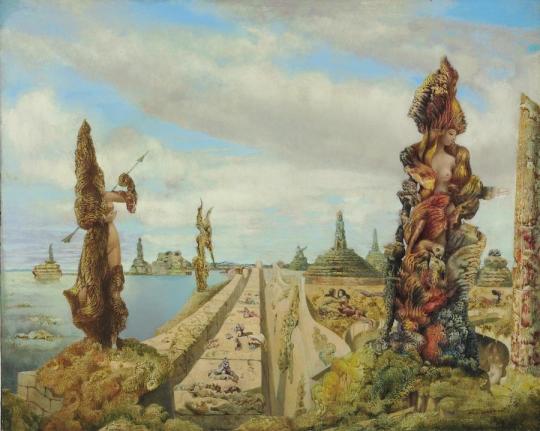
Max Ernst, Surrealist painter
The ultimate point in portraying visual texture is called trompe l’oeil the French term meaning to for the eye. This style is commonly defined as deceptive painting. In trompe l’oeil the objects in sharp focus are delineated with meticulous care. The artist copies the exact visual color and value pattern of each surface. A deception occurs because the appearance of objects is so skillfully reproduce that we are momentarily fooled. We look closer, even though our rational brain identifies the image as a paining and not the actual object.
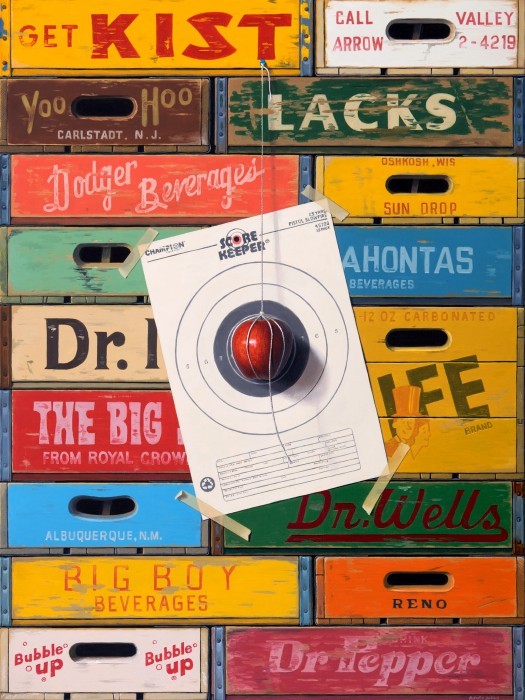
Robert C. Jackson
20th century artistic emphasis has been on abstraction, distortions, and non-objective patterns. But in much art the trompe l’oeil tradition continues And is not limited to painting. Marilyn Levine works in ceramics as seen in “Thom’s Jacket” from 1989 below. it is incredibly realistic but again it’s made of ceramics and is an illusion.
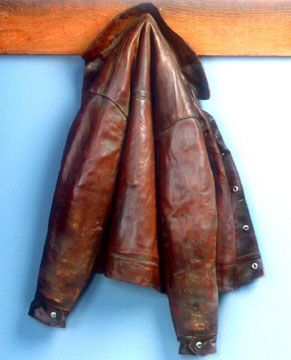
Texture and Pattern It would be difficult to draw a straight line between texture and pattern. We immediately associate the word pattern with printed fabrics such as plaid, stripes, polkadots and floral patterns. Pattern is usually defined as a repetitive design, with the same motif appearing again and again. texture, too, often repeats, but it’s variations usually do not involve such perfect regularity. The difference in the two terms is admittedly slight. material such as burlap would be identified right readily as a tactile texture. Yet the surface design is repetitive enough that a photograph of burlap could be quite a pattern. Once a visual texture is represented within the confines of a space or shape it often may look flat to our eyes and take on the characteristics of a pattern.The essential distinction between texture and pattern seems to be whether the surface arouses our sense of touch or merely provides designs appealing to the eye. While every texture makes a sort of pattern, not every pattern could be considered a texture.

David Lynch, Twin Peaks, film still, 1990
Pattern is a great way to distinguish between areas of contrast on an image and compositions.

Barry McGee
Pattern inspiration There are many artists, designers, and architects that employ beautiful, intricate and complex patterns. I’ve compiled the “best of” collection to inspire you for your Patterns Assignment. Each image is accompanied by a short description of the artist/designer/architect/etc., and each name is hyper-linked to their website (if applicable), so you can get more details on the people that inspire you the most.
Sol LeWitt, whose deceptively simple geometric sculptures and drawings and ecstatically colored and jazzy wall paintings established him as a lodestar of modern American art.

Installation view of Sol LeWitt’s Wall Drawing #260 at The Museum of Modern Art, 2008. Sol LeWitt. Wall Drawing #260. 1975. Chalk on painted wall, dimensions variable. Gift of an anonymous donor.© 2008 Sol LeWitt/Artists Rights Society (ARS), New York. Photo © Jason Mandella

Sol LeWitt, Drawing 915.013

Sol LeWitt, Wall Drawing #260
Le Corbusier (born Charles-Édouard Jeannere) was a Swiss architect, designer, urbanist, writer and painter, famous for being one of the pioneers of what now is called Modern architecture or the International style.



Bridget Riley British painter and designer. She shows a complete mastery of the effects characteristic of Op art, particularly subtle variations in size, shape, or placement of serialized units in an overall pattern.

Bridget Riley,
Blaze 1, 1962
, Emulsion on Hardboard, 43x43 in

Bridget Riley,
Descending, 1965,
Emulsion on Hardboard, 36x36 in.

Bridget Riley, Parade I, 1999-2000, oil on linen, 89 5/8 x 206 ½ in / 227.7 x 524.5 cm
Robert Zakanitch paints lace and embroidery. His patterns are beautiful and speak to the shifting instability of texture.

Blue Birds (Lace Series) oil on panel, 2001.

Flowers doily painting. Robert Zakanitch
Take a close look at the figure-ground relationship in the works by M.C. Escher, who is most known for his impossible architecture and landscape drawings, showcasing his play on perspective and point of view to create structures which ultimately cannot exist. I have always been more captivated by Escher’s pattern works. His ability to create a fluid and seamless plane of repeated images fitting perfectly together is both unrivaled and inspiring.
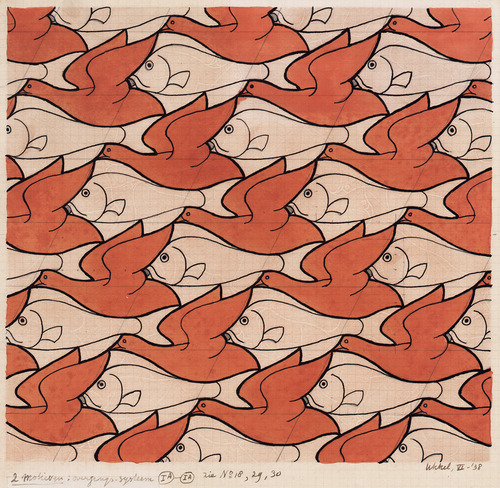
Bird/Fish, June 1938, Drawing, 228 x 243 mm (9 x 9 5/8’’)
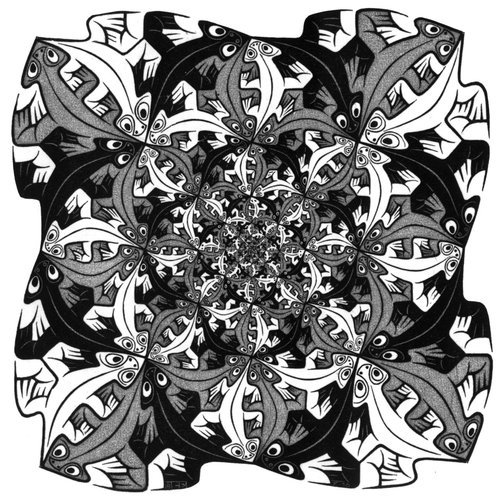
Smaller and smaller, drawing 1956.
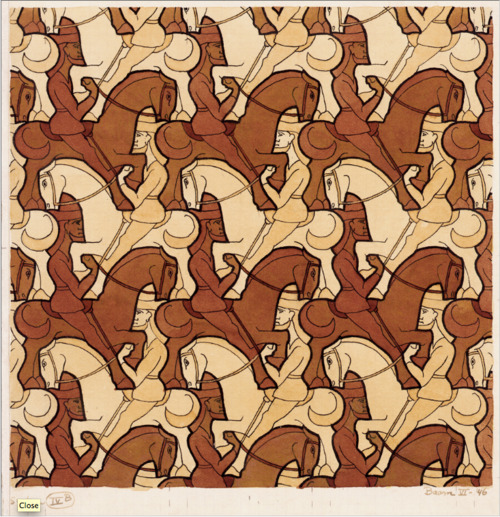
Horseman, June 1946, Drawing, 213 x 214 mm (8 3/8 x 8 3/8’’)
Another great example of pattern can be seen in Islamic art & architecture.


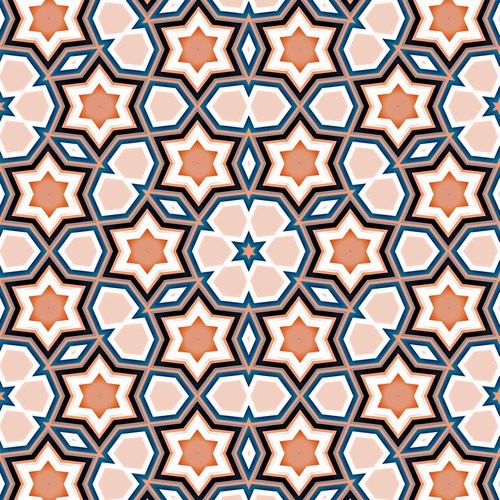
Japanese paper is another beautiful source for pattern inspiration.
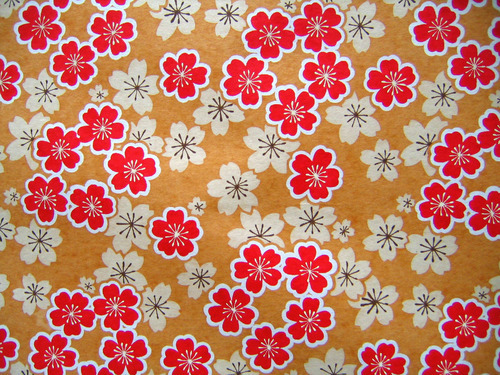
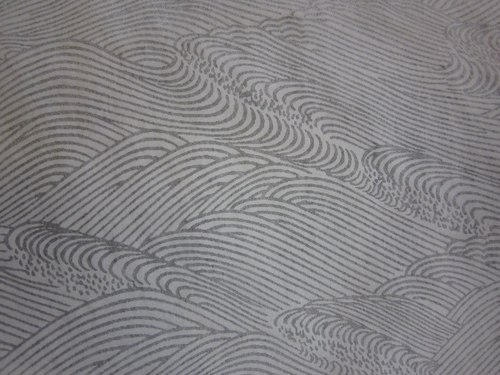
Navajo Weaving has a unique look, drawing from its Spanish and Pueblo history and nomadic way of life.



Traditional Amish Quilts lend patterns that have beauty in simplicity. Modern quilt artists are using black with solid colors and discovering the beauty in such basic designs.



Stephen Westfall











African Textiles are infused with spiritual and mythical meaning in the actual pattern designs on the cloth. Specific patterns are also used as a form of identity with each tribe having their own unique patterns.
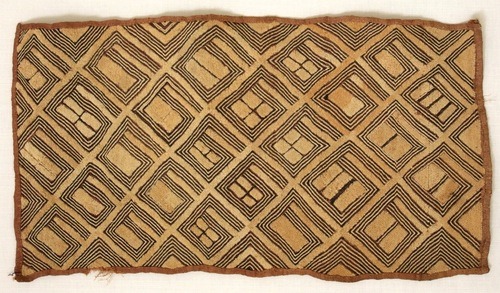
A man’s cloth of the Asante peoples, Ghana, c. 1960. Photo: E. G. Schempf.
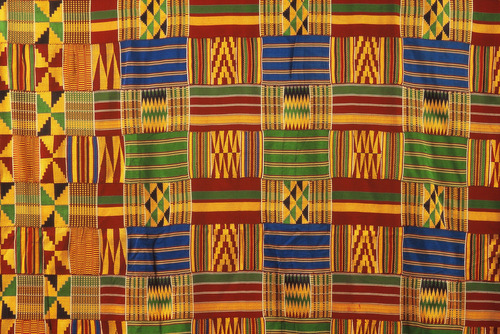
A man’s cloth of the Asante peoples, Ghana, c. 1960. Photo: E. G. Schempf.

Kente Cloth, Woven by men on a narrow loom. Found among the Asante in Ghana and associated with royalty. Both silk and cotton are used.
El Antasui
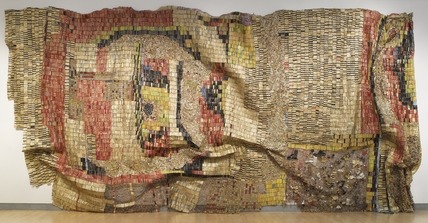
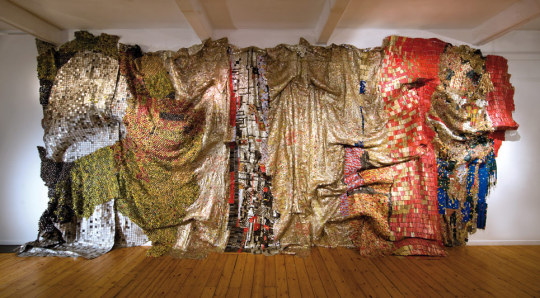

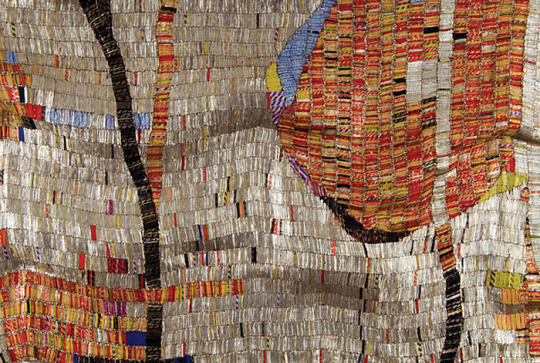
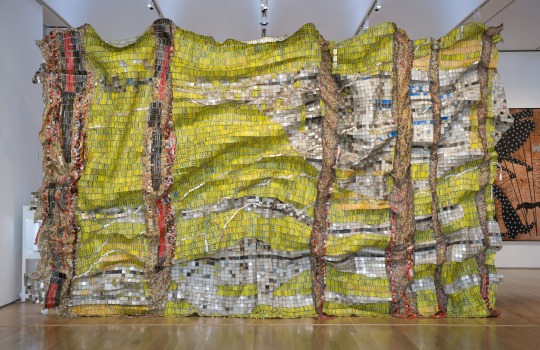
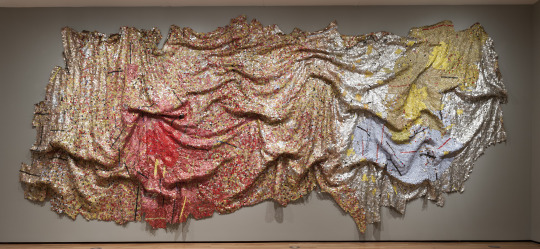
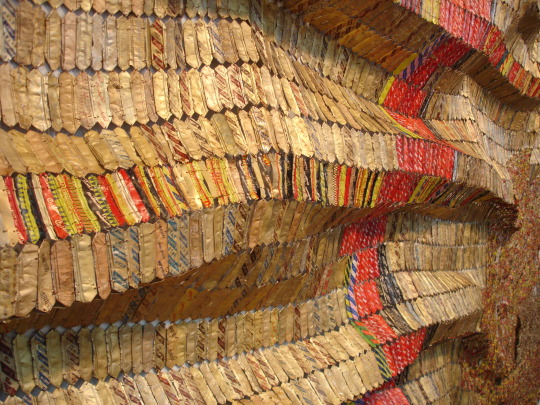
Takashi Murakami

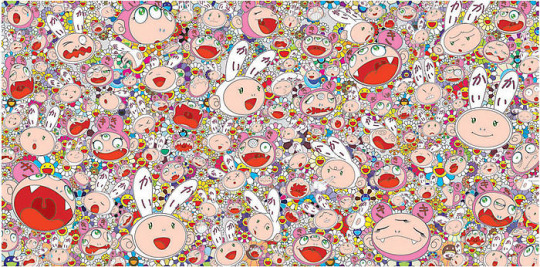
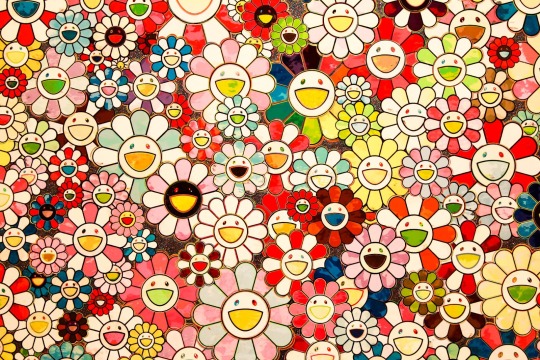
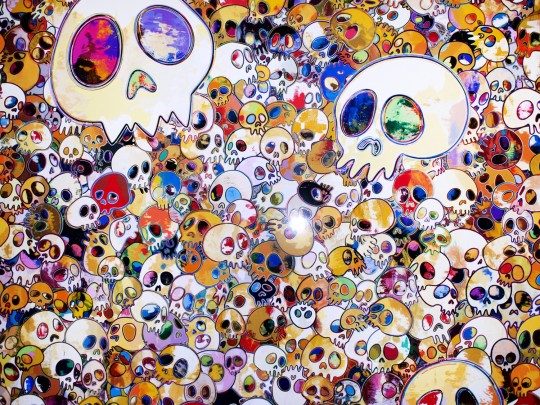


Polly Apfelbaum


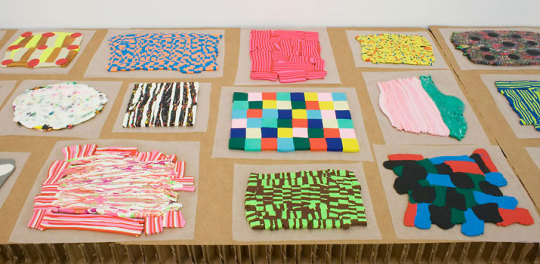
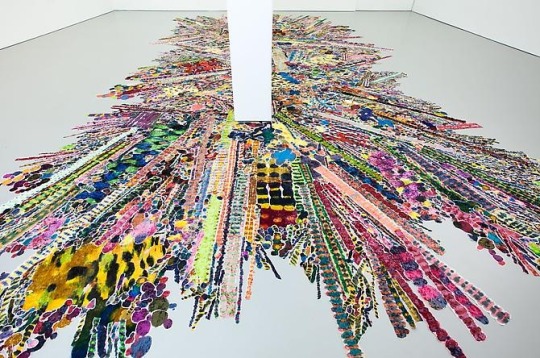


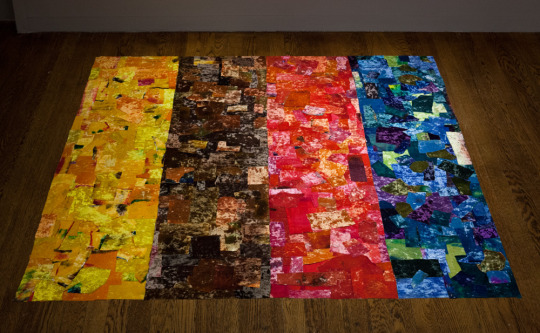
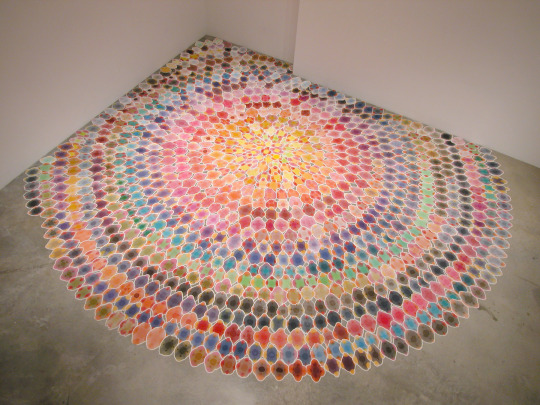




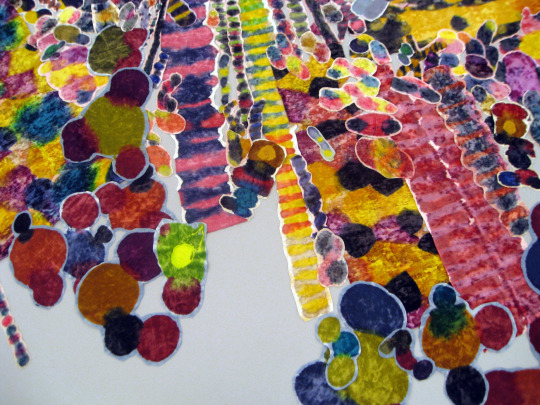


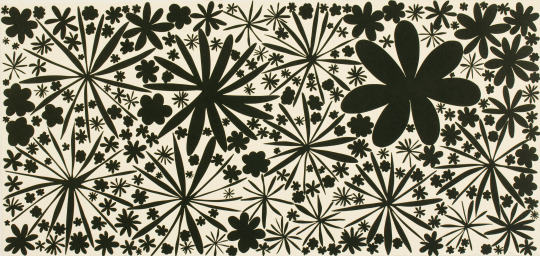
Marc Handelman

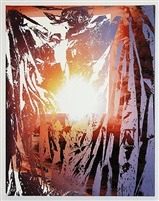







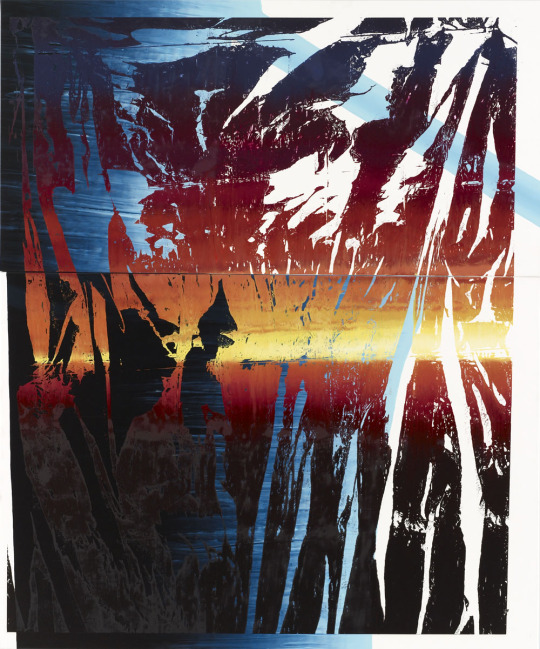






Katherine Bernhardt
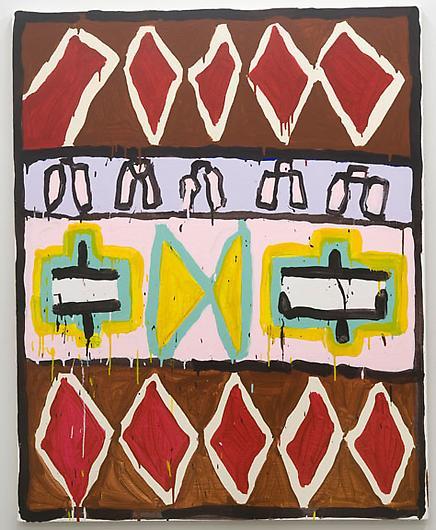
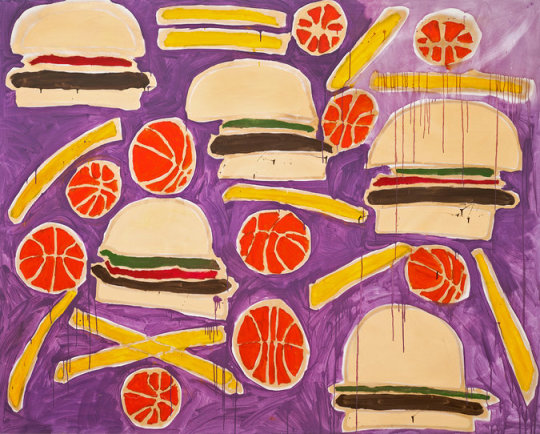
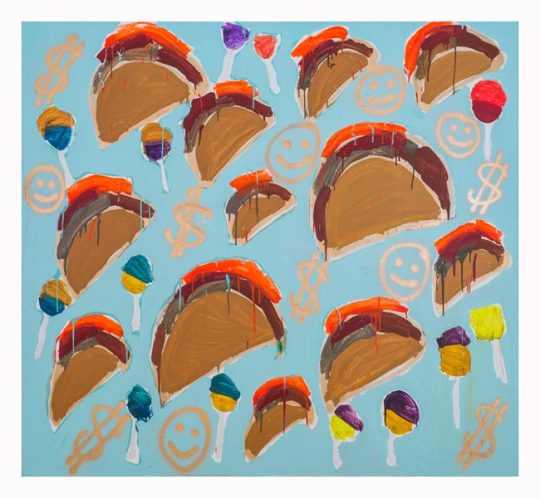
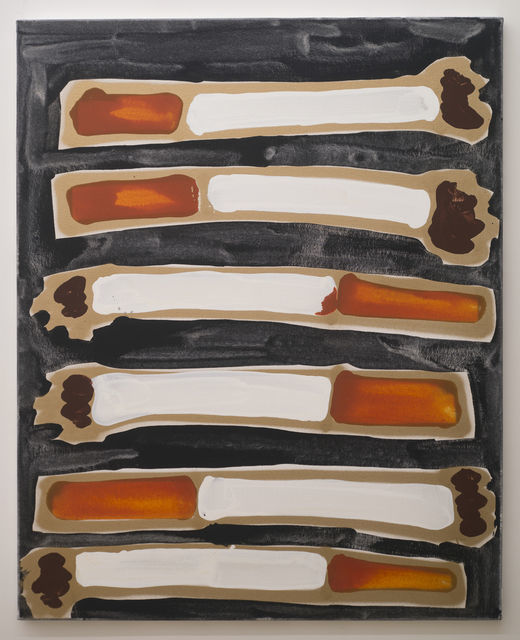

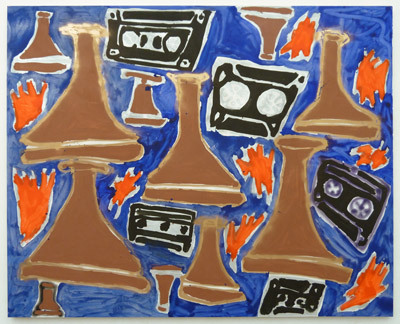
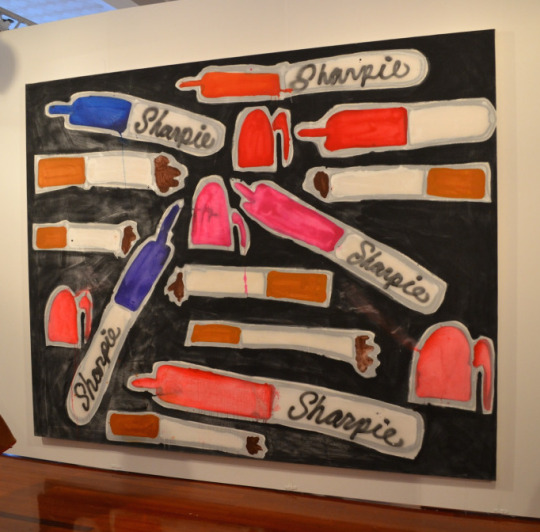
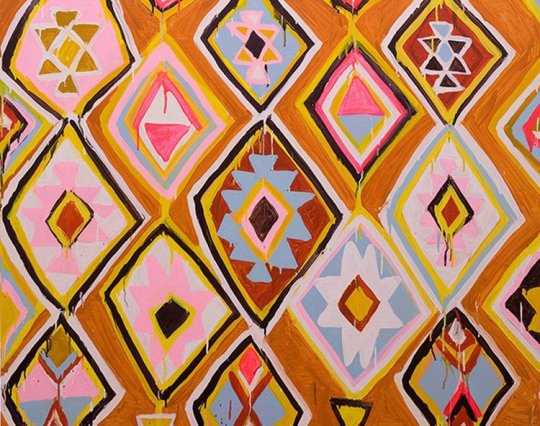
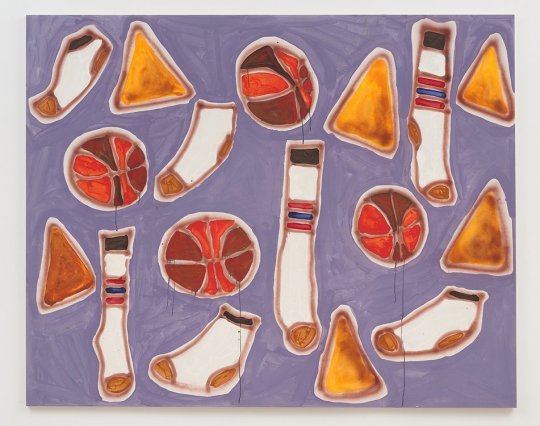
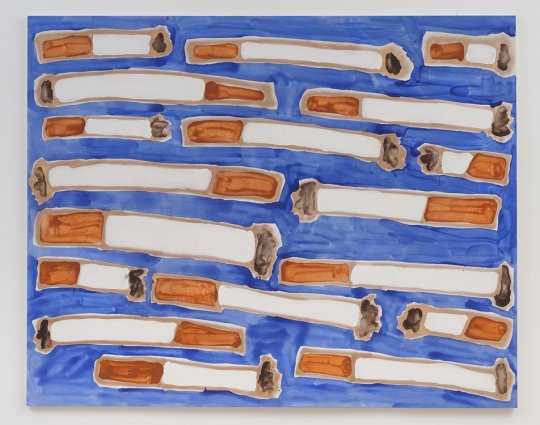


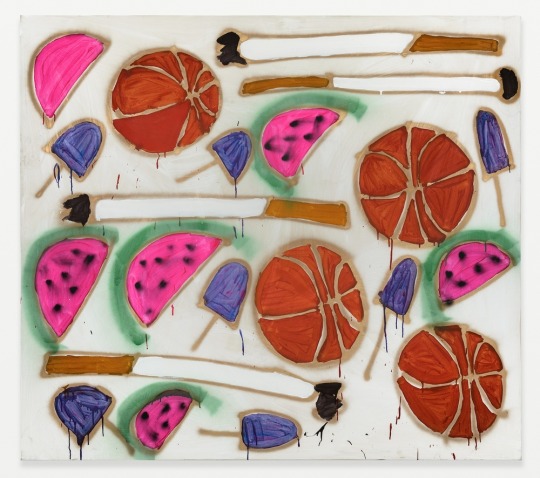
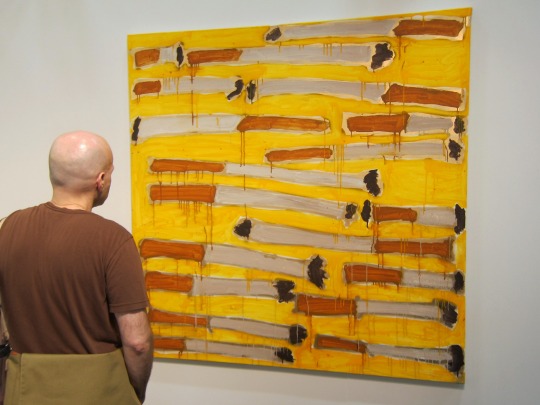
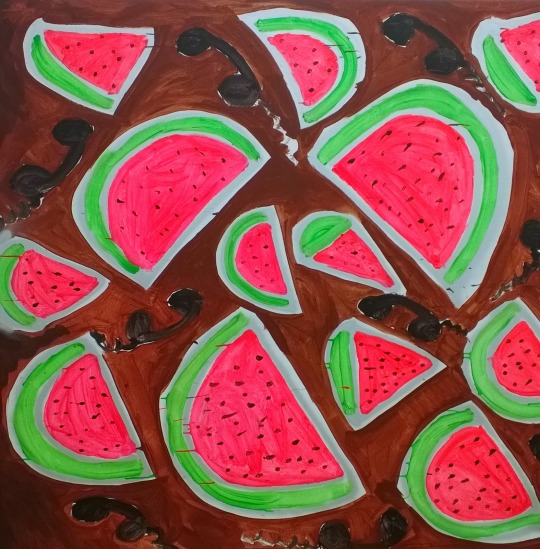
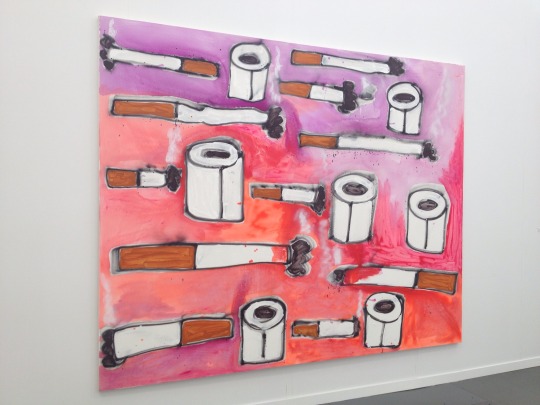
Texture/Pattern Project 1. In your sketch book draw out at least 4-5 distinct textures or patterns. Play and experiment. Look at the textures you might have around the house. How could you translate them onto a two dimensional surface? Draw each texture or pattern in a thumbnail shape (no less than a 1″x1″ square) this that you do not have to fill an entire page.
2. Once you have created your patterns and textures you will find an image that is of interest to you from a magazine, newspaper, picture, image you print out, etc.
3. You are going to recreate this image on a piece of bristol paper (if you don’t have access to your bristol you can use a piece of computer paper). You will recreate this image using the textures and patterns you created with your thumb nails. Each texture or pattern you use must replace a color/value in your original image. You must choose your textures or patterns appropriately to convincingly recreate the value changes in the image with only a texture or pattern. Therefore you may want to tweak your original texture and pattern designs to account for apparent value changes in you image. If there is a darker area on your original image, you might want to make your pattern more condensed and smaller. If there is a lighter area on your original image, you might want to make the pattern larger and less condensed.
Also depending on your image you may need to create a few more textures or patterns. (Textures or patterns can also be specific to the image, for example: if wood is representing in your image then you may want to create a wood pattern for these areas of your image - you do not have to though.)
4. Your recreated image will be in back and white using the different patterns and textures to distinguish the areas of value. This project should be done in micron pen and sharpie. All colors and values in your image must be translated to a texture or pattern.
Project examples

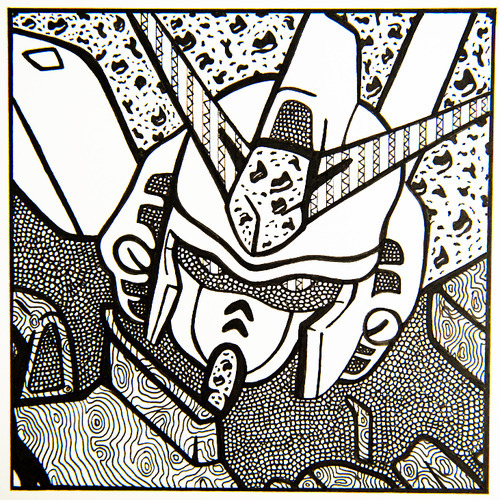
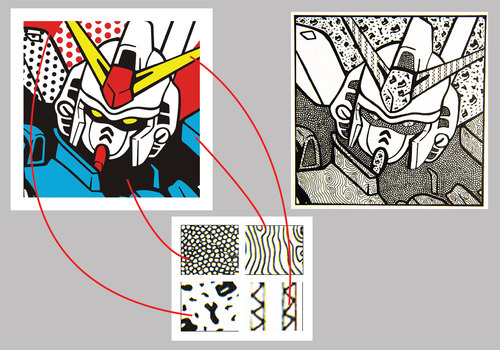
Final Product In the end you should have 3 part for this project. 1. The original image in presentation format on a piece of bristol paper. 2. Thumb nail sketches. 3.The final recreated image (on bristol paper) with all values converted to textures and patterns.
*Again if you do not have access to your bristol paper you may use computer paper.
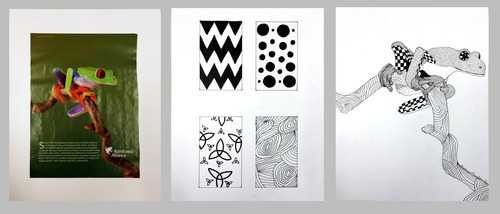
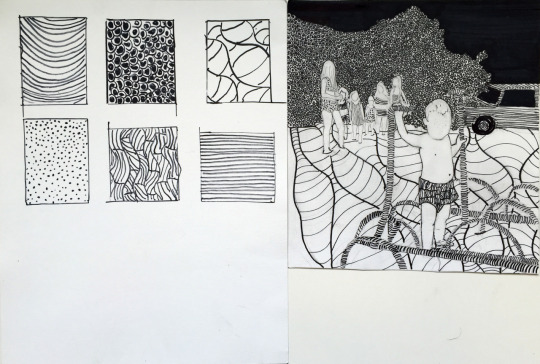
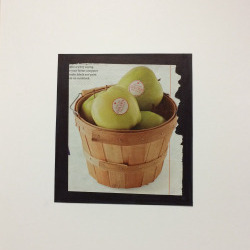

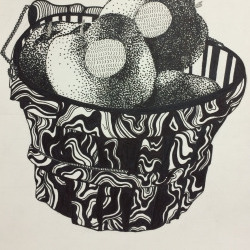

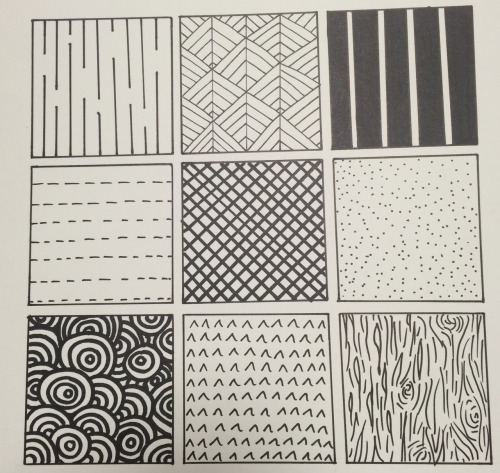
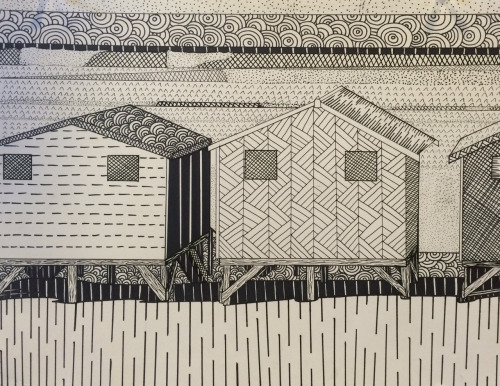

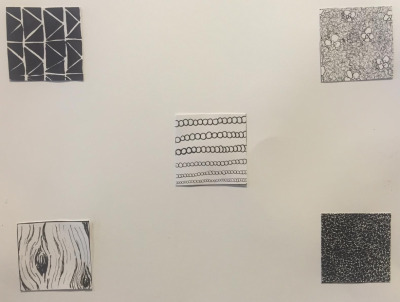
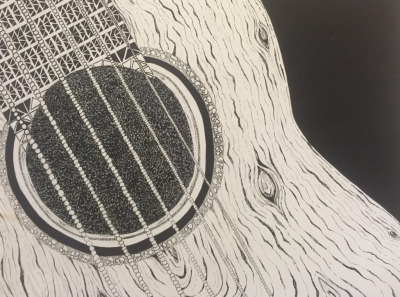
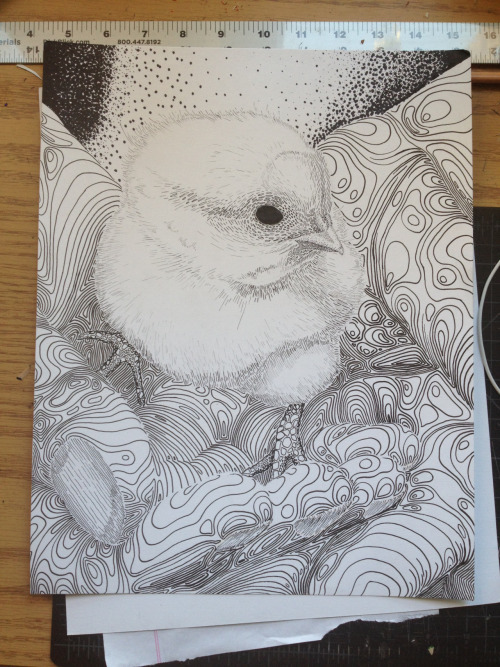
9 notes
·
View notes
Text
When we have sufficiently tortured each other: the ugly review
Disclaimer: I want to talk about the play, but the thoughts in my head are still pretty much an incoherent mess and they’ll probably never make sense because the experience that was watching her live was just too overwhelming for my brain to have registered something resembling a logic thought. Therefore, this will, without a doubt, be the worst review in the history of reviews! I apologize in advance but I really wanted to write this down. Also, it’s gonna be inappropriately long..
First thing first, I wanted to talk about Cate’s incredible and outstanding performance. I thought I had already seen Cate masterfully use a wide range of emotions, and I thought I couldn’t appreciate and admire her acting and the way she’s able to give life to characters, each with their own peculiar shade of personality, more than I already did, but every time I watch something new of hers I’m left positively shocked. It’s unreal how every character she’s played it’s so different and distinguishable from the others; just like snowflakes: no two are the same. And in the midst of these interpretations it’s impossible to detect traces of the real Cate or any of her other characters. Her expressions are different, the way she talks, the way she smiles they are all incredibly unique. She’s able to give depth and credibility to every single character, making it impossible to see one of them in any of her previous work. The character/s she portrays in this play are probably the most intense I’ve seen her playing. From the first moment she enters the stage, from the very first word she says in a voice that’s as gravelly as it can get, all the attention is immediately and inevitably drawn to her. All the actors have been incredible, but let me tell you that there is something about her that makes you forget she’s even acting, which is even more of a challenge considering that theatrical interpretation is inevitably dramatic and purposely over the top, yet she manages to make it look effortlessly real!
She interprets both the woman and the man, switching majestically between these two characters. She takes off her wig and wears her slacks and she becomes a man, there is no Cate Blanchett, no Pamela (her character’s name) there is not a trace of femininity in her anymore - she becomes the man, within the span of a second. Her accent changes, as well as her voice, and her every movement of her body is channeled into giving life to this violent, aggressive and dominant male character. She can outstandingly switch from being a passive and fearful woman, being dragged down and abused, to being the controlling abuser. I was utterly mesmerized seeing her flirting in a sweet innocent voice, to seducing with such confidence, to crawling across the stage, to losing her shit perfectly resembling the definition of neurotic. Her performance is the most intense thing I’ve ever seen, I don’t know how to describe what I saw, all I could say is that it feels like she’s a burning fire, a powerful tornado capable of destroying everything simply with the sound of her voice. She’s untamable.

They play, as you may already know, explores the issues of gender roles in a relationship, and what I liked about it is that the point this adaptation is trying to make is not entirely clear, you’re left wondering. It’s not there to teach you something, but to provoke a discussion. It’s open to personal and subjective interpretation, so what I got from it might be completely different from what others have understood. What I got from it is that most of the behavior we adopt is not embodied in our genders but rather in the concept of them, in the abstract idea of what a woman and a man should be like and what society expects from us, which is a great force we’re all, one way or another, subjected to, and that inevitably chases us even when we’re trying to escape from its cages. It was controversial and chaotic, and this is why I understand that a lot of people were left disappointed, because unlike most things we’re used to and we, as flawed human beings need, this play doesn’t produce any clear explanation.
Now, a quick list of the (unserious) very random things that were the cause of my early death. I apologize for the trashiness.
First thing that had my breath hitched: this part 👇🏼 happened in the beginning, and just let me tell you that this picture was taken at a very wrong angle, because what you can’t see is Cate lifting up her skirt leaving the audience with a nice, killer view of her bottom. All of that done deliberately in a teasing manner. She then took his hand and placed it on her ass...

Cate’s skin is smooth!!!!!!! I swear, even from a distance it looked like it was made of the purest silk.
HEART ATTACK ALERT 🚨 This woman literally crawled on top of the hood of a car! Imagine her walking around the vehicle, position herself behind it, jump on it with such grace and sensuality, and then crawl on top of it. I gasped so loud that the lady next to me gave me a side-eye.
She also crawled across the floor on all four.
I was utterly, irredeemably, overwhelmingly shocked to see her ass. I guess it’s mainly because Cate has always been one of those actresses who doesn’t seem very keen on exposing her body, even if it’s for a job, so I certainly wasn’t expecting THAT, but oh boy she did it... she stripped down to that bodysuit corset, and you think that the skirt she’s wearing over it is gonna stay on, but nope, the skirt comes off as well and let me just say... we had a full view. So much for not working out, woman! Ps. Refraining from giving too many details. Pps. It is not objectification, as once Sandy Bullock said, I’m appreciating!!!
In my opinion, one of the sexiest things, is when she sat the man down on a step, she unzipped her man’s slacks ⚠️BDE⚠️, dropped to her knees, and spread the man’s legs. THE POWER.
Yes, the rumors are true. She had the audacity to moan for a few minutes straight on stage. How dare she? I’ve never been more grateful in my entire life for Cate Blanchett’s willingless to take risks. I could write a whole page about those 2 minutes alone. I’m just gonna leave this with her quote: “put your hand here,” said Ms. Blanchett lifting up her skirt.
At one point the couple engaged in very “adult activities”, she was leaning against the car, back on the side door, the man on top of her, and one of her legs was oh-god-so-sensually propped up against what looked like a bookshelf to support herself, and THAT my dear friends, it’s something I’ll never be able to forget. My brain stopped functioning, so much so that I accidentally dropped my purse, which clattered loudly on the floor!!!
She’s 49 and her body is one of a 25 year old. That woman is an immortal goddess, and no one can say otherwise.
Her strap is black and, unsurprisingly, big... we thought she already had a BDE, but this is a whole other level. She wears it in the most natural way, never failing to be sensual.
I don’t think it’s humanly possible to be able to be equally sexy wearing a lacy corset and leather garter belt suspenders, AND a man’s suit, but Cate... she does, she can, she’s the one who can do both!
As Oceansgate mentioned before her voice sounded like Carol’s at some point, but at some other points it sounded exactly like Hela’s, especially when she was playing the dominant character, and I’ve never felt weaker!!!
Okay, that’s it for now, if something else comes to mind I’ll write it down. For now, enjoy this! If you’re curious about some more in depth details message me here, and I’ll be happy to be as thorough as I can be 🙈
Quick update: my mother found out what the play’s about hahaha I want to die.
#cate blanchett#when we have sufficiently tortured each other#this review is trash#lol im sorry#i got carried away#but believe me it could have been way worse#im still not functioning properly#tbh i dont think ill ever be able to recover from it#im gay#bye
174 notes
·
View notes
Text
How could Lemony know about the dialogues and events?
This is Part 2 of Strange Interpretation by Jean Lucio From Brazil.
It is a strange fact that for me to prove that Lemony is lying on purpose in some passages of his work in ASOUE, I have to first prove that he has seriously endeavored to write truths in most of his work. But the theory is called "the Strange Interpretation of Jean Lúcio from Brazil", so strange things will appear here. Strange, but fruits of reasoned ideas.
I believe the good liar is not that person who lies all the time. People like that lose credibility and stop fooling anyone, even when that is necessary. Good liars speak the truth most of the time, gain the confidence of others, and choose the moments of using lies with surgical precision. Good liars deceive people for generations, and I believe that Lemony is a good liar.
I will demonstrate that it is possible to distinguish what is true from what is false in ASOUE.
Apparently, there are no intentional lies about Sunny, Violet and Klaus told by Lemony Snicket in the 13 books of ASOUE. Lemony claims that his work on these children is the fruit of a promise. At ATWQ we realize that Lemony is someone who gives great value to keeping his promises. In addition, in a personal note found in the UA in chapter 1, Lemony Snicket wrote:
"It makes me sad to think that my whole life, from to cradle to the grave is full of errors, but at last that will not happen to the Baudelaires."
As I explained in my previous text, the documents found in the UA were not written for the Great Public in the universe of Lemony. The passage comes from a personal note, so logically Lemony would not lie to himself.
So, you can trust that the whole main story of ASOUE is true.
This phrase matches the reports Lemony Snicket wrote about his own research on the events involving Sunny, Klaus, and Violet. Lemony seems to seek physical evidence of the smallest details about the events surrounding Beatrice's three children.
Besides that, the letters to the editor were not written for Lemony's large audience, so these letters also have credibility.
Thus, if there are intentional lies in the 13 books of ASOUE they could only be found in the following excerpts:
1 - In the dedications.
2 - In the descriptions of the events involving the own Lemony Snicket and Beatrice.
3 - In the descriptions of situations that were occurring during the writing of books that did not directly involve the Baudelaire siblings.
4 - Description of events related to other minor characters that occurred at different moments of the main events narrated in the books.
Of course, just because Lemony might be lying in these snippets, that does not mean he's actually lying. I just want to point out that Daniel Handler made a point of highlighting in the UA that the story about Sunny, Klaus and Violet are true, and the result of Lemony Snicket's research, not the result of Lemony Snicket's imagination.
But that raises another question: How could Lemony Snicket know about events involving Sunny, Klaus, and Violet with so much detail? For example, in some scenes, Sunny, Klaus and Violet talk to each other on their own. How could he know the content of these conversations? In addition, some events would be impossible to deduce only through observation or interviews. For example, in book 10 of ASOUE, Lemony narrates events inside the caravan, however Lemony states that he could never find what was left of the caravan after trying to find it for several months. How could Lemony know about the parachute built by Violet? What about the sticky mix that Klaus created to slow down the caravan?
Or how could Lemony know about what the Baudelaires talked about while they were on their own at Queequeg?
Lemony would need to have a source of reliable information on these matters, and only source of reliable information would come from the Baudelaires themselves.
The answer of my theory to this question is based on the following premise: In writing the 13 books of ASOUE, Lemony Snicket was writing about a past many earlier. When I talked to D., I realized that this is a premise questioned by many fans in the United States. D. explained to me that for many fans Lemony's references to the many years that have passed between the events and the publication of the ASOUE books are Daniel Handler's mistakes, or evidence that Daniel Handler changed his plans during writing of his books. I do not agree with this. Of course, maybe I'm wrong, and I do not want to accept that the books I love so much have such absurd mistakes.
Another theory involves a complicated plan involving notes delivered to Kit. These notes would be revised years later and then published. I must agree that this theory is very intelligent and that makes a lot of sense. But for it to work, you have to believe that Lemony in revising his work failed to remove secret messages to Kit. In addition, this theory does not explain how Lemony could know about dialogues and events experienced only by the Baudelaire siblings. The 'Strange Interpretation of Jean Lúcio From Brazil' presents an alternative theory, which some may believe to be better, (or not).
First, so that I do not contradict myself, I must show that in books other than the 13 books of ASOUE or in the letters to the editor, there is evidence that years have actually passed between the events recorded in the 13 books and their publication.
One important note: I believe that all UA chapters are true. I do not believe that the initial 12 chapters deal with a long, frosty introduction. That's because the "13 Shocking Secrets You'll Wish You Never Knew about Lemony Snicket" pamphlet states that UA is a safe source of research. I explained in my previous text because I believe that this pamphlet is Daniel Handler's text on ASOUE which for me has more credibility.
I am aware of what is written between chapters 12 and 13 of the UA. "There was a long pause, and I realized this curious stranger was at last done telling this confusing and unnerving story. Without another word the storyteller handed me this packet of material, which I give you now. ' However, these phrases do not make sense. First, what we find in the first 12 chapters is not a storytelling, and so there is no storyteller. There is a storyteller only in the UA introduction. In my theory, these phrases are an attempt to drive away from the interest in the book those people who read the introduction of a book, and then go on to the last pages. Such a reader, after reading the introduction of the UA, would go to the last pages, and then find the index, some photos and finally these sentences. He may have lost interest in reading the documents in the UA, believing it would be a boring read.
So in UA in Chapter 4, we find a letter from Sally Sebald to Lemony Snicket. In this letter she stated:
"What a relief it was to learn that you are alive and that Dr. Orwell is dead! For YARS I suspected the opposite, and assumed that one of yours siblings was handling your affairs, as I am handling Gustav's ... I hope that The crucial scene in Zombies in the Snow - beginning and ending, as always with the Sebald Code, with the ringing of the bell - was meant to deliver a message concerning the survivor mentioned in your letter, but my brother told me no more than this. "
You may deduce that this letter was written by Sally Sebald after the events described in TMM, that is, after the death of Georgina Orwell. For years, Sally Sebald believed that Lemony was dead, and Georgina was alive. The reference to 'years' in the plural makes me believe that really years have passed between the events described in TMM and this letter. It is interesting to note that when this letter was written, Lemony had already begun work on writing the Baudelaire case, but evidently Lemony was in the research phase on the subject. In addition, it is possible to deduce that in a previous letter, letter that we do not have access, Lemony informed that he was alive and requested information to Sally Sebald. It seems reasonable to believe that when Lemony wrote the first letter to Sally Sebald, he did not yet have the script of zombies in the snow at hand, for Sally found it necessary to describe the scene in which there was a Sebald code. In some later letter, Sally evidently sent the script of zombies in the snow to Lemony. In the letter Lemony sent to Dear Dairy in the same chapter, Lemony said:
"Remember, you are my second-to-last hope that the Baudelaire's ornaments may finally be told to the general public."
In this letter Lemony stated that he had the script of Zombies in the Snow in his hands. He wanted to return the script to Sally Sebald, however, Sally Sebald did not attend the meeting. So Lemony decided to send the script to his cheesemaking friends. For some unknown reason, these friends of Lemony could not even publish one of the ASOUE books. So Lemony had to turn to his current editor, which was the last hope for him to finally be able to publish the ASOUE books.
When Lemony sent the manuscript of TRR to his current editor, Lemony also sent the Zombie Manuscript in the Snow, according to the letter to the editor found at the end of book 1. At the time he wrote the letter, Lemony stated who was in London to find out what happened to Unty Monty's collection of reptiles. Thus, this scenario seems to indicate that between the day Lemony sent the "Zombies in the Snow" script to cheesemakers and the time Lemony sent the same script to his current editor, there was a considerable time. Lemony needed to retrieve the script, then he traveled to London and then sent the script to the current editor. Apparently Lemony did not make a copy of the script, because in his letter to the cheese makers, Lemony says it would be too dangerous to keep the scripts in hand. Why would he then make a copy of the same scripts?
A scenario where several years pass between the events and the writing of the books, it combines with some statements of Lemony during the writing of ASOUE. These observations do not seem to be lies, for there seems to be no logical reason for Lemony to lie about them:
Chapter 8, book 2 - "You will remember, of course, that EVEN YEARS LATER, Klaus would lie awake in bed, filled with regret that he did not call out to the driver of thetaxicab who had brought Stephano into their lives once more . "
Book 5 Chapter 6: "Prufrock Preparatory School is now closed. It has been closed for many years."
However, after the publication of book 2 of ASOUE, Prufrock Preparatory School was still open, the Lemony Snicket went there to seek information after the publication of book 2, according to UA chapter 9. An enemy of Lemony also went to Prufrock Pre and found in the library there a copy of the TRR book that had already been published.
This means that the school stopped working between the publication of book 2 and the publication of book 5. After Prufrock Preparatory School was closed, Lemony spent many years without publishing in his universe. (In a later text I will explain this concept in more detail, in a theory I call "The Great Hiatus.")
Another detail can be found in Book 10 Chapter 13:
"Even for an author like myself, who has devoted his entire life to investigating the mysteries that surround the Baudelaire case, there is still much I have been unable to discover."
It is implied that the investigation into the mysteries of the Baudelaire affair has lasted a lifetime from Lemony's point of view, and not just a few years.
In the book Bad beginning the rare edition, Lemony says that he already knows about the Baudelaire siblings' third visit to briny beach, and that he wished to write about it in book 13 of ASOUE that he had not yet written.
The introduction of the notes in the book The Bad Beginning of the Rare Edition indicates that it has been since the publication of the Bad Beginning until the publication of Book 13.
So this whole scenario seems to match the fact that Lemony wrote and published his books years after the events recorded in them.
After these considerations, I will now explain what is the largest source of information found in ASOUE regarding Klaus, Sunny and Violet. In my theory the source of the information is the book called "The Series Of Unfortunately Events" that was on the island. I think Lemony, in his initial research on the Baudelaires, came to this island. There he found the book. Klaus, Sunny and Violet followed the custom of previous castaways and wrote about their own lives in that book. From the content of the book, Lemony was able to continue his research. As I said, Lemony said he already knew about events that took place on the island, and even events that occurred after the Baudelaires left the island before writing Book 13 in Lemony's universe. He planned to write about these events in Book 13. Note the following excerpts:
pp.116-117 A group of female Finnish pirates invented it back in the fifteenth century ...
Tomorrow afternoon, the semi-amateur geologist has promised to put me in touch with current members of the F.F.P. so I can determine if there is any truth to the rumor that Violet Baudelaire came into contact with her on her way to Briny Beach for the third time. Interested parties might turn to Book the Thirteenth, assuming I live to write such a book.
p.153 A certain island has a law that forbids anyone from removing its fruit.
Please see my article 116-117.
When Lemony wrote the notes, Lemony had not even written Book 13 yet. It is significant that in the introduction of his notes, Lemony again wrote that the publication of the ASOUE books in Lemony's universe took years.
"In the years since the book's publication, many people who have read the book have besieged me with questions concerning the iotas of the story, exactly how I came to know these iotas, and if I cared to add anything to my report."
It is interesting to note that Lemony's researches as described in the ASOUE books and as described in the TBB the Rare Edition notes are fact-finding surveys and are not searches of new fact discoveries. Look at these examples from The Rare Edition:
pp.41-42 From a street vendor, they purchased olives after tasting several varieties and choosing their favorites.
My commonplace book contains following interview:
LS: On the day in question, did three children-a fourteen-year-old girl, a boy a bit older than twelve who was wearing glasses, and a young baby with somewhat peculiar teeth-purchase from you some olives, after tasting several varieties and choosing their favorites?
Vendor: Yes.
p.142 No one seemed to notice that I held a walkie-talkie the entire time.
My commonplace book contains the following interview:
LS: On the night in question, during the performance of Funcoot's play The Marvelous Marriage, did you notice that Count Olaf, the production's start, was holding a walkie-talkie the entire time?
Audience member: No.
LS: How about you?
Another audience member: No.
LS: You?
Another audience member: No.
LS: You?
Another audience member: No.
etc.
(Note the following: if no one remembers having seen walkie-talkie, as Lemony knew there was a
walkie-talkie? For me the answer is: Lemony read about the walkie-talkie in the island book).
p.146 "But Violet is only a child!" one of the actors said. "She's not old enough to marry."
My commonplace book contains the following interview:
LS: On the night in question, did you say, "But Violet is only a child!" One of the actors said. "She's not old enough to marry."
Actor: I think so.
(Note that Lemony's questions are to confirm facts that he already had in advance.)
That's why Lemony knew about what happened in the Caravan because Lemony read about it in the book. So Lemony knew about the dialogues that took place in locked rooms, or that happened inside the elevator shaft, because Lemony read about it in the book. So Lemony knew about what the Baudelaires talked about when they were alone in Queequeg on the ocean floor because Lemony read about it in that book. The part of the book that told this whole story was written by the Baudelaires during the year they spent on the island. Thus, Lemony began writing ASOUE after the events that took place on the island.
Since before writing the first book, Lemony already knew of specific facts about the Baudelaires, which indicates that he has used the information from the island's book ever since he published Book 1. Thus, Kit had been dead since Book 1 was published . But almost nobody knew this, because she died on a distant island with few people observing her death. To me that's the only explanation that makes sense. As we have seen, Lemony would never invent dialogues and events about Sunny, Klaus, and Violet.
The only things that seem to contradict these conclusions are the following: Lemony's messages to his "sister" in books 9 and 10, the contents of the letter in book 10 which states that the Denouement hotel was fully operational when this letter was written, the statement in the same letter regarding a possible sugar bowl that Lemony is looking for during the writing of TSS, claim that Lemony could save his sister Kit while he was writing TGG, the letters to the editor at the end of book 11, which were written on paper coming from the Hotel Denouement indicating that this hotel was fully operational when these letters were written.
I will give the simple and brief explanation on these subjects according to the Strange Interpretation of Jean Lúcio from Brazil to be able to close this text, and in the future I will write other texts explaining in detail all these theories.
1 - The secret messages in books 9 and 10 do not have Kit as the true recipient. In fact they are letters to Beatrice. Lemony is lying in saying in his dedications and in his main text that Beatrice is dead. The reason Lemony decided to lie about it is his desire to protect Beatrice, the woman he loves. Beatrice faked her own death, and used her training as an actress to pretend to be other people. A few years after Kit's death, Beatrice went on to pretend to be Kit. Lemony, while writing the hidden messages to his "sister", was at the same time passing on important information to Beatrice and helping to cover up Beatrice's identity. By stating that the recipient is a sister, Lemony may be using one of the definitions of "brother" or "sister" found in THH:
"Sometimes brothers and sisters are just people who are united for a common cause."
2 - In TGG, where Lemony Snicket claims he can save his sister named Kit while Lemony is writing the book, Lemony is lying on purpose. He's doing it to protect Beatrice.
3 - Just as the Lost Arms Hotel was restored after a fire at ATWQ, the Denouement Hotel was also restored after the fire a few years later, probably over the years while books 1 through 9 of ASOUE were being published in Lemony's universe.
4 - The sugar bowl that Lemony claims is looking when writing the letter to his "sister" is not the same sugar bowl that belonged to Esmé. The sugar bowl quoted in the letter contained a proof capable of clearing Lemony. It was this sugar bowl that arrived through the crows at the Denouement Hotel and probably fell on the lake in front of the hotel, and stayed there until Lemony fetched it many years later. The esmé sugar bowl contained something capable of controlling the Great Unknown (probably a kind of whistle). Lemony apparently already has access to this sugar bowl when writing the 13 books of ASOUE. It was this sugar bowl that ended up in the Gorgonian Grotto after being released by the VFD's HQ window. This sugar bowl was removed from there by a woman before the arrival of Klaus, Sunny, Violet and Fiona in GG.
Thank you for reading until now, and until the next text of the Strange Interpretation of Jean Lúcio From Brazil.
Note: 1- in Lemony's letter to the cheesemaker, Lemony states that at least one of his siblings is dead. This already puts the writing of this letter as being performed after the events described in TVV. According to Lemony's letter to the editor regarding the events described in TAA (this letter is at the end of TMM), the Baudelaire siblings spent a half-semester, before the events narrated on TVV. So at the very least, you must recognize that a few weeks or few months passed between the events recorded in the books and the sending of the script of zombies in the snow for the cheese-makers. These cheese makers were not the final editors of ASOUE.
Note 2 - I believe Gustav Sebald is Uncle Monty's helper. They have the same name and both are dead. I can not prove that they are the same person, but before my theory, I see no need to believe that they are different people.
Note 3 - About Sally Sebald. In his note to the dairy Lemony clearly states that he is there to meet Dr. Sebald, a character he uses male pronouns for, and that this person produces movies which employ Sebald Code. With respect to the use of masculine pronouns, I find it important to consider that Sally Sebald took over the business of Gustav Sebald after his death. Probably few people know about Gustav's death, so Sally Sebald must be working using only the family name in her films. Sally herself believed that Lemony's services were being performed by one of his siblings. In Sally's mind, even Kit could have taken over Lemony's services. So, in order to conceal the fact that Sally Sebald has taken over the services of Gustav Sebald, Lemony uses the English language feature available to refer to a Doctor using the male pronoun, when the doctor's gender is unknown. This same feature is used in TMM, referring to Dr. Owerl.
Note 4 - The only part in ASOUE that would be completely dependent on the interview with Kit's daughter would be Chapter 14 of Book 13 of ASOUE. So I believe this chapter was written after Lemony's meeting with Kit's daughter.
#asoue#asoue theories#lemony snicket#beatrice baudelaire#beatrice is alive#desventuras em série#des#violet baudelaire#klaus baudelaire#sunny baudelaire#books theories
40 notes
·
View notes
Text
Interim Crit Project B (4/5/23)
My concept art project idea pretty much started from one character design which I then developed a world around.
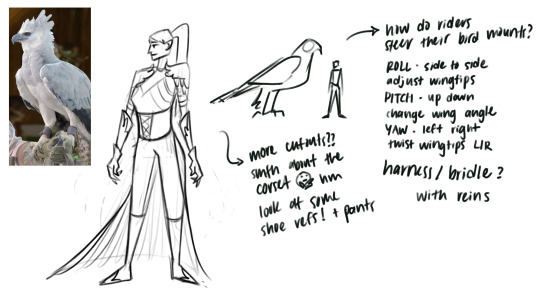
I've always loved birds, especially birds of prey like eagles, hawks, falcons, owls, etc so I wanted to design a character that was based on one. I took an image of a harpy eagle and incorporated characteristics of the bird with medieval fantasy armor. I wanted the armor to have pieces and flourishes resembling feathers, and the knight to have a cape like a feathered tail. The gauntlets are sharp to imitate the talons of an eagle and the overall silhouette is pointed. I kept shape language in mind and wanted the character to have a triangle shape to emphasize her dangerous nature as a warrior.
I think I ended up choosing a fantasy inspired genre because I've been reading a lot of fantasy books in the past few months. I used to be a really avid reader through elementary and middle school, and my favorite genre back then was anything to do with dragons and talking animals. One of my favorite franchises ever is How to Train Your Dragon, both the book series and movie trilogy. I fell off reading books when I started high school because the internet was much more accessible by then, but for 2023 I decided to get back into it!
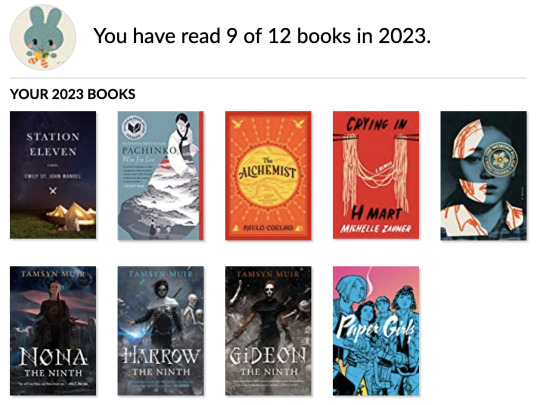
So far my 2023 Goodreads challenge has had a pretty considerable ratio of fantasy books, specifically the Locked Tomb series starting from Gideon the Ninth. The Locked Tomb is a bit of a mix of fantasy and sci-fi, but knight cavaliers and necromancer sorcerers are pretty central to the story, which definitely led to the knight decision.
From the character design, I started thinking about what kind of world this knight could inhabit and why would her armor be so heavily inspired by birds. The two main influences that I combined to create the world this character design by Airi Pan and the Great Eagles from Lord of the Rings.
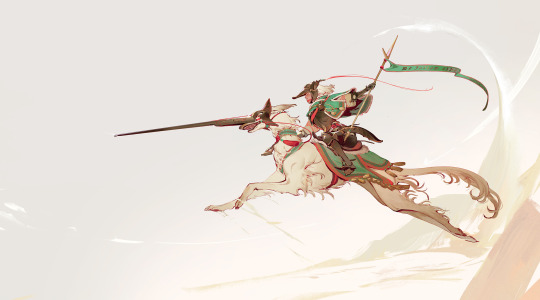
I love the idea of taking any animal and having it become a knight's trusty mount, and the Great Eagles already set precedent for large birds that can be ridden, so I decided to create a world based on the concept of eagle knights.
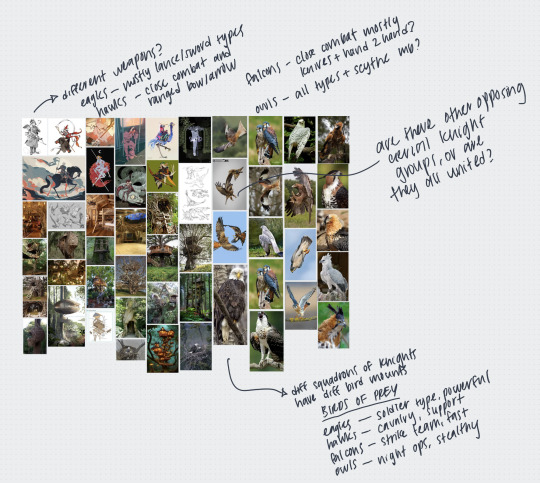
I started gathering references for the influences that I want to go into the world, from fantasy medieval knights to birds of prey, to treehouses and bird nests. I took notes on areas that could be fleshed out for worldbuilding purposes, thinking about different classes of knights and their different bird mounts.
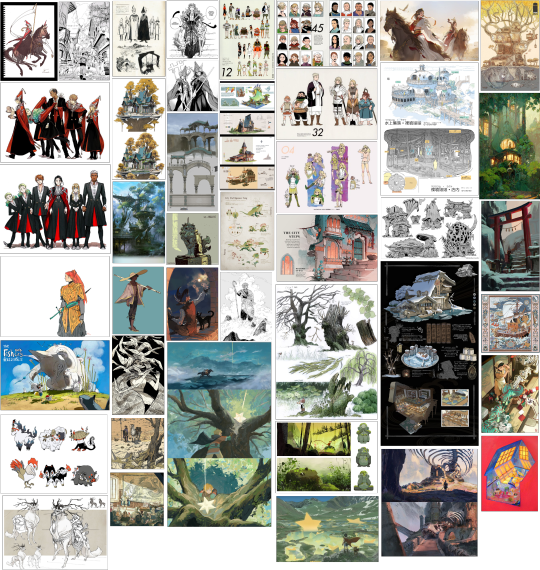
Next, I also created a reference board of visual development art. I wanted to have a lot of different types of concept art to reference and prompt me to think of different aspects of worldbuilding. Two manga titles that really inspire me are Witch Hat Atelier by Kamome Shirahama and Dungeon Meshi by Ryoko Kui. Both are manga series written and illustrated by women, and are set in incredibly lush fantasy worlds.
I was inspired to start reading Witch Hat Atelier after hearing that it has great representation of disability and darker skinned characters, which is really rare for both the fantasy genre and Japanese manga. The character designs in Witch Hat Atelier are gorgeous and fantastically diverse, yet cohesive in a way that I really appreciate.
youtube
I picked up Dungeon Meshi after watching this amazing breakdown video on character design in the series. Ryoko includes extras in some of the volumes which demonstrate her great attention to detail in character design. Her character portrait lineups show diversity in their facial features and physical makeup, and she also makes sure that even when her characters have swapped costumes, they're still distinguishable from each other. There's a large range in body shape and size in the cast, even for women, whom Ryoko isn't afraid to design outside of the typical beauty ideals.
Besides character art though, I also have environment designs and creature designs in my reference board. I think it's important to have sheets that describe the detail of specific environmental details in a technical way, but also more rendered paintings that establish the mood and atmosphere of a world.
0 notes
Text
The Lore of the Skyrim Nymph
So what exactly is a Nymph in Elder Scrolls lore?
http://elderscrolls.wikia.com/wiki/Nymph_(Creature)
A Nymph is a magical creature that looks like a beautiful naked female, and is essentially just a monster type in Daggerfall, much like Orcs were. They can't be hurt by mundane weapons (iron or steel), and can drain fatigue. They have their own language, and if you know how to communicate with them, they are less likely to be hostile.
A side-note and my explanation why I have not given any similar stamina draining powers to the Nymph Races: Fatigue is similar to stamina, but if you run out, you collapse. I can't help but wonder whether this was deliberate innuendo on the part of the developers: the other creature that drains fatigue on touch with the same spell is the Daedra seducer (equivalent to a succubus and also appearing as a naked woman). Think for a second, what activity with a naked woman would cause someone to use up a great deal of energy and then pass out?
Nevertheless, I have been quite surprised that in all the time Skyrim has been out and people have been modding it, no one has touched on this part of the lore that is so definitely full of potential, both for flavor and depth, and, let’s be honest, also for sexiness.
So here's where I come in. I have built up a foundation for "fleshing out" the Nymph as a playable race, and deliberately left some aspects unexplored in the hopes that other modders will eventually be interested in adding their own kinds of Nymph. Hopefully it will seem reasonable, both as a rational argument, and as a framework that fits with the overall Elder Scrolls Lore.
If you have no interest in the background lore or maintaining the cohesiveness of a "lore-friendly" world, feel free to skip over this. There aren’t any in-game details about the mod in this post.
What follows is a rational attempt to expand upon a part of the elder scrolls canon to introduce new possibilities relating to one particular creature only briefly appearing in Daggerfall, the Nymph
(sidenote: for the purposes of this mod we are defining the plural of Nymph as “Nymphii” similar to elven races, Aldmer -> Aldmeri, despite the real world plural being either the English “Nymphs” or Greek “Nymphoi”, to designate this specifically as an Elder Scrolls Race instead of the Greek mythological creature)
The argument is quite simple, but the supposition that follows can seem somewhat convoluted.
Based on the following four canon elder scrolls facts
1. Nymphii are naturally existing creatures rather than supernatural creatures created or controlled by some Divine or Daedric force 2. Nymphii are all female 3. Nymphii are very sexual creatures 4. Nymphii can be killed
It is therefore logical and reasonable to conclude: that since as a species
Nymphii were not willed into existence by oblivion, have a distinct female gender but no males, are sexual creatures, and can die
They must reproduce somehow, since there would be no reason for sexual behavior in a mono-gender species, and without reproduction or spontaneous generation through Daedric Will, there eventually will be none left.
a. Therefore, the theory this discussion is based upon presupposes that a Nymph will mate with a male of another species to produce offspring, though just like with any other species, this may not always be the explicit purpose for mating. b. Since there are no recorded instances of Nymph/Mortal half breeds of other races, and the fact that they possess a different material composition than mortal races, it is reasonable to assume that all resulting offspring of this mating must exclusively be Nymphii, given that the concept of “Demi-Gods” or half-immortals, is not present in the Elder Scrolls lore. c. Since Nymphii apparently mate with males of any sentient species and maintain long term relationships with these males, are highly selective in choosing mates, and ultimately exhibit the social concept of courtship behavior, they must have some purpose or reason for selective mating. d. Thus, it seems logical and reasonable to conclude that since there must be a reason to distinguish between mates, this reason would come in the form of traits or properties inherited, else selective mating is meaningless. Stated another way: If every Nymph that results from a mortal/Nymph pairing is an identical Nymph who does not inherit any traits or properties from the male, it does not matter who or what that mortal is, and the documented examples of courtship behavior and pair-bonding make very little sense.
e. Finally, despite every resulting offspring being a Nymph, they must differ from each other in relatively small ways based on the traits inherited from the male parent, and if these traits are consistent amongst specific groups of mortals, there will eventually emerge distinct categories of Nymph relative to the group of males she is descended from.
First, a couple disclaimers
I admit, this is an attempt to apply scientific reasoning to the fantastical and fictional, which is a concept some people naturally resist, so please keep an open mind and do not read this as any kind of gender/sexuality bias, purely as a rational conclusion driven by the principles underlying biology in our own world.
Additionally, while it is possible to propose alternative non-biology explanations to this conclusion, none of those allow for a similar expansion of the lore, which sort of defeats the purpose of exploring the subject at all. Stated another way: if any given Nymph can magically wish a new fully grown Nymph into existence, there's nothing new to add to the topic in this regard, so please keep that in mind.
Therefore we are presenting our "unofficial Nymphii lore" as follows:
1. Similar to the Asari from the Mass Effect series (another all female fictional species), Nymph/mortal pairings will produce a new Nymph that is phenotypically a Nymph but integrates some characteristic, trait, or essence, of the mortal race.
This characteristic may not be any kind of inherent property of the mortal race itself (ie it is not genetic inheritance), but is a trait that the Nymph acquires when integrating some part of that race into her magical being. Therefore, a Nymph with a Nord father may not necessarily inherit her father’s racial resistance to cold and frost.
This characteristic may even be seemingly totally unrelated to the male in question, but comes from some racial magical essence that influences the composition of the new Nymph. Therefore, a Nymph may inherit properties seemingly unrelated to her father, and a Nymph could in theory, inherit a property of “heat tolerance” or fire resistance from a male parent who possesses no such property.
Whatever it is or wherever the trait comes from, it is universally consistent amongst all Nymphii that result from this pairing of Nymph + Race of Male, thus, any given member of a race that produces “Heat tolerant” Nymphii should produce a similar Nymph.
Most, if not all, variations of this inheritance will be the result of mixing of different kinds of magical essences. So a Nymph who is composed of 50% of one race and 50% of another may have completely unique traits as a result of this mixing, but all Nymphii that are within a range of 80-90% of one race will inherit identical traits.
2. Unlike the Asari from Mass Effect, there is no such thing as a “pure-blooded” Nymph, as they presumably cannot reproduce with each other, nor have they developed in isolation from other species, thus all Nymphii MUST be the result of Nymph + non-Nymph mating
The sole canon scholar writing on this subject does mention the lack of any other writers reporting a Nymph seeking out "him or her," at the very least suggesting that Nymphii may form relationships with female mortals, and we are not implying that this be ruled out as it may manifest through social behavior.
Simply, if they could reproduce with each other through conventional anatomical sexual intercourse (in whatever way that may occur), as opposed to a direct genetic exchange, it would make very little sense for Nymphii, as a mono-gendered species, to mate with males at all.
3. Given the centralized distribution of indigenous racial populations in Tamriel, distinct subtypes will exist based upon the region they live in and what race or species of males they have access to
for example, after mating with males from hammerfall for many generations eventually there will be few Nymphii in this area that are not essentially Redguard-Nymphii
the proposal elaborates on this distinction by declaring this a full subtype of Nymph, the Desert Nymph
comparatively, Nymphii that have many generations of Nymph-bosmer pairings become the Wood Nymph
given the typical "fey" description of both mer and Nymph, we suggest the possibility that some fey traits (pointed ears, dainty features) are actually mer inherited traits, not specific to the Nymph herself
In terms of appearance, the ratio proposed for this subtyping would be something like 95% Nymph, 5% subtype race, although some traits may be highly exaggerated (long pointy fae ears on a Nymph vs. pointed humanoid ears on the woodelf source)
It is likely that the more “mono-racial” subtype of Nymph will display some sort of mild to moderate preference for males of her dominant race, and a Wood Nymph will accordingly prefer Bosmer males over others. This is not to suggest she will ONLY be interested in Bosmer males, merely that she would view a Bosmer man as being more her “preferred type” than an Orsimer male would be.
Sidenote: it also seems reasonable to assume that there may be a distinct difference in dunmer-Nymphii (dark Nymph?) and the rarer chimer-Nymphii (elder Nymph?), although as we have described under the Night Nymph race details, it does not make much sense for a Nymph to directly inherit Azura’s curse in terms of appearance.
4. Additionally, in the transition between one major subtype and another, there will exist hybrid Nymphii
These hybrids represent the blending of two major racial sub-types through successive generations of mating with males of different races or species
The phenotypic ratio proposed here is then 95% Nymph, 2.5% subtype A, 2.5% subtype B, making both subtypes very subtle individually, and she may favor one over the other in appearance, or even have a completely unique appearance as the result of this hybridization.
Consider - in Skyrim, both Bretons and Nords have co-existed for a long time. Nymphii in this region will have established a medium between the Nordic Nymphii (for now, let's call her a tundra Nymph) and the Bretonic Nymphii (high rock is the only region with established in-game Nymph appearances so for now we will call her a "common" Nymph) the result will be what may be termed the "Sky Nymph."
other examples may be Cyrodillic/Dunmeric Nymphii in Morrowind (which we term the Night Nymph, rather than using the awkward sounding "Morrow" Nymph)
These hybrid Nymphii will essentially be indigenous to these multiple race regions, unlikely to exist elsewhere except as migrating individuals.
Sky Nymphii would thus not be commonly found outside Skyrim since each successive generation that is not a Nord or Breton pairing alters the evenly split balance
thus, they should only exist in regions that have maintained multiple population bases for hundreds of generations, long enough to produce precise 50/50 traits
A. so while skyrim has had both bretons and nords since before the first era and would have Nymphii hybrids B. The Summerset isles has only had any significant non-Altmer presence living there for a few hundred years, brief in the lifespan of a Mer, let alone a Nymph, and would likely not have hybrids. C. One must keep in mind that given the unlimited lifespan of the Nymph, and the tendency for solitary habitation (ie although they have a shared language, they don’t form Nymph societies or build Nymph cities), it is entirely possible to encounter an individual Nymph in a region that would not support her, but encounters should be limited to these unique individuals.
5. Finally, there should exist points of diffuse characteristics such that the Nymph resembles none specifically, or all of them blended together (the following contains the largest logical jump of this "lore", so pardon my suppositions)
These "blended" Nymphii are probably indigenous to metropolitan regions such as Cyrodiil that has many races/species living together
We are also suggesting the idea that due to the very similar appearance and behavior these Blended Nymphii would have to mortal races, it is therefore conceivable that some of these “Blended” Nymph girls may not know that they are a Nymph
These Nymphii ignorant of their own backgrounds may have been separated from child rearing mothers, but given the great lengths the Nymph species goes through to select a mate, it is highly unlikely that these mothers would ever abandon their offspring in normal situations.
Additionally, given the “supernatural” properties of the Nymph species, this ignorance seems unlikely unless the Nymph believes herself to be a member of a particularly long lived race and/or is still young enough that she would not be aware of her immortality. Put another way: although the Mer have far longer lifespans relative to Humans, they still go through visible stages of aging, whereas the Nymph does not, and once fully matured she will stay youthful in appearance indefinitely.
These unaware Nymphii would also require some way to explain the magical nature of their background. Possibly as divine favor, or Daedric Curse, or simply a belief that they are "special" or "different" in some way. The longer they live the more difficult this belief may be to maintain, so it seems reasonable to conclude that this state of being unaware of what they are will not exist perpetually.
To conclude, we are attempting to establish with a "lore-friendly" background the concept of types of Nymphii that are not heretofore known in elder scrolls canon as well as the possibility of both "secret" Nymphii living amongst mortals, and of women who are Nymphii but do not know it.
The extent of this mod's exploration of this topic is to introduce the framework and define the subtypes relevant to the characters present in the mod itself, not to produce a comprehensive list of everything related to the Nymph, this includes
the Wood Nymph (Bosmer-Nymph)
the Night Nymph (Imperial/Dunmer Nymph Hybrid)
the Desert Nymph (Redguard-Nymph)
the Beast Nymph (Beast Race Nymph)
and the Blended Nymph (the mixed or all-race Nymph)
***This, the exploration of the Elder Scrolls Nymph, was never meant to be a project of which I am the Sole Author, nor do I intend to be the Authority on all things Nymph, I am only interested in creating a starting point to inspire the modding community to explore the topic more fully using the groundwork that has been laid out.***
We will invite other members of the modding community to eventually take it upon themselves to flesh out other unexplored subtypes of Nymph so long as it makes sense within the argument presented here and the overall elder scrolls lore.
Truly, I hope you find this concept and the framework described here to be engaging enough that you might want to design your own Nymph Race, and I will encourage you to do so! This, to me, is the most important part of this project.
The discussion was fairly lengthy, but hopefully it seemed reasonable.
Ultimately what this boils down to is a way that lets you add Nymphii of all sorts to your game that still fits within the game.
If you're like me, you may have a hard time adding supposedly "lore-friendly" content to a cohesive world that takes an idea based in lore but then turns it into something that requires a Deific/"extreme magical" explanation (you are the chosen of Dibella or Mara or Sanguine or Molag Bal, ad naseum), excessive suspension of disbelief (it’s magic so it just happens), or simply makes no sense.
Thanks for reading!
#Skyrim#Skyrim Mod#Skyrim Race#Custom Race#Racemod#Skyrim Follower#Lore-Friendly#Balanced#Classic Elder Scrolls#Sexy Followers#Nymph Followers#nymph race#Nymph Girls of Skyrim
2 notes
·
View notes
Text
Conspiracy theories
I had a teacher once who said that to define a word or a contested concept, determine what it is not. So it might be with a phrase we have heard and read about a lot lately: conspiracy theory. Even more popular is conspiracy theories, which lets you group numerous theories together, and treat them alike.
Let’s consider what conspiracy theories are not. They are not:
Rumors
Predictions
Lies
Fanciful stories
Fabrications
Impossibilities
Delusions
Alternately, conspiracy theories are often treated as, or they function as:
Accusations
Hypotheses
Speculation
Alternate accounts
Narratives
Authors of conspiracy theories, and people who do not dismiss them out of hand, tend to be skeptics. They distinguish plausible accounts from implausible ones. They feel comfortable with synonyms in the second list.
People who dismiss conspiracy theories also tend to be skeptics, but in the other direction. If something has a whiff of conspiracy about it, they stay away. They are quite conscious of what would happen to them if other people were to whisper conspiracy theorist behind their backs, or in public. They know because they have seen contemptuous ridicule heaped on others.
Where does that leave us with our definition then? We’ll consider parts of speech and other definitional matters in part two.
_____________________________
Aphorism for the day:
“Moral behavior is when you act in the other guy’s interest, not your own. If you expect the other guy to reciprocate, that’s delusion.”
_____________________________
Time for a bit of part two here.
Here’s the main message: get suspicious when people play fast and loose with parts of speech. For instance, if an immigrant family resides in the United States without proper authorization, nativists call them illegals. Illegal is an adjective. You can’t add an s to that word to make it a noun. Yet does it not sound degrading when you do? “You illegals, go back where you came from.” Contempt drips.
Another one that lives large is messaging. That’s where you add ing to message, the verb, to turn it into a noun. First of all, to say, “I want to message you, but I don’t have your cell,” sounds too hip by half. The old-fashioned,“I want to send you a message...” works better.
Message always works better as a noun than messaging. If you say something like, “The messaging is all wrong,” you immediately sound like you are up to something Orwellian, or at least devious in your use of words, and you probably are.
Now we come a two-word variant, which as Gollum would say, sounds tricksy. What advantage do you gain when you take two nouns, then make one an adjective for the other? After all, conspiracy is a noun. You cannot use it to describe what kind of theory you have in front of you, unless you press it into service for that purpose. Why would you want to do that?
As soon as you ask the question, the answer becomes obvious. How do you respond when someone says, “That’s just a conspiracy theory.”? Imagine if someone came to your garden and said dismissively, “That’s just a hay grass.”? All you can say is, “So what? What does that even mean?”
So the person who wants to put you down deigns to explain: “What you said is a theory about a conspiracy.” Ooohhh, got it. Still, why would you choose the word theory, if not to deliver a putdown? It seems explanation or hypothesis would be more accurate, if you want to talk about nefarious plans made by more than one person.
Let’s take a few examples of how conspiracy theories work in real life. All of them, in one way or another, involve the Federal Bureau of Investigation. I will develop these examples rapidly, with confidence that you know the back story, or can easily look it up.
In the early 1950s, the FBI charged Julius Rosenberg with espionage. They falsely charged his wife, Ethel, as a co-conspirator, in order to ‘persuade’ her to testify against her husband. When she refused, they electrocuted her at Sing Sing, on the same day they executed Julius. In this case, the FBI formulated a conspiracy theory based on false testimony against Ethel, and they stayed with it because they would not back off their threat.
Only ten years later, the FBI mounted a long, extensive investigation into the murder of President Kennedy. A lot of people at the time, including the president’s brother Bobby, believed that more than one person had a hand in Jack’s death. Yet the FBI insisted that one person - a ‘lone nut’ - had planned the murder and carried it out.
If the FBI had investigated John Wilkes Booth, they would have insisted he was a lone nut, too, if that’s the conclusion Andrew Johnson wanted. The Kennedy case, then, was the opposite of the Rosenberg case, in that it suited the FBI’s purposes to deny a conspiracy existed, despite a great deal of evidence to indicate the murder was not the work of one person.
Now we come to a comparison between two elections, and two so-called conspiracy theories. They are actually just accusations, dressed up as conspiracy theories. After the 2016 election, Hillary Clinton charged that Donald Trump became president with help from Russia. The FBI tried to lend support to this accusation, but it misplayed the situation just as badly as it misplayed both the Rosenberg case and the Kennedy assassination. Or you could simply say, “The truth will out.”
After the 2020 election, Donald Trump charged that various organizations and people across the country had stolen the election from him. He said officials used fraud to rig the vote in order to elect his opponent. He tried mightily to enlist his own Justice Department in the cause, but the FBI just hates him, deep down, so he would never find help in that quarter. He had to rely on Rudy Giuliani and Sidney Powell as his advocates, poor substitutes for the attorney general and the FBI director, to be sure.
Interestingly, Trump’s accusations have no more substance than Clinton’s, yet we observe how differently people treat the two candidates. To this day, Clinton believes Russia helped Trump steal the 2016 election, as do former intelligence officials John Brennan and James Clapper. You can even say Russia collusion is Clinton’s pet conspiracy theory, no evidence required.
Trump, by contrast, makes enemies by the bushel, and sinks well below Clinton on the likability scale, which tells you something. Then he encourages insurrection based on his “Stop the Steal” campaign. He and his supporters go way past conspiracy theories at this point. The mob that invaded the Capitol did not care how nameless conspirators might have rigged the vote: they just wanted their man to stay in office.
So people refer to QAnon conspiracy theories to discredit the mob, but the mob’s behavior speaks for itself. You do not need online conspiracy theories to explain why an angry mob would beat a police officer to death with a fire extinguisher. Yet that is what we do. We seem to think that if we can suppress conspiracy theories, we can also suppress insurrections at the Capitol building, or anywhere else they might occur.
Beware the use of any phrase as an epithet. Some conspiracy theories are true, others are not. Far better to use vocabulary appropriate to the case. The FBI presses charges of conspiracy against Ethel Rosenberg to extort testimony against her husband. After Jack Ruby executes his victim in the basement of a Dallas county jail, the FBI concludes nearly a year later, “Justice was done. Oswald acted alone.” That is what Johnson, Hoover, Warren, Dulles, Ford, Specter, and dozens of investigators wanted Warren’s report to conclude.
We jump ahead fifty-five years to find that practically the whole Department of Justice goes along with Clinton’s charges of conspiracy, partly because the department cannot forget how Trump fired James Comey. They also seem to respect Clinton because her husband used to be president. Mueller nabbed numerous Trump cronies, but uncovered no evidence of collusion or other nefarious electoral behavior among the lot. Yet a lot of people still believe it was so.
Mainstream accounts say Trump’s accusations about a stolen election are delusional, the accuser mad. No one says that, or will say that about Clinton. The comparison does not suggest that Trump’s charges might be valid, or that he carefully weighs his words. It does suggest that when we analyze evidence and narratives that account for election outcomes, we do not need to discuss conspiracies, or theories. We just want to understand what happened.
So let’s drop the term conspiracy theory, and its plural cousin, conspiracy theories. Consider complicated stories case by case. We have a rich vocabulary to discuss crimes, evidence, motives, context, and multitudinous details that help us make sense of history. Let’s use it. The epithet conspiracy theory empties our brains, clouds our insight, and debases our thought.
0 notes
Note
Sorry if this is an inappropriate ask. Please feel free to ignore in that case. What do you think of RFK's rumored affairs, including the horrible Monroe stuff? Personally, I think he was unfairly maligned, simply because he was the middle brother of JFK and Teddy, who were proven cheaters. Biographers like James Hilty or Larry Tye have argued that he was too much of a prude and too cautious to be a womanizer. Certainly no woman has ever come forward, unlike in JFK's case.
Hey there! Sorry for the delay in answering, but I basically wanted to educate myself more on the topic and then get back to you; it’s not gauche at all, especially if you consider it from a historical perspective, which I try to when undertaking a historical analysis of anybody, even with someone I might genuinely like.
I tend to agree. One of what is called the ‘definitive’ Robert Kennedy biography, “Robert Kennedy: His Life” by Evan Thomas, which I’m currently reading, is ridiculously detailed in this aspect, and provides a lot more perspective on RFK’s views of women, etc.
RFK, as opposed to JFK or Ted Kennedy, for all extensive purposes, was a feminist. He was famously a ‘mama’s boy’ as a child, mercilessly teased for it, and tried to compensate by being the family protector and as tough and controlling as his old man wanted him to be.
That being said, his father couldn’t beat out his natural sensitive sensibilities which became his defining trademark later in life once he got out from under his grasp (it took the debilitating stroke of his father, but he finally did it). He was forced to become his own man despite constantly supporting others, and it was the hints of this man that sort of informs my perspective of any rumours of infidelity.
1. This is a man who basically was horrified when his date opened her mouth when she was kissing him at twenty. The man didn’t know about French kissing until twenty, despite his two older brothers and his father being famous womanisers. A lot of people describe RFK as ‘lost in the shuffle,’ the only boy amongst a sea of girls until Teddy was born. We have to remember that despite being close later by circumstance, RFK and JFK were not bosom buddies growing up, and rarely spent time together unless with family, which is understandable, with almost a decade between them in ages. So I think any thought of JFK’s behaviour ‘rubbing off’ on RFK is sort of a moot point.
2. This is also a man who as a child Thomas hints could have been considered so sensitive that he became clinically depressed, just it was never diagnosed (To be fair, if you read how much even his own family considered him a failure, I couldn’t even imagine living through it. It’d drive you crazy). He famously would spend more time than the three times a week required in mass, and would stay there for at least three hours, praying and lingering, as if looking for some sort of shelter from the storm. He didn’t drink or smoke until he was twenty-one, and lost his virginity because his father paid someone to take him to a brothel. Reportedly, he said afterwards something akin to ‘Not bad, but not great either.’ This was obviously a kid for whom sexual activity or debauchery was not at the forefront of his psyche.
3. Because he wasn’t part of ‘The Golden Trio’ of his older, more social and stunning siblings, including JFK, he had to carve out a niche role for himself, despite pretty much being a C- student and failing at most stereotypically ‘Kennedy’ things he tried his hand at. That was the role of the protector of the family name for the good part of his life. I honestly think it speaks volumes that he said on the campaign trail that people could say whatever they wanted about him, as long as they liked JFK. We all know JFK was a notorious cheat, and the fact that RFK took that mantel on just goes to show how much this identity as the protector defined him. I don’t think honestly he’d risk that just to have a fling with a girl.
4. He was supremely Catholic. This tended to make him a Moralist, until proven otherwise. However, one of the things I think everyone loved most about his character was that if he was proven there was a grey area, he would admit his wrong and move on. That sounds simply nowadays, where politicians famously flip-flop on positions all the time, but this is different than flip flopping on positions; you could literally see him GROW as a person.
That being said, early in his life and in his career, he did tend to see women as this precious thing to be protected or sinful. There are stories where he literally fired a campaign worker for swearing in front of female staffers, at the same time saying women were the best workers because they just worked the hardest. He would have men walk female campaign workers to the subway to make sure they got home alright if he kept them late. I think later in life, the more ‘sinful’ women he knew, judging by his behaviour, he didn’t pain women as these two dichotomies, but the moralism of being brought up so strictly Catholic was the starting place from which this grew (Famously he married his wife Ethel, who almost considered becoming a nun).
5. Which brings me finally to your actual question, about the rumours about the affairs, in particular Marilyn Monroe.
To be honest, judging from what I outline earlier, that’s basically why I don’t think he really had an affair. Some border on the ridiculous (homosexual affairs)), to others which were more plausible (aka guilt by association being surrounded by the dozens of women JFK cheated with), but all don’t tend to take into account one important thing: Bobby.
Bobby, for all extensive purposes, was the opposite of his brothers. It was the only way he was able to find an identity within the family after years of trying to emulate them. Ted, being much more social and athletic, from what I understand, fell in line with the Kennedy men cheating pretty easily. But Bobby had to prove himself by being the OPPOSITE of what was expected. If they swerved right, he swerved left. It was the only way to distinguish himself in the eyes of his father. If Jack was flighty and rebellious, Bobby was stable and dependable. Everyone who knows him describes him as being almost TOO loyal. I honestly don’t think it’s in his character as the one black sheep in the family (They literally called him ‘Black Robert’) to cheat, especially considering the heavy influence Catholicism had in his life.
6. Which brings me to the Marilyn Monroe rumours. From all the research I saw, RFK only met/associated with Marilyn four times that can be proven: once, at a dinner party where they first met, which was quite sweet because the next day Marilyn wrote to her father and mentioned RFK by name, saying he had ‘the most wonderful sense of humour,’ which if you know anything about Bobby, is the most hilarious mental image ever. Marilyn, the epitome of glamour but sweet as a button, oohing over Bobby, who probably was just spewing self-deprecating black humour all night. But honestly I find it sort of adorable. xD
The second recorded instance was where Marilyn was at Madison Square Garden and famously sang ‘Happy Birthday’ to JFK. RFK was with there with 15,000 other drooling men. There’s also a pretty adorable story that RFK was the only person sensitive enough to realise that Marilyn was basically a hunk of meat to them about to be torn apart, and pretty much guided her to safety, not only to save the image of his brother, but to save Marilyn as well.
The third instance was where Ethel and RFK invited Marilyn to come to a pool party at their place, but she refused. Part of the Kennedy family was married into actors, so Pat Kennedy was actually great friends apparently with Marilyn, so this isn’t really that out of the ordinary.
The last recorded instance was where Bobby went to talk to her about Jack and keeping a low profile, and although nobody really knows what was truly said there, that’s presumed to be what the trip was about. With Bobby’s schedule as Attorney-General, he was recorded doing a multitude of other things that day, so I doubt anything actually happened.
Then there is that weird thing where people say RFK orchestrated her death and that bullshit, which is absolutely ridiculous conspiracy theory zones, but it’s proven he was 350 miles away the day she died with his wife and family, so nothing doing there.
From what I understand, the two people who were said to start the rumours that Marilyn slept with both RFK and JFK were Marilyn herself and Peter Lawford, who was going through a ridiculously bitter divorce proceedings with Pat Kennedy at the time and was a known alcoholic and druggie, and from what I’ve heard, sort of an all around cunt: basically openly marrying into the family for the prestige and as a boost to his acting career, and that’s the only reason he was in the original Ocean’s Eleven as a favour to the Kennedys, but I digress. I can see him saying stupid shit just to get back at the Kennedys and due to the mythos of the family, some of it sticking the more scandalous things he said. I don’t put too much stock in him and once again, always thought of him as a cunty-Mccunt-cunt (To be fair, I remember my mum said one day when the original Ocean’s Eleven was on TV everyone thought he was a cunt too in the 60s, so there you go XD).
Marilyn herself had a lot of her own problems at the time, and I wouldn’t ever really want to blame her for those things, because I always felt bad for her and the way she was manipulated and used by men from a very young age. From my perspective, she learned to define herself BY men and what attention they gave to her, due to a rocky family upbringing and suspected abuse, which I always thought was so incredibly sad. I always saw her as this sort of broken loose cannon that was manipulated but ultimately snuffed out.
From what I understand, her saying that came from tapes with her psychologist, where she claimed she slept with both of them. Keep in mind, this is towards the end of her life where she was ridiculously stocked up on barbiturates and alcohol. To be honest, I think she wanted to sleep with Bobby after realising he was protecting her, but the feelings weren’t reciprocated to the point it was consummated. Marilyn always seemed to go after people who could protect her in some way, but where other men would protect her out of love for her image and her glamour, and be (usually, Arthur Miller excluded) these examples of machismo and manliness, Bobby was famously shy around women and sweet (To be real, Marilyn could have used a ‘Bobby’ in her life to keep her on track; someone who saw her as a real human being and not just her glamorous image, but I digress). So even if he did want to sleep with her, I don’t think he would act on it, because he wasn’t a man driven by sexual urges.
The reason I don’t believe what she said was particularly true in terms of RFK (we all know it was true in terms of JFK) was because A) She and the only other person who said it were known druggies/alchies and famously unreliable as sources (Peter Lawford), and B) The one person who WAS reliable as a source (in however unscrupulous a way he was) was J.Edgar Hoover. That man had files from sun-up to sunset on JFK’s different liaisons, missteps, etc. It IS a bit of speculation on MY part, but do you think, even if there was a rumour that Bobby was stuck up in something, it would be in the Hoover files? Why would JFK’s liaison with Marilyn be in the files but not Bobby’s? Arguably Bobby was the one person more disliked in Washington; you would think this would be something Hoover would jump on.
I think also because Marilyn would want something with Bobby, I don’t see her above saying it until it was real. This is a woman who was used to living in a sort of fantasy world of her own creation that she was very well aware of (contrary to her public image, she was very smart and constantly attempting to improve herself), so I think it’s not above considering that she said it because she was hoping or imagining that such a thing would come to pass.
This leads into rumour and speculation that is profoundly unhistorical and I don’t really care to get into it, but I think that is the historical nub someone can base their hat on. I don’t think if RFK had affairs, it wouldn’t be recorded by Hoover, wouldn’t be something that he had tremendous levels of Catholic guilt about, and would have come to the forefront, because it would have affected him in a way it wouldn’t have affected his brothers. So even if he DID have an affair, I think he would feel genuinely guilty about it, which to me, puts it in a different area than someone who just constantly cheats and doesn’t give a shit.
Hoover also didn’t particularly have a reason to go soft on RFK. I’ll quote the book ‘Bobby and J.Edgar,’ which is more rumour-mongering than actual history for the most part, but the summary of their two positions is outlined well:
“For Hoover, Hersh writes, “America amounted to a kind of Christian-pageant fantasy of the System” that was threatened by “Commies and beatniks and race-mixers … hell-bent to eradicate this utopia.” Kennedy saw “gangsters” undermining unions, corporate America and, yes, even politics. Here was the nub of their quarrel: subversion versus corruption.”
History has pretty much played out that Bobby was right (including today with Trump in power), so they had no reason to see eye to eye. It’s a complicated area of history that can often degrade into rumours, scandal, and stupidity, which I don’t particularly care to go into, but from a purely historical aspect, I hope you can see why I think it would basically be contrary to his character; not because I’m trying to be one of those people who hold up a holier than thou view of the Kennedys (that family was something else), but because I don’t particularly think it was in his character and identity as this Good Bobby/ Bad Bobby dichotomy of someone who was seen in the media as the person who had to clean up after his brother’s mess, and that was often true.
Hopefully this somewhat answered your question and remained relatively historical rather than scandalous in nature, as I try to stay above all those sorts of things in pure historical analysis. Sorry for the late reply. xx
#hopefully this remained somewhat non-speculative/rude/disrespectful/of worth#hashtag I tried#Robert Kennedy#RFK#JFK#history#American History#The Kennedys#analysis#anonymous#answers#personal#it's a complicated area but I tried
15 notes
·
View notes